An official website of the United States government
 United States Department of Labor
United States Department of Labor

This profile provides an overview of job requirements for civilian workers in the U.S. economy. Civilian workers include private industry as well as state and local government workers.
The qualifications that workers need to use judgment, make decisions, interact with others, and adapt to changes in jobs.
In 2023, verbal interactions were required constantly (every few minutes) for 27.3 percent of civilian workers, and were required not constantly, but more than once per hour for 51.2 percent.
| Requirement | Yes | No |
|---|---|---|
|
Pace: Pause control |
56.2 | 43.8 |
|
Interaction with general public |
79.2 | 20.8 |
|
Working around crowds |
3.1 | 96.9 |
|
Telework |
11.4 | 88.6 |
|
Work review: Supervising others |
16.7 | 83.3 |
|
Work review: Presence of supervisor |
62.4 | 37.6 |
|
Source: U.S. Bureau of Labor Statistics, Occupational Requirements Survey |
||
The minimum level of formal education required, credentials necessary, on-the-job training, and prior work experience necessary for average performance in jobs.
In 2023, credentials were required for 45.3 percent of civilian workers. Prior work experience was required for 47.5 percent and on-the-job training was required for 78.9 percent.
No minimum education was required for 30.0 percent of civilian workers and a high school diploma was required for 40.1 percent.
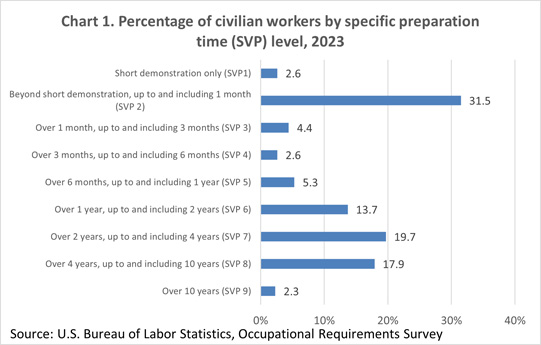
The various tangible or concrete hazards or difficulties that are in the vicinity of where jobs’ critical tasks are performed.
In 2023, 94.5 percent of civilian workers were not exposed to extreme cold, and 95.6 percent were not exposed to extreme heat. Wetness was not present for 66.8 percent, 97.9 percent were not exposed to heavy vibrations, and 67.0 percent were not exposed to the outdoors.
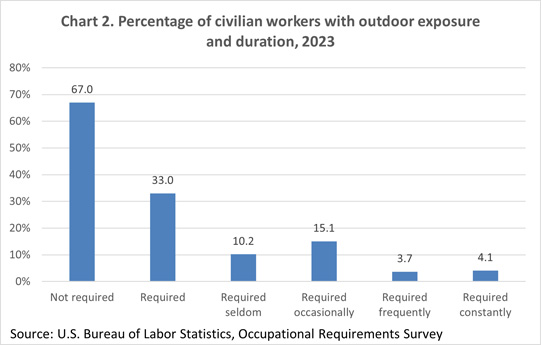
Refer to the physical activities required to perform tasks in jobs. The presence and, in some cases, duration of these activities are published.
In 2023, reaching at or below the shoulder was required for 75.9 percent of civilian workers and was not required for 24.1 percent.
Performing work in low postures was required for 56.8 percent of civilian workers and was not required for 43.2 percent.
The choice to sit or stand when performing critical tasks was available to 42.3 percent of civilian workers. On average, workers spent 43.7 percent of the workday sitting and 56.3 percent of the workday standing.
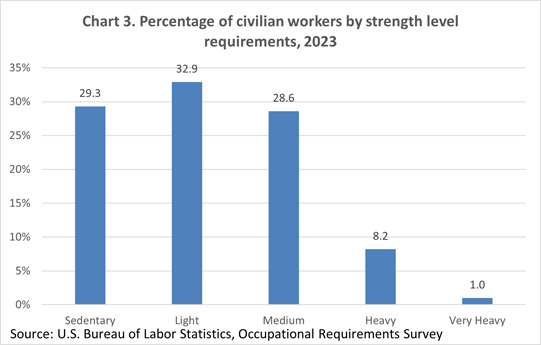
| Requirement | Yes | No |
|---|---|---|
|
Choice of sitting or standing |
42.3 | 57.7 |
|
Driving |
25.8 | 74.2 |
|
Climbing structure-related ramps or stairs |
20.3 | 79.7 |
|
Source: U.S. Bureau of Labor Statistics, Occupational Requirements Survey |
||

This occupational group includes architects, surveyors, cartographers, photogrammetrists, engineers, drafters, engineering technicians, electro-mechanical technicians, and mapping technicians.
The qualifications that workers need to use judgment, make decisions, interact with others, and adapt to changes in jobs.
In 2023, more than basic people skills were required for 92.4 percent of architecture and engineering workers, and basic people skills were required for 7.6 percent.
| Requirement | Yes | No |
|---|---|---|
|
Pace: Pause control |
95.1 | 4.9 |
|
Interaction with general public |
62.1 | 37.9 |
|
Working around crowds |
<0.5 | >99.5 |
|
Telework |
33.7 | 66.3 |
|
Work review: Supervising others |
16.1 | 83.9 |
|
Work review: Presence of supervisor |
66.4 | 33.6 |
|
Source: U.S. Bureau of Labor Statistics, Occupational Requirements Survey |
||
The minimum level of formal education required, credentials necessary, on-the-job training, and prior work experience necessary for average performance in jobs.
In 2023, credentials were required for 40.1 percent of architecture and engineering workers. Prior work experience was required for 68.0 percent and on-the-job training was required for 71.4 percent.
A bachelor's degree was required for 69.5 percent of architecture and engineering workers.
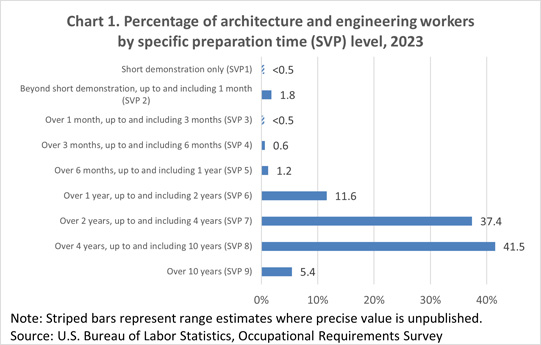
The various tangible or concrete hazards or difficulties that are in the vicinity of where jobs’ critical tasks are performed.
In 2023, 99.2 percent of architecture and engineering workers were not exposed to extreme cold, and 97.8 percent were not exposed to extreme heat. Wetness was not present for 94.5 percent, 97.6 percent were not exposed to heavy vibrations, and 68.2 percent were not exposed to the outdoors.
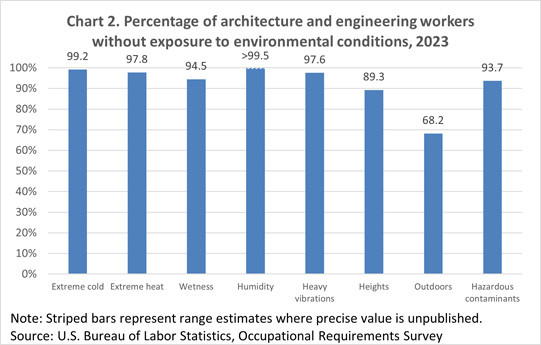
Refer to the physical activities required to perform tasks in jobs. The presence and, in some cases, duration of these activities are published.
In 2023, keyboarding was required for greater than 99.5 percent of architecture and engineering workers and was not required for less than 0.5 percent. For less than 5 percent of workers, keyboarding was seldom performed, for 27.2 percent keyboarding occurred occasionally, 64.5 percent frequently, and for 5.4 percent keyboarding occurred constantly.
Performing work in low postures was required for 29.0 percent of architecture and engineering workers and was not required for 71.0 percent.
The choice to sit or stand when performing critical tasks was available to 83.7 percent of architecture and engineering workers. On average, workers spent 73.6 percent of the workday sitting and 26.4 percent of the workday standing.
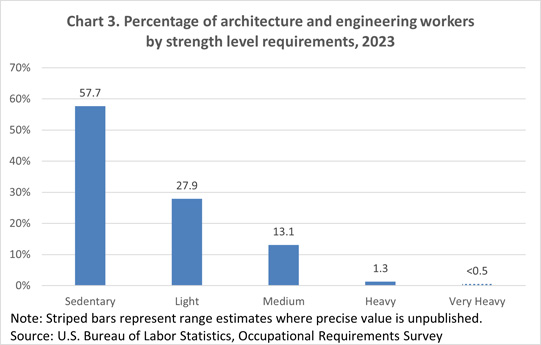
| Requirement | Yes | No |
|---|---|---|
|
Choice of sitting or standing |
83.7 | 16.3 |
|
Driving |
31.6 | 68.4 |
|
Climbing structure-related ramps or stairs |
22.8 | 77.2 |
|
Source: U.S. Bureau of Labor Statistics, Occupational Requirements Survey |
||

Perform engineering duties in planning, designing, and overseeing construction and maintenance of building structures and facilities, such as roads, railroads, airports, bridges, harbors, channels, dams, irrigation projects, pipelines, power plants, and water and sewage systems. Includes architectural, structural, traffic, and geotechnical engineers.
The qualifications that workers need to use judgment, make decisions, interact with others, and adapt to changes in jobs.
In 2023, work was controlled by people for 37.7 percent of civil engineers, and work was self-paced for 55.8 percent.
| Requirement | Yes | No |
|---|---|---|
|
Pace: Pause control |
>95 | <5 |
|
Interaction with general public |
84.0 | 16.0 |
|
Working around crowds |
<0.5 | >99.5 |
|
Telework |
36.2 | 63.8 |
|
Work review: Supervising others |
32.5 | 67.5 |
|
Work review: Presence of supervisor |
63.7 | 36.3 |
|
Source: U.S. Bureau of Labor Statistics, Occupational Requirements Survey |
||
The minimum level of formal education required, credentials necessary, on-the-job training, and prior work experience necessary for average performance in jobs.
In 2023, credentials were required for 78.9 percent of civil engineers. Prior work experience was required for 66.4 percent and on-the-job training was required for 60.8 percent.
A bachelor's degree was required for greater than 99.5 percent of civil engineers.
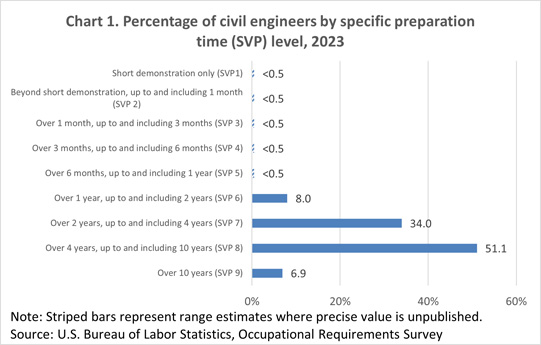
The various tangible or concrete hazards or difficulties that are in the vicinity of where jobs’ critical tasks are performed.
In 2023, greater than 99.5 percent of civil engineers were not exposed to extreme cold, and greater than 90 percent were not exposed to extreme heat. Wetness was not present for 91.5 percent, greater than 99.5 percent were not exposed to heavy vibrations, and 21.8 percent were not exposed to the outdoors.
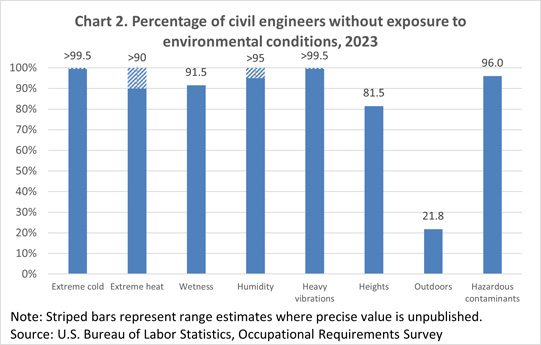
Refer to the physical activities required to perform tasks in jobs. The presence and, in some cases, duration of these activities are published.
In 2023, keyboarding was required for greater than 99.5 percent of civil engineers and was not required for less than 0.5 percent. For less than 0.5 percent of workers, keyboarding was seldom performed, for 39.3 percent keyboarding occurred occasionally, 58.4 percent frequently, and for less than 10 percent keyboarding occurred constantly.
Performing work in low postures was required for 34.1 percent of civil engineers and was not required for 65.9 percent.
The choice to sit or stand when performing critical tasks was available to 82.5 percent of civil engineers. On average, workers spent 78.9 percent of the workday sitting and 21.1 percent of the workday standing.
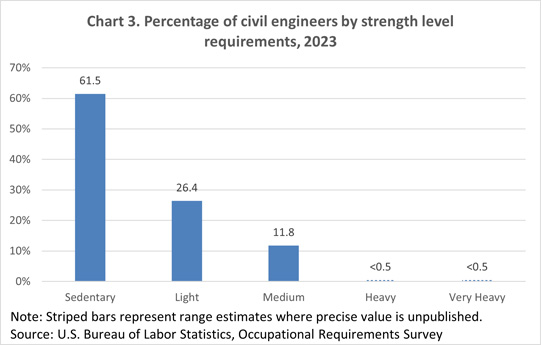
| Requirement | Yes | No |
|---|---|---|
|
Choice of sitting or standing |
82.5 | 17.5 |
|
Driving |
64.2 | 35.8 |
|
Climbing structure-related ramps or stairs |
31.3 | 68.7 |
|
Source: U.S. Bureau of Labor Statistics, Occupational Requirements Survey |
||

Design, develop, test, and evaluate integrated systems for managing industrial production processes, including human work factors, quality control, inventory control, logistics and material flow, cost analysis, and production coordination.
The qualifications that workers need to use judgment, make decisions, interact with others, and adapt to changes in jobs.
In 2023, more than basic people skills were required for 99.1 percent of industrial engineers, and basic people skills were required for 0.9 percent.
| Requirement | Yes | No |
|---|---|---|
|
Pace: Pause control |
>85 | <15 |
|
Interaction with general public |
59.3 | 40.7 |
|
Working around crowds |
<0.5 | >99.5 |
|
Telework |
11.9 | 88.1 |
|
Work review: Supervising others |
12.0 | 88.0 |
|
Work review: Presence of supervisor |
67.9 | 32.1 |
|
Source: U.S. Bureau of Labor Statistics, Occupational Requirements Survey |
||
The minimum level of formal education required, credentials necessary, on-the-job training, and prior work experience necessary for average performance in jobs.
In 2023, credentials were required for 10.1 percent of industrial engineers. Prior work experience was required for 66.3 percent and on-the-job training was required for 77.4 percent.
A bachelor's degree was required for 94.9 percent of industrial engineers.
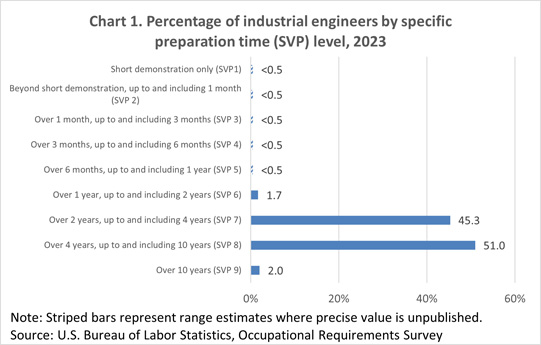
The various tangible or concrete hazards or difficulties that are in the vicinity of where jobs’ critical tasks are performed.
In 2023, 95.9 percent of industrial engineers were not exposed to extreme cold, and 98.3 percent were not exposed to extreme heat. Wetness was not present for 91.9 percent, greater than 99.5 percent were not exposed to heavy vibrations, and 97.2 percent were not exposed to the outdoors.
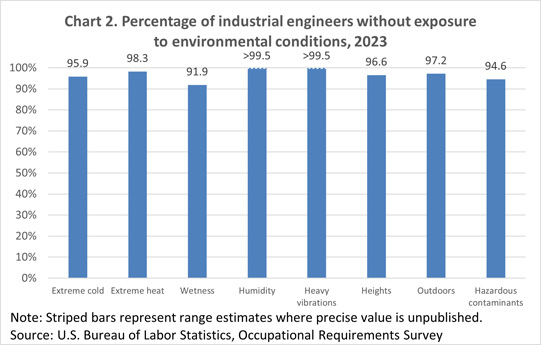
Refer to the physical activities required to perform tasks in jobs. The presence and, in some cases, duration of these activities are published.
In 2023, keyboarding was required for greater than 99.5 percent of industrial engineers and was not required for less than 0.5 percent. For less than 0.5 percent of workers, keyboarding was seldom performed, for 32.3 percent keyboarding occurred occasionally, 63.7 percent frequently, and for 3.8 percent keyboarding occurred constantly.
Performing work in low postures was required for 32.5 percent of industrial engineers and was not required for 67.5 percent.
The choice to sit or stand when performing critical tasks was available to 84.0 percent of industrial engineers. On average, workers spent 68.5 percent of the workday sitting and 31.5 percent of the workday standing.
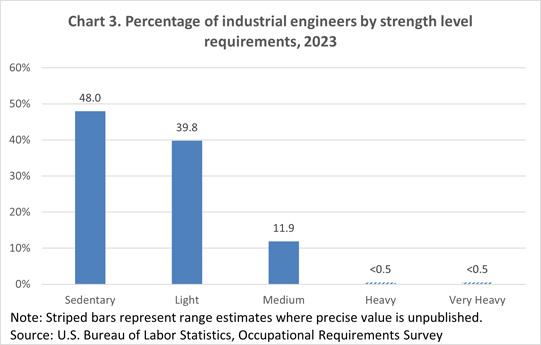
| Requirement | Yes | No |
|---|---|---|
|
Choice of sitting or standing |
84.0 | 16.0 |
|
Driving |
7.2 | 92.8 |
|
Climbing structure-related ramps or stairs |
19.9 | 80.1 |
|
Source: U.S. Bureau of Labor Statistics, Occupational Requirements Survey |
||
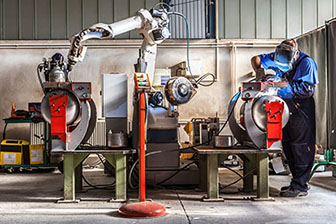
Perform engineering duties in planning and designing tools, engines, machines, and other mechanically functioning equipment. Oversee installation, operation, maintenance, and repair of equipment such as centralized heat, gas, water, and steam systems.
The qualifications that workers need to use judgment, make decisions, interact with others, and adapt to changes in jobs.
In 2023, work was controlled by people for 21.7 percent of mechanical engineers, and work was self-paced for 74.7 percent.
| Requirement | Yes | No |
|---|---|---|
|
Pace: Pause control |
98.9 | 1.1 |
|
Interaction with general public |
68.1 | 31.9 |
|
Working around crowds |
<0.5 | >99.5 |
|
Telework |
26.0 | 74.0 |
|
Work review: Supervising others |
8.8 | 91.2 |
|
Work review: Presence of supervisor |
75.7 | 24.3 |
|
Source: U.S. Bureau of Labor Statistics, Occupational Requirements Survey |
||
The minimum level of formal education required, credentials necessary, on-the-job training, and prior work experience necessary for average performance in jobs.
In 2023, credentials were required for 19.6 percent of mechanical engineers. Prior work experience was required for 54.7 percent and on-the-job training was required for 78.3 percent.
A bachelor's degree was required for 96.3 percent of mechanical engineers.
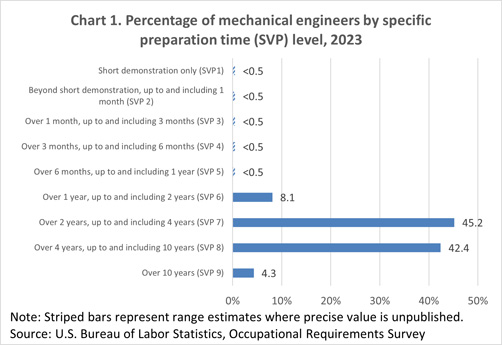
The various tangible or concrete hazards or difficulties that are in the vicinity of where jobs’ critical tasks are performed.
In 2023, greater than 95 percent of mechanical engineers were not exposed to extreme cold, and 99.4 percent were not exposed to extreme heat. Wetness was not present for 98.2 percent, greater than 75 percent were not exposed to heavy vibrations, and 91.4 percent were not exposed to the outdoors.
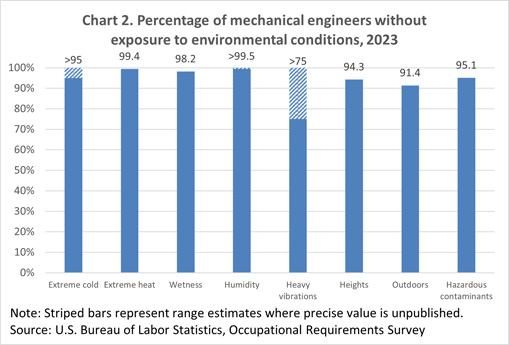
Refer to the physical activities required to perform tasks in jobs. The presence and, in some cases, duration of these activities are published.
In 2023, keyboarding was required for greater than 99.5 percent of mechanical engineers and was not required for less than 0.5 percent. For less than 0.5 percent of workers, keyboarding was seldom performed, for 23.7 percent keyboarding occurred occasionally, 75.9 percent frequently, and for less than 0.5 percent keyboarding occurred constantly.
Performing work in low postures was required for 14.6 percent of mechanical engineers and was not required for 85.4 percent.
The choice to sit or stand when performing critical tasks was available to 96.4 percent of mechanical engineers. On average, workers spent 80.5 percent of the workday sitting and 19.5 percent of the workday standing.
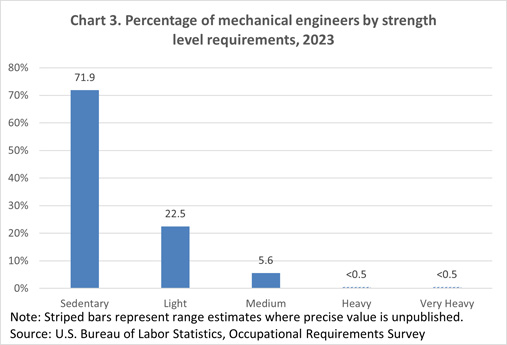
| Requirement | Yes | No |
|---|---|---|
|
Choice of sitting or standing |
96.4 | 3.6 |
|
Driving |
18.9 | 81.1 |
|
Climbing structure-related ramps or stairs |
33.8 | 66.2 |
|
Source: U.S. Bureau of Labor Statistics, Occupational Requirements Survey |
||

This occupational group includes art directors, artists, fashion designers, actors, producers, directors, coaches, dancers, choreographers, musicians, singers, radio announcers, writers, editors, interpreters, sound engineering technicians, photographers, and film editors.
The qualifications that workers need to use judgment, make decisions, interact with others, and adapt to changes in jobs.
In 2023, more than basic people skills were required for 85.2 percent of arts, design, entertainment, sports, and media workers, and basic people skills were required for 14.8 percent.
| Requirement | Yes | No |
|---|---|---|
|
Pace: Pause control |
74.3 | 25.7 |
|
Interaction with general public |
81.7 | 18.3 |
|
Working around crowds |
8.9 | 91.1 |
|
Telework |
26.3 | 73.7 |
|
Work review: Supervising others |
11.4 | 88.6 |
|
Work review: Presence of supervisor |
56.9 | 43.1 |
|
Source: U.S. Bureau of Labor Statistics, Occupational Requirements Survey |
||
The minimum level of formal education required, credentials necessary, on-the-job training, and prior work experience necessary for average performance in jobs.
In 2023, credentials were required for 35.8 percent of arts, design, entertainment, sports, and media workers. Prior work experience was required for 65.6 percent and on-the-job training was required for 68.7 percent.
A bachelor's degree was required for 42.9 percent of arts, design, entertainment, sports, and media workers.
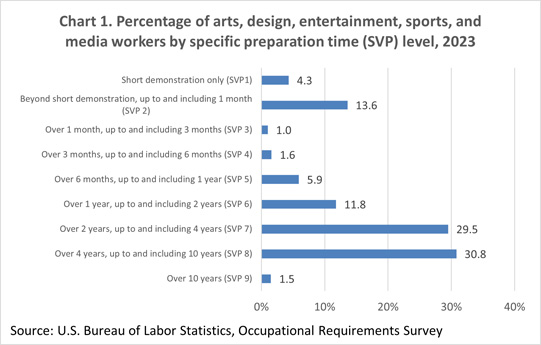
The various tangible or concrete hazards or difficulties that are in the vicinity of where jobs’ critical tasks are performed.
In 2023, greater than 95 percent of arts, design, entertainment, sports, and media workers were not exposed to extreme cold, and greater than 99.5 percent were not exposed to extreme heat. Wetness was not present for 91.2 percent, greater than 99.5 percent were not exposed to heavy vibrations, and 72.3 percent were not exposed to the outdoors.
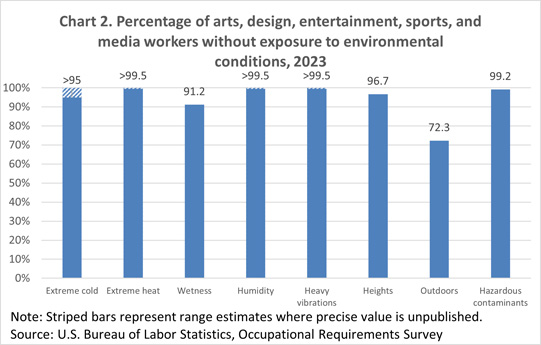
Refer to the physical activities required to perform tasks in jobs. The presence and, in some cases, duration of these activities are published.
In 2023, keyboarding was required for 88.5 percent of arts, design, entertainment, sports, and media workers and was not required for 11.5 percent. For 5.2 percent of workers, keyboarding was seldom performed, for 34.9 percent keyboarding occurred occasionally, 44.9 percent frequently, and for 3.6 percent keyboarding occurred constantly.
Performing work in low postures was required for 39.1 percent of arts, design, entertainment, sports, and media workers and was not required for 60.9 percent.
The choice to sit or stand when performing critical tasks was available to 70.2 percent of arts, design, entertainment, sports, and media workers. On average, workers spent 67.3 percent of the workday sitting and 32.7 percent of the workday standing.
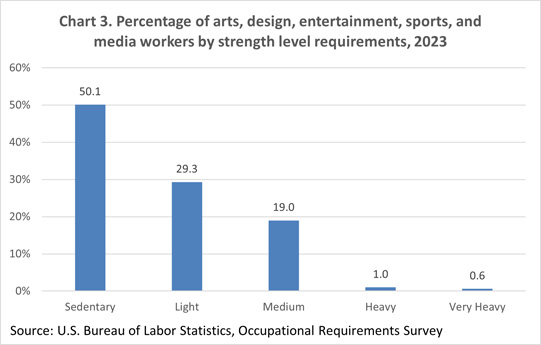
| Requirement | Yes | No |
|---|---|---|
|
Choice of sitting or standing |
70.2 | 29.8 |
|
Driving |
27.6 | 72.4 |
|
Climbing structure-related ramps or stairs |
19.0 | 81.0 |
|
Source: U.S. Bureau of Labor Statistics, Occupational Requirements Survey |
||

Plan, coordinate, or edit content of material for publication. May review proposals and drafts for possible publication. Includes technical editors.
The qualifications that workers need to use judgment, make decisions, interact with others, and adapt to changes in jobs.
In 2023, work was controlled by people for 28.0 percent of editors, and work was self-paced for 63.1 percent.
| Requirement | Yes | No |
|---|---|---|
|
Pace: Pause control |
97.5 | 2.5 |
|
Working around crowds |
3.2 | 96.8 |
|
Telework |
49.3 | 50.7 |
|
Work review: Supervising others |
36.2 | 63.8 |
|
Work review: Presence of supervisor |
61.1 | 38.9 |
|
Source: U.S. Bureau of Labor Statistics, Occupational Requirements Survey |
||
The minimum level of formal education required, credentials necessary, on-the-job training, and prior work experience necessary for average performance in jobs.
In 2023, credentials were required for 10.3 percent of editors. Prior work experience was required for 84.1 percent and on-the-job training was required for 46.2 percent.
A bachelor's degree was required for 83.2 percent of editors.
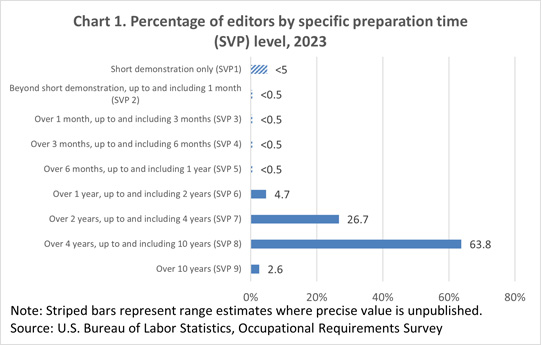
The various tangible or concrete hazards or difficulties that are in the vicinity of where jobs’ critical tasks are performed.
In 2023, greater than 99.5 percent of editors were not exposed to extreme cold, and greater than 99.5 percent were not exposed to extreme heat. Wetness was not present for greater than 99.5 percent, greater than 99.5 percent were not exposed to heavy vibrations, and 95.1 percent were not exposed to the outdoors.
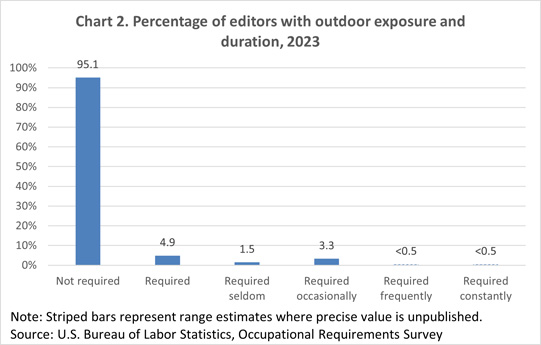
Refer to the physical activities required to perform tasks in jobs. The presence and, in some cases, duration of these activities are published.
In 2023, keyboarding was required for greater than 99.5 percent of editors and was not required for less than 0.5 percent. For less than 0.5 percent of workers, keyboarding was seldom performed, for 11.7 percent keyboarding occurred occasionally, 76.7 percent frequently, and for 11.6 percent keyboarding occurred constantly.
Performing work in low postures was required for 2.6 percent of editors and was not required for 97.4 percent.
The choice to sit or stand when performing critical tasks was available to 98.2 percent of editors. On average, workers spent 91.5 percent of the workday sitting and 8.5 percent of the workday standing.
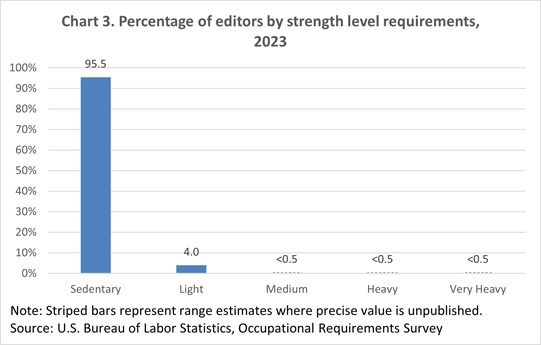
| Requirement | Yes | No |
|---|---|---|
|
Choice of sitting or standing |
98.2 | 1.8 |
|
Driving |
10.3 | 89.7 |
|
Climbing structure-related ramps or stairs |
5.9 | 94.1 |
|
Source: U.S. Bureau of Labor Statistics, Occupational Requirements Survey |
||

This occupational group includes janitors, maids and housekeeping cleaners, pest control, landscaping, pesticide handlers, tree trimmers, and grounds maintenance workers.
The qualifications that workers need to use judgment, make decisions, interact with others, and adapt to changes in jobs.
In 2023, more than basic people skills were required for 12.8 percent of building and grounds cleaning and maintenance workers, and basic people skills were required for 87.2 percent.
| Requirement | Yes | No |
|---|---|---|
|
Pace: Pause control |
73.7 | 26.3 |
|
Interaction with general public |
55.3 | 44.7 |
|
Working around crowds |
2.3 | 97.7 |
|
Telework |
<0.5 | >99.5 |
|
Work review: Supervising others |
8.9 | 91.1 |
|
Work review: Presence of supervisor |
44.7 | 55.3 |
|
Source: U.S. Bureau of Labor Statistics, Occupational Requirements Survey |
||
The minimum level of formal education required, credentials necessary, on-the-job training, and prior work experience necessary for average performance in jobs.
In 2023, credentials were required for 28.3 percent of building and grounds cleaning and maintenance workers. Prior work experience was required for 20.7 percent and on-the-job training was required for 90.6 percent.
No minimum education was required for 68.7 percent of building and grounds cleaning and maintenance workers and a high school diploma was required for 30.0 percent.
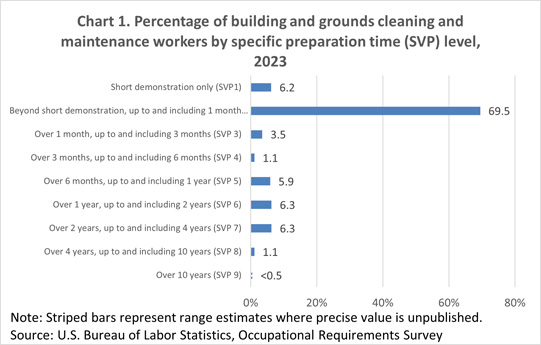
The various tangible or concrete hazards or difficulties that are in the vicinity of where jobs’ critical tasks are performed.
In 2023, greater than 99.5 percent of building and grounds cleaning and maintenance workers were not exposed to extreme cold, and 98.8 percent were not exposed to extreme heat. Wetness was not present for 22.6 percent, 92.8 percent were not exposed to heavy vibrations, and 26.2 percent were not exposed to the outdoors.
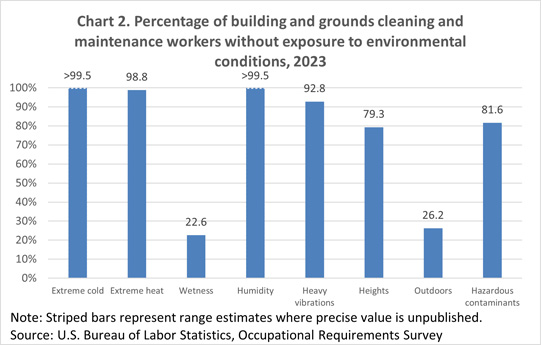
Refer to the physical activities required to perform tasks in jobs. The presence and, in some cases, duration of these activities are published.
In 2023, reaching at or below the shoulder was required for 98.0 percent of building and grounds cleaning and maintenance workers and was not required for 2.0 percent. For 7.4 percent of workers, reaching at or below the shoulder was seldom performed, for 54.3 percent reaching at or below the shoulder occurred occasionally, 33.1 percent frequently, and for 3.2 percent reaching at or below the shoulder occurred constantly.
Performing work in low postures was required for 97.8 percent of building and grounds cleaning and maintenance workers and was not required for 2.2 percent.
The choice to sit or stand when performing critical tasks was available to 7.7 percent of building and grounds cleaning and maintenance workers. On average, workers spent 11.8 percent of the workday sitting and 88.2 percent of the workday standing.
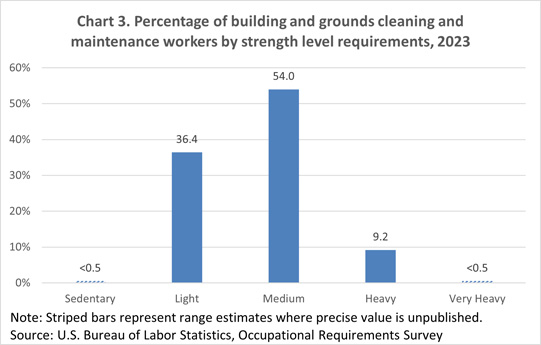
| Requirement | Yes | No |
|---|---|---|
|
Choice of sitting or standing |
7.7 | 92.3 |
|
Driving |
37.4 | 62.6 |
|
Climbing structure-related ramps or stairs |
38.1 | 61.9 |
|
Source: U.S. Bureau of Labor Statistics, Occupational Requirements Survey |
||

Perform any combination of light cleaning duties to maintain private households or commercial establishments, such as hotels and hospitals, in a clean and orderly manner. Duties may include making beds, replenishing linens, cleaning rooms and halls, and vacuuming.
The qualifications that workers need to use judgment, make decisions, interact with others, and adapt to changes in jobs.
In 2023, more than basic people skills were required for 2.3 percent of maids and housekeeping cleaners, and basic people skills were required for 97.7 percent.
| Requirement | Yes | No |
|---|---|---|
|
Pace: Pause control |
75.2 | 24.8 |
|
Interaction with general public |
73.7 | 26.3 |
|
Working around crowds |
<5 | >95 |
|
Telework |
<0.5 | >99.5 |
|
Work review: Supervising others |
1.7 | 98.3 |
|
Work review: Presence of supervisor |
41.9 | 58.1 |
|
Source: U.S. Bureau of Labor Statistics, Occupational Requirements Survey |
||
The minimum level of formal education required, credentials necessary, on-the-job training, and prior work experience necessary for average performance in jobs.
In 2023, credentials were required for 7.1 percent of maids and housekeeping cleaners. Prior work experience was required for 7.2 percent and on-the-job training was required for 98.0 percent.
No minimum education was required for 69.6 percent of maids and housekeeping cleaners and a high school diploma was required for 30.4 percent.
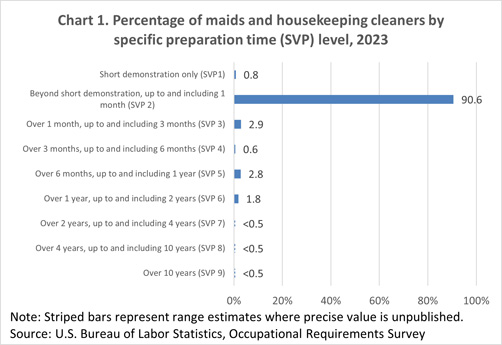
The various tangible or concrete hazards or difficulties that are in the vicinity of where jobs’ critical tasks are performed.
In 2023, greater than 99.5 percent of maids and housekeeping cleaners were not exposed to extreme cold, and greater than 99.5 percent were not exposed to extreme heat. Wetness was not present for 17.7 percent, greater than 99.5 percent were not exposed to heavy vibrations, and 63.8 percent were not exposed to the outdoors.
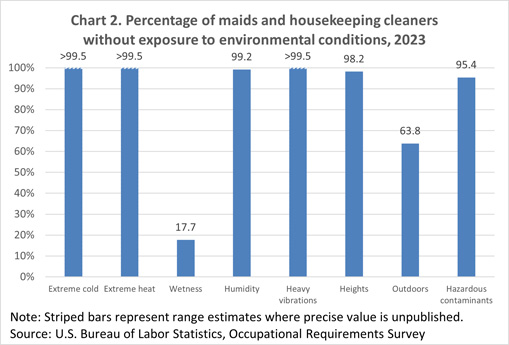
Refer to the physical activities required to perform tasks in jobs. The presence and, in some cases, duration of these activities are published.
In 2023, reaching at or below the shoulder was required for 98.8 percent of maids and housekeeping cleaners and was not required for 1.2 percent. For 6.4 percent of workers, reaching at or below the shoulder was seldom performed, for 52.7 percent reaching at or below the shoulder occurred occasionally, 35.5 percent frequently, and for 4.2 percent reaching at or below the shoulder occurred constantly.
Performing work in low postures was required for greater than 99.5 percent of maids and housekeeping cleaners and was not required for less than 0.5 percent.
The choice to sit or stand when performing critical tasks was available to 2.4 percent of maids and housekeeping cleaners. On average, workers spent 4.3 percent of the workday sitting and 95.7 percent of the workday standing.
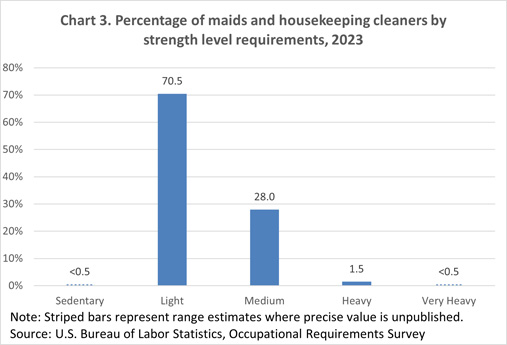
| Requirement | Yes | No |
|---|---|---|
|
Choice of sitting or standing |
2.4 | 97.6 |
|
Driving |
7.2 | 92.8 |
|
Climbing structure-related ramps or stairs |
32.7 | 67.3 |
|
Source: U.S. Bureau of Labor Statistics, Occupational Requirements Survey |
||

This occupational group includes purchasing agents, compliance officers, human resource workers, logisticians, fundraisers, market research analysts, accountants, auditors, credit counselors, and tax examiners.
The qualifications that workers need to use judgment, make decisions, interact with others, and adapt to changes in jobs.
In 2023, more than basic people skills were required for 98.1 percent of business and financial operations workers, and basic people skills were required for 1.9 percent.
| Requirement | Yes | No |
|---|---|---|
|
Pace: Pause control |
97.0 | 3.0 |
|
Interaction with general public |
83.0 | 17.0 |
|
Working around crowds |
1.4 | 98.6 |
|
Telework |
45.9 | 54.1 |
|
Work review: Supervising others |
18.2 | 81.8 |
|
Work review: Presence of supervisor |
58.8 | 41.2 |
|
Source: U.S. Bureau of Labor Statistics, Occupational Requirements Survey |
||
The minimum level of formal education required, credentials necessary, on-the-job training, and prior work experience necessary for average performance in jobs.
In 2023, credentials were required for 29.9 percent of business and financial operations workers. Prior work experience was required for 82.7 percent and on-the-job training was required for 69.4 percent.
A bachelor's degree was required for 69.9 percent of business and financial operations workers.
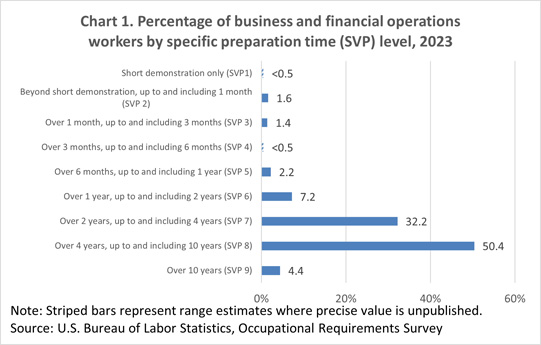
The various tangible or concrete hazards or difficulties that are in the vicinity of where jobs’ critical tasks are performed.
In 2023, greater than 99.5 percent of business and financial operations workers were not exposed to extreme cold, and greater than 99.5 percent were not exposed to extreme heat. Wetness was not present for 98.9 percent, greater than 99.5 percent were not exposed to heavy vibrations, and 90.9 percent were not exposed to the outdoors.
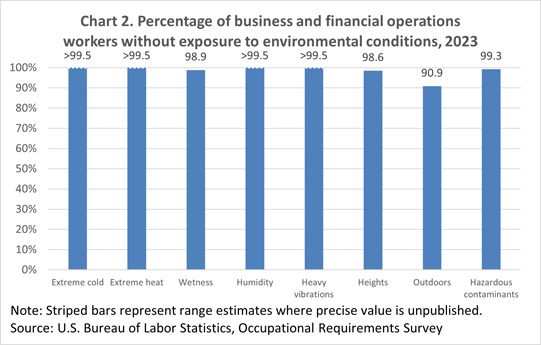
Refer to the physical activities required to perform tasks in jobs. The presence and, in some cases, duration of these activities are published.
In 2023, keyboarding was required for greater than 99.5 percent of business and financial operations workers and was not required for less than 0.5 percent. For less than 0.5 percent of workers, keyboarding was seldom performed, for 23.5 percent keyboarding occurred occasionally, 73.2 percent frequently, and for 3.2 percent keyboarding occurred constantly.
Performing work in low postures was required for 10.0 percent of business and financial operations workers and was not required for 90.0 percent.
The choice to sit or stand when performing critical tasks was available to 95.3 percent of business and financial operations workers. On average, workers spent 86.8 percent of the workday sitting and 13.2 percent of the workday standing.
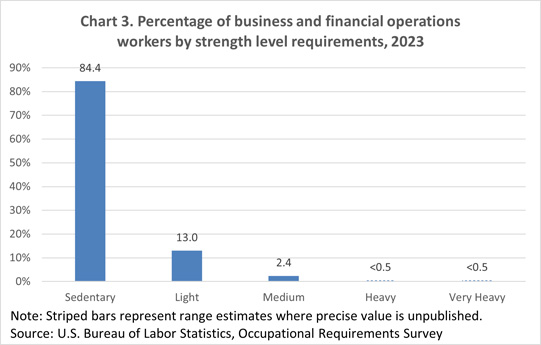
| Requirement | Yes | No |
|---|---|---|
|
Choice of sitting or standing |
95.3 | 4.7 |
|
Driving |
20.0 | 80.0 |
|
Climbing structure-related ramps or stairs |
10.8 | 89.2 |
|
Source: U.S. Bureau of Labor Statistics, Occupational Requirements Survey |
||

Examine, analyze, and interpret accounting records to prepare financial statements, give advice, or audit and evaluate statements prepared by others. Install or advise on systems of recording costs or other financial and budgetary data.
The qualifications that workers need to use judgment, make decisions, interact with others, and adapt to changes in jobs.
In 2023, more than basic people skills were required for 95.2 percent of accountants and auditors, and basic people skills were required for 4.8 percent.
| Requirement | Yes | No |
|---|---|---|
|
Pace: Pause control |
>99.5 | <0.5 |
|
Interaction with general public |
79.2 | 20.8 |
|
Working around crowds |
<0.5 | >99.5 |
|
Telework |
51.1 | 48.9 |
|
Work review: Supervising others |
17.5 | 82.5 |
|
Work review: Presence of supervisor |
71.1 | 28.9 |
|
Source: U.S. Bureau of Labor Statistics, Occupational Requirements Survey |
||
The minimum level of formal education required, credentials necessary, on-the-job training, and prior work experience necessary for average performance in jobs.
In 2023, credentials were required for 29.4 percent of accountants and auditors. Prior work experience was required for 75.9 percent and on-the-job training was required for 70.4 percent.
A bachelor's degree was required for 93.1 percent of accountants and auditors.
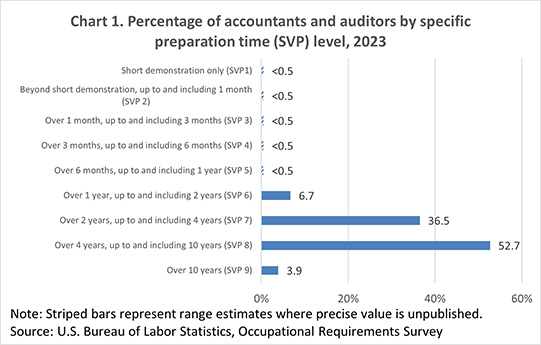
The various tangible or concrete hazards or difficulties that are in the vicinity of where jobs’ critical tasks are performed.
In 2023, greater than 99.5 percent of accountants and auditors were not exposed to extreme cold, and greater than 99.5 percent were not exposed to extreme heat. Wetness was not present for greater than 99.5 percent, greater than 99.5 percent were not exposed to heavy vibrations, and 99.2 percent were not exposed to the outdoors.
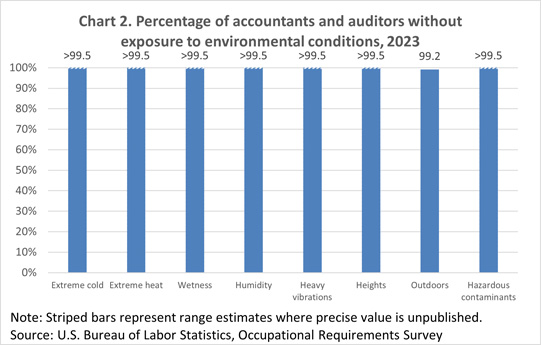
Refer to the physical activities required to perform tasks in jobs. The presence and, in some cases, duration of these activities are published.
In 2023, keyboarding was required for greater than 99.5 percent of accountants and auditors and was not required for less than 0.5 percent. For less than 0.5 percent of workers, keyboarding was seldom performed, for 13.4 percent keyboarding occurred occasionally, 80.2 percent frequently, and for 6.4 percent keyboarding occurred constantly.
Performing work in low postures was required for 11.0 percent of accountants and auditors and was not required for 89.0 percent.
The choice to sit or stand when performing critical tasks was available to greater than 99.5 percent of accountants and auditors. On average, workers spent 91.8 percent of the workday sitting and 8.2 percent of the workday standing.
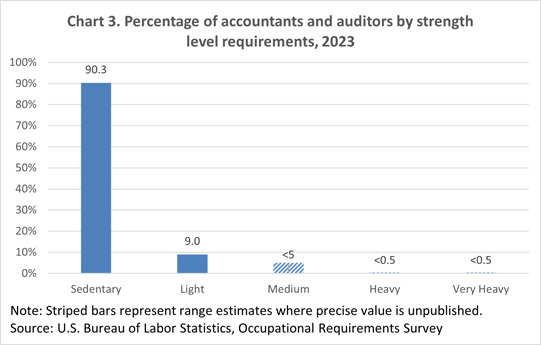
| Requirement | Yes | No |
|---|---|---|
|
Choice of sitting or standing |
>99.5 | <0.5 |
|
Driving |
14.7 | 85.3 |
|
Climbing structure-related ramps or stairs |
8.4 | 91.6 |
|
Source: U.S. Bureau of Labor Statistics, Occupational Requirements Survey |
||

Perform activities in the human resource area. Includes employment specialists who screen, recruit, interview, and place workers.
The qualifications that workers need to use judgment, make decisions, interact with others, and adapt to changes in jobs.
In 2023, verbal interactions were required constantly (every few minutes) for less than 15 percent of human resources specialists, and were required not constantly, but more than once per hour for 78.9 percent.
| Requirement | Yes | No |
|---|---|---|
|
Pace: Pause control |
95.7 | 4.3 |
|
Interaction with general public |
90.7 | 9.3 |
|
Working around crowds |
<0.5 | >99.5 |
|
Telework |
36.9 | 63.1 |
|
Work review: Supervising others |
15.8 | 84.2 |
|
Work review: Presence of supervisor |
59.1 | 40.9 |
|
Source: U.S. Bureau of Labor Statistics, Occupational Requirements Survey |
||
The minimum level of formal education required, credentials necessary, on-the-job training, and prior work experience necessary for average performance in jobs.
In 2023, credentials were required for 16.1 percent of human resources specialists. Prior work experience was required for 88.6 percent and on-the-job training was required for 77.3 percent.
A high school diploma was required for 34.3 percent of human resources specialists and a bachelor's degree was required for 56.9 percent.
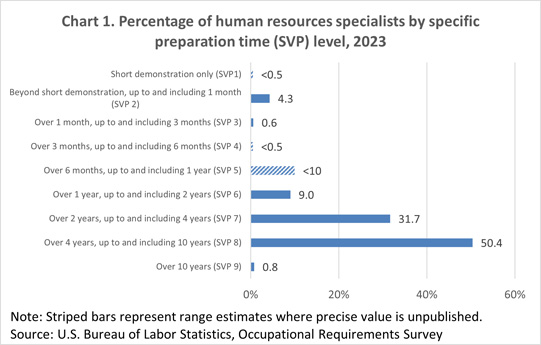
The various tangible or concrete hazards or difficulties that are in the vicinity of where jobs’ critical tasks are performed.
In 2023, greater than 99.5 percent of human resources specialists were not exposed to extreme cold, and greater than 99.5 percent were not exposed to extreme heat. Wetness was not present for 99.1 percent, greater than 99.5 percent were not exposed to heavy vibrations, and 98.4 percent were not exposed to the outdoors.
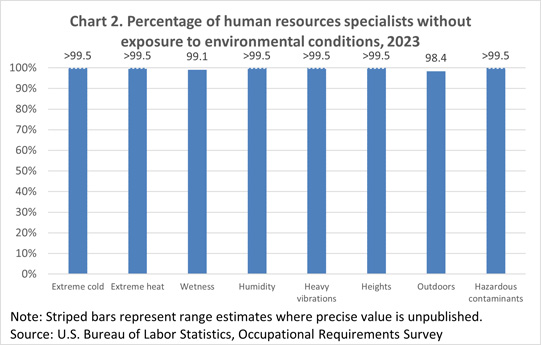
Refer to the physical activities required to perform tasks in jobs. The presence and, in some cases, duration of these activities are published.
In 2023, keyboarding was required for greater than 99.5 percent of human resources specialists and was not required for less than 0.5 percent. For less than 0.5 percent of workers, keyboarding was seldom performed, for 19.3 percent keyboarding occurred occasionally, 78.6 percent frequently, and for 1.7 percent keyboarding occurred constantly.
Performing work in low postures was required for 5.3 percent of human resources specialists and was not required for 94.7 percent.
The choice to sit or stand when performing critical tasks was available to 98.9 percent of human resources specialists. On average, workers spent 89.5 percent of the workday sitting and 10.5 percent of the workday standing.
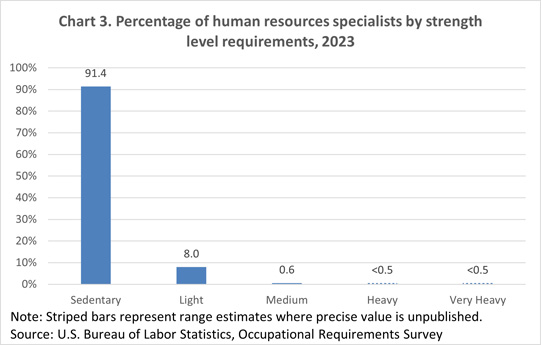
| Requirement | Yes | No |
|---|---|---|
|
Choice of sitting or standing |
98.9 | 1.1 |
|
Driving |
11.0 | 89.0 |
|
Climbing structure-related ramps or stairs |
9.9 | 90.1 |
|
Source: U.S. Bureau of Labor Statistics, Occupational Requirements Survey |
||

Coordinate activities of staff, convention personnel, or clients to make arrangements for group meetings, events, or conventions.
The qualifications that workers need to use judgment, make decisions, interact with others, and adapt to changes in jobs.
In 2023, verbal interactions were required constantly (every few minutes) for 14.6 percent of meeting, convention, and event planners, and were required not constantly, but more than once per hour for 71.1 percent.
| Requirement | Yes | No |
|---|---|---|
|
Pace: Pause control |
95.3 | 4.7 |
|
Interaction with general public |
>99.5 | <0.5 |
|
Working around crowds |
32.7 | 67.3 |
|
Telework |
33.7 | 66.3 |
|
Work review: Supervising others |
29.1 | 70.9 |
|
Work review: Presence of supervisor |
59.9 | 40.1 |
|
Source: U.S. Bureau of Labor Statistics, Occupational Requirements Survey |
||
The minimum level of formal education required, credentials necessary, on-the-job training, and prior work experience necessary for average performance in jobs.
In 2023, credentials were required for 44.0 percent of meeting, convention, and event planners. Prior work experience was required for 84.3 percent and on-the-job training was required for 70.7 percent.
A high school diploma was required for 34.5 percent of meeting, convention, and event planners and a bachelor's degree was required for 56.9 percent.
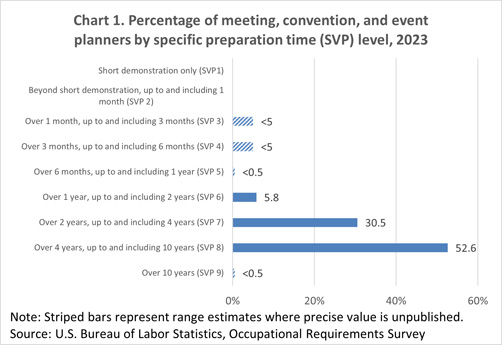
The various tangible or concrete hazards or difficulties that are in the vicinity of where jobs’ critical tasks are performed.
In 2023, greater than 99.5 percent of meeting, convention, and event planners were not exposed to extreme cold, and greater than 99.5 percent were not exposed to extreme heat. Wetness was not present for 99.3 percent, greater than 99.5 percent were not exposed to heavy vibrations, and 48.9 percent were not exposed to the outdoors.
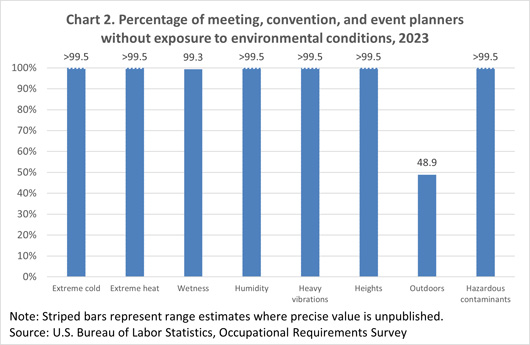
Refer to the physical activities required to perform tasks in jobs. The presence and, in some cases, duration of these activities are published.
In 2023, keyboarding was required for greater than 99.5 percent of meeting, convention, and event planners and was not required for less than 0.5 percent.
Performing work in low postures was required for 37.5 percent of meeting, convention, and event planners and was not required for 62.5 percent.
The choice to sit or stand when performing critical tasks was available to 64.0 percent of meeting, convention, and event planners. On average, workers spent 68.1 percent of the workday sitting and 31.9 percent of the workday standing.
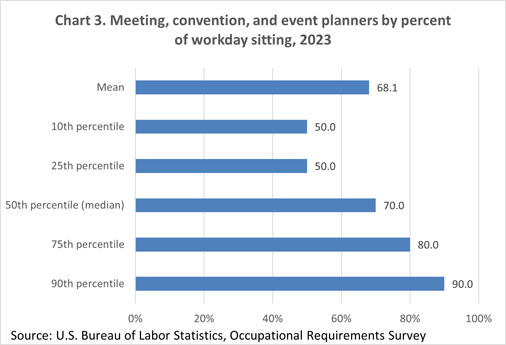
| Requirement | Yes | No |
|---|---|---|
|
Choice of sitting or standing |
64.0 | 36.0 |
|
Driving |
39.2 | 60.8 |
|
Climbing structure-related ramps or stairs |
17.2 | 82.8 |
|
Source: U.S. Bureau of Labor Statistics, Occupational Requirements Survey |
||

Promote health within a community by assisting individuals to adopt healthy behaviors. Serve as an advocate for the health needs of individuals by assisting community residents in effectively communicating with healthcare providers or social service agencies. Act as liaison or advocate and implement programs that promote, maintain, and improve individual and overall community health. May deliver health-related preventive services such as blood pressure, glaucoma, and hearing screenings. May collect data to help identify community health needs.
The qualifications that workers need to use judgment, make decisions, interact with others, and adapt to changes in jobs.
In 2023, more than basic people skills were required for greater than 90 percent of community health workers, and basic people skills were required for less than 10 percent.
| Requirement | Yes | No |
|---|---|---|
|
Pace: Pause control |
88.1 | 11.9 |
|
Interaction with general public |
>99.5 | <0.5 |
|
Working around crowds |
3.6 | 96.4 |
|
Telework |
26.9 | 73.1 |
|
Work review: Supervising others |
4.6 | 95.4 |
|
Work review: Presence of supervisor |
18.0 | 82.0 |
|
Source: U.S. Bureau of Labor Statistics, Occupational Requirements Survey |
||
The minimum level of formal education required, credentials necessary, on-the-job training, and prior work experience necessary for average performance in jobs.
In 2023, credentials were required for 83.2 percent of community health workers. Prior work experience was required for 71.9 percent and on-the-job training was required for 69.2 percent.
A high school diploma was required for 52.3 percent of community health workers.
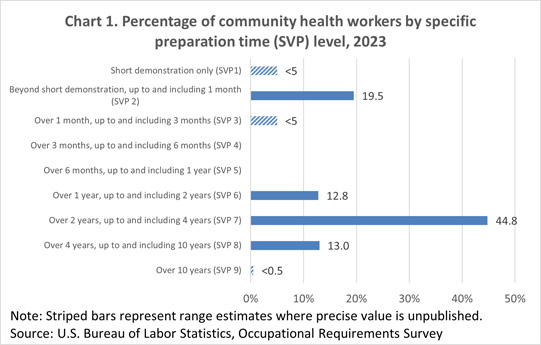
The various tangible or concrete hazards or difficulties that are in the vicinity of where jobs’ critical tasks are performed.
In 2023, greater than 99.5 percent of community health workers were not exposed to extreme cold, and greater than 99.5 percent were not exposed to extreme heat. Wetness was not present for 88.7 percent, greater than 99.5 percent were not exposed to heavy vibrations, and 64.2 percent were not exposed to the outdoors.
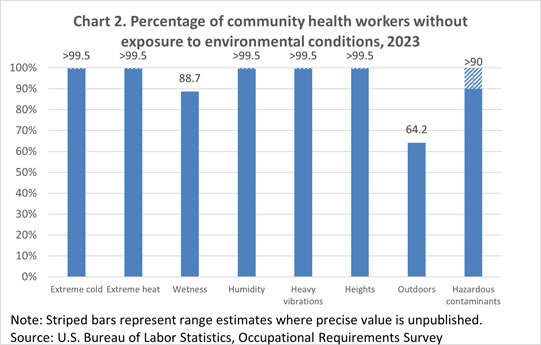
Refer to the physical activities required to perform tasks in jobs. The presence and, in some cases, duration of these activities are published.
In 2023, keyboarding was required for greater than 99.5 percent of community health workers and was not required for less than 0.5 percent.
Performing work in low postures was required for 34.4 percent of community health workers and was not required for 65.6 percent.
The choice to sit or stand when performing critical tasks was available to 91.0 percent of community health workers.
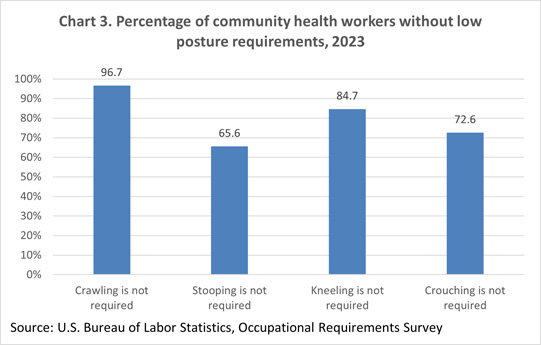
| Requirement | Yes | No |
|---|---|---|
|
Choice of sitting or standing |
91.0 | 9.0 |
|
Driving |
71.7 | 28.3 |
|
Climbing structure-related ramps or stairs |
21.4 | 78.6 |
|
Source: U.S. Bureau of Labor Statistics, Occupational Requirements Survey |
||

Counsel with emphasis on prevention. Work with individuals and groups to promote optimum mental and emotional health. May help individuals deal with issues associated with addictions and substance abuse; family, parenting, and marital problems; stress management; self-esteem; and aging.
In 2023, verbal interactions were required constantly (every few minutes) for 31.6 percent of mental health counselors, and were required not constantly, but more than once per hour for 44.5 percent.
| Requirement | Yes | No |
|---|---|---|
|
Pace: Pause control |
72.4 | 27.6 |
|
Interaction with general public |
>99.5 | <0.5 |
|
Working around crowds |
<0.5 | >99.5 |
|
Telework |
23.6 | 76.4 |
|
Work review: Supervising others |
10.1 | 89.9 |
|
Work review: Presence of supervisor |
20.5 | 79.5 |
|
Source: U.S. Bureau of Labor Statistics, Occupational Requirements Survey |
||
The minimum level of formal education required, credentials necessary, on-the-job training, and prior work experience necessary for average performance in jobs.
In 2023, credentials were required for 84.2 percent of mental health counselors. Prior work experience was required for 34.4 percent and on-the-job training was required for 77.6 percent.
A master's degree was required for 85.0 percent of mental health counselors.
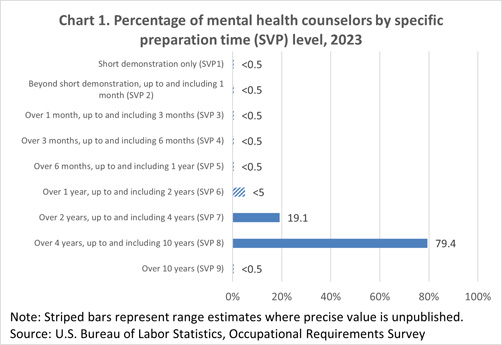
The various tangible or concrete hazards or difficulties that are in the vicinity of where jobs’ critical tasks are performed.
In 2023, greater than 99.5 percent of mental health counselors were not exposed to extreme cold, and greater than 99.5 percent were not exposed to extreme heat. Wetness was not present for greater than 90 percent, greater than 99.5 percent were not exposed to heavy vibrations, and 89.7 percent were not exposed to the outdoors.
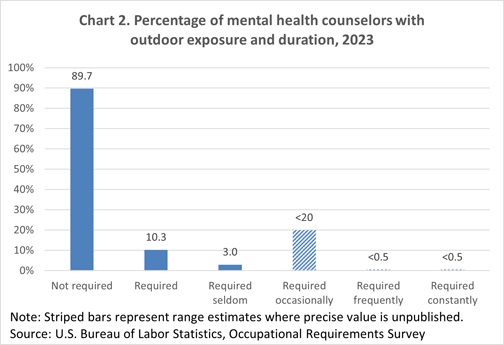
Refer to the physical activities required to perform tasks in jobs. The presence and, in some cases, duration of these activities are published.
In 2023, keyboarding was required for greater than 99.5 percent of mental health counselors and was not required for less than 0.5 percent. For less than 0.5 percent of workers, keyboarding was seldom performed, for 76.0 percent keyboarding occurred occasionally, 24.0 percent frequently, and for less than 0.5 percent keyboarding occurred constantly.
Performing work in low postures was required for 12.2 percent of mental health counselors and was not required for 87.8 percent.
The choice to sit or stand when performing critical tasks was available to 88.7 percent of mental health counselors. On average, workers spent 85.3 percent of the workday sitting and 14.7 percent of the workday standing.
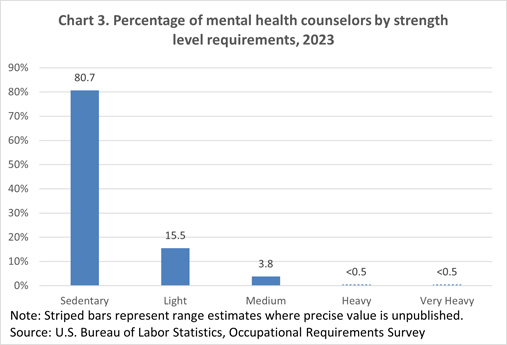
| Requirement | Yes | No |
|---|---|---|
|
Choice of sitting or standing |
88.7 | 11.3 |
|
Driving |
32.7 | 67.3 |
|
Climbing structure-related ramps or stairs |
16.5 | 83.5 |
|
Source: U.S. Bureau of Labor Statistics, Occupational Requirements Survey |
||

This occupational group includes computer and information analysts, software developers and programmers, database and systems administrators, computer support specialists, actuaries, mathematicians, statisticians, operations research analysts, and mathematical technicians.
The qualifications that workers need to use judgment, make decisions, interact with others, and adapt to changes in jobs.
In 2023, more than basic people skills were required for 96.1 percent of computer and mathematical workers, and basic people skills were required for 3.9 percent.
| Requirement | Yes | No |
|---|---|---|
|
Pace: Pause control |
96.0 | 4.0 |
|
Interaction with general public |
52.7 | 47.3 |
|
Working around crowds |
<0.5 | >99.5 |
|
Telework |
53.5 | 46.5 |
|
Work review: Supervising others |
12.5 | 87.5 |
|
Work review: Presence of supervisor |
52.5 | 47.5 |
|
Source: U.S. Bureau of Labor Statistics, Occupational Requirements Survey |
||
The minimum level of formal education required, credentials necessary, on-the-job training, and prior work experience necessary for average performance in jobs.
In 2023, credentials were required for 15.2 percent of computer and mathematical workers. Prior work experience was required for 82.9 percent and on-the-job training was required for 62.1 percent.
A bachelor's degree was required for 65.5 percent of computer and mathematical workers.
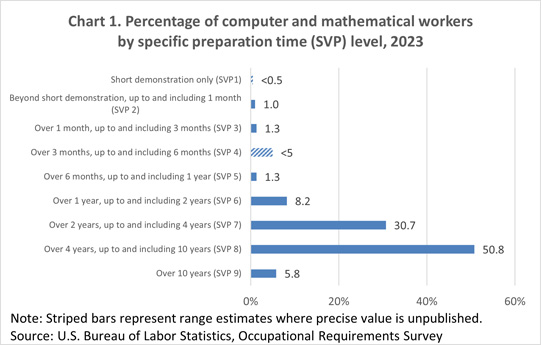
The various tangible or concrete hazards or difficulties that are in the vicinity of where jobs’ critical tasks are performed.
In 2023, greater than 99.5 percent of computer and mathematical workers were not exposed to extreme cold, and greater than 99.5 percent were not exposed to extreme heat. Wetness was not present for greater than 99.5 percent, greater than 99.5 percent were not exposed to heavy vibrations, and 98.4 percent were not exposed to the outdoors.
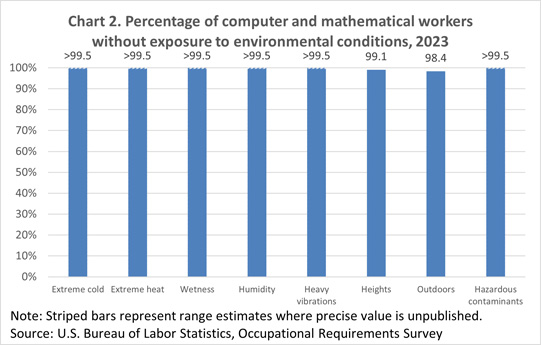
Refer to the physical activities required to perform tasks in jobs. The presence and, in some cases, duration of these activities are published.
In 2023, keyboarding was required for greater than 99.5 percent of computer and mathematical workers and was not required for less than 0.5 percent. For less than 0.5 percent of workers, keyboarding was seldom performed, for 8.1 percent keyboarding occurred occasionally, 71.7 percent frequently, and for 20.1 percent keyboarding occurred constantly.
Performing work in low postures was required for 19.9 percent of computer and mathematical workers and was not required for 80.1 percent.
The choice to sit or stand when performing critical tasks was available to 93.0 percent of computer and mathematical workers. On average, workers spent 88.9 percent of the workday sitting and 11.1 percent of the workday standing.
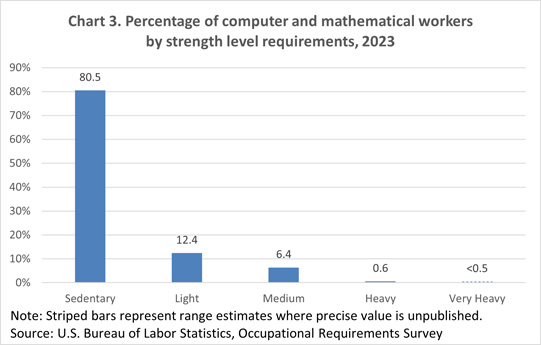
| Requirement | Yes | No |
|---|---|---|
|
Choice of sitting or standing |
93.0 | 7.0 |
|
Driving |
8.5 | 91.5 |
|
Climbing structure-related ramps or stairs |
5.3 | 94.7 |
|
Source: U.S. Bureau of Labor Statistics, Occupational Requirements Survey |
||

Provide technical assistance to computer users. Answer questions or resolve computer problems for clients in person, via telephone, or electronically. May provide assistance concerning the use of computer hardware and software, including printing, installation, word processing, electronic mail, and operating systems.
The qualifications that workers need to use judgment, make decisions, interact with others, and adapt to changes in jobs.
In 2023, more than basic people skills were required for 94.8 percent of computer user support specialists, and basic people skills were required for 5.2 percent.
| Requirement | Yes | No |
|---|---|---|
|
Pace: Pause control |
84.1 | 15.9 |
|
Interaction with general public |
65.5 | 34.5 |
|
Working around crowds |
<0.5 | >99.5 |
|
Telework |
36.9 | 63.1 |
|
Work review: Supervising others |
2.6 | 97.4 |
|
Work review: Presence of supervisor |
56.6 | 43.4 |
|
Source: U.S. Bureau of Labor Statistics, Occupational Requirements Survey |
||
The minimum level of formal education required, credentials necessary, on-the-job training, and prior work experience necessary for average performance in jobs.
In 2023, credentials were required for 29.7 percent of computer user support specialists. Prior work experience was required for 70.2 percent and on-the-job training was required for 80.9 percent.
A high school diploma was required for 44.5 percent of computer user support specialists.
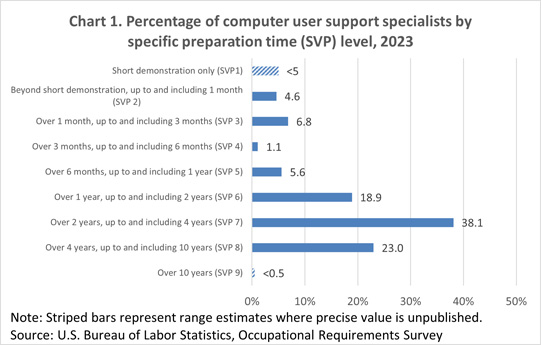
The various tangible or concrete hazards or difficulties that are in the vicinity of where jobs’ critical tasks are performed.
In 2023, greater than 99.5 percent of computer user support specialists were not exposed to extreme cold, and greater than 99.5 percent were not exposed to extreme heat. Wetness was not present for greater than 99.5 percent, greater than 99.5 percent were not exposed to heavy vibrations, and 97.3 percent were not exposed to the outdoors.
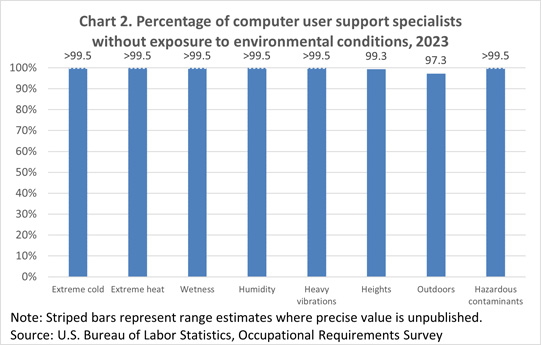
Refer to the physical activities required to perform tasks in jobs. The presence and, in some cases, duration of these activities are published.
In 2023, keyboarding was required for greater than 99.5 percent of computer user support specialists and was not required for less than 0.5 percent. For less than 0.5 percent of workers, keyboarding was seldom performed, for 15.6 percent keyboarding occurred occasionally, 72.6 percent frequently, and for 11.8 percent keyboarding occurred constantly.
Performing work in low postures was required for 50.4 percent of computer user support specialists and was not required for 49.6 percent.
The choice to sit or stand when performing critical tasks was available to 78.4 percent of computer user support specialists. On average, workers spent 81.8 percent of the workday sitting and 18.2 percent of the workday standing.
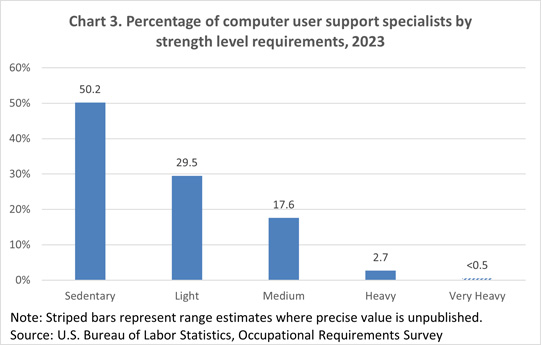
| Requirement | Yes | No |
|---|---|---|
|
Choice of sitting or standing |
78.4 | 21.6 |
|
Driving |
21.9 | 78.1 |
|
Climbing structure-related ramps or stairs |
13.4 | 86.6 |
|
Source: U.S. Bureau of Labor Statistics, Occupational Requirements Survey |
||

This occupational group includes carpenters, laborers, equipment operators, electricians, roofers, elevator installers and repairers, earth drillers, mining machine operators, and carpet, floor, and tile installers and finishers.
The qualifications that workers need to use judgment, make decisions, interact with others, and adapt to changes in jobs.
In 2023, work was reviewed by a supervisor more than once per day for 49.9 percent of construction and extraction workers, and once per day for 27.9 percent.
| Requirement | Yes | No |
|---|---|---|
|
Pace: Pause control |
61.5 | 38.5 |
|
Interaction with general public |
47.8 | 52.2 |
|
Working around crowds |
<0.5 | >99.5 |
|
Telework |
<0.5 | >99.5 |
|
Work review: Supervising others |
19.1 | 80.9 |
|
Work review: Presence of supervisor |
65.3 | 34.7 |
|
Source: U.S. Bureau of Labor Statistics, Occupational Requirements Survey |
||
The minimum level of formal education required, credentials necessary, on-the-job training, and prior work experience necessary for average performance in jobs.
In 2023, credentials were required for 61.3 percent of construction and extraction workers. Prior work experience was required for 51.3 percent and on-the-job training was required for 64.4 percent.
No minimum education was required for 49.6 percent of construction and extraction workers and a high school diploma was required for 47.1 percent.
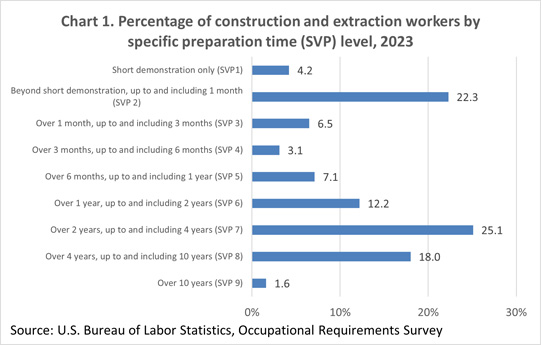
The various tangible or concrete hazards or difficulties that are in the vicinity of where jobs’ critical tasks are performed.
In 2023, 99.0 percent of construction and extraction workers were not exposed to extreme cold, and 93.8 percent were not exposed to extreme heat. Wetness was not present for 58.8 percent, 77.9 percent were not exposed to heavy vibrations, and 7.6 percent were not exposed to the outdoors.
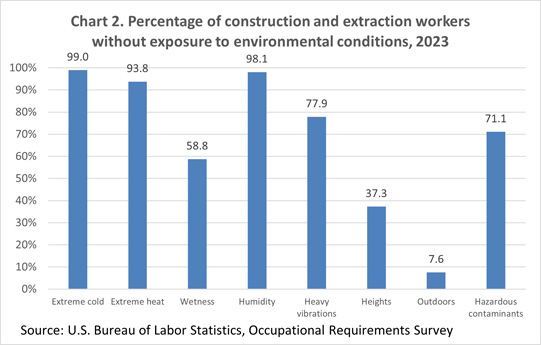
Refer to the physical activities required to perform tasks in jobs. The presence and, in some cases, duration of these activities are published.
In 2023, reaching at or below the shoulder was required for 95.5 percent of construction and extraction workers and was not required for 4.5 percent.
Performing work in low postures was required for 94.1 percent of construction and extraction workers and was not required for 5.9 percent. For 30.5 percent of workers, crouching was required to perform low work, and 34.2 percent were required to stoop.
The choice to sit or stand when performing critical tasks was available to 11.9 percent of construction and extraction workers. On average, workers spent 18.5 percent of the workday sitting and 81.5 percent of the workday standing.
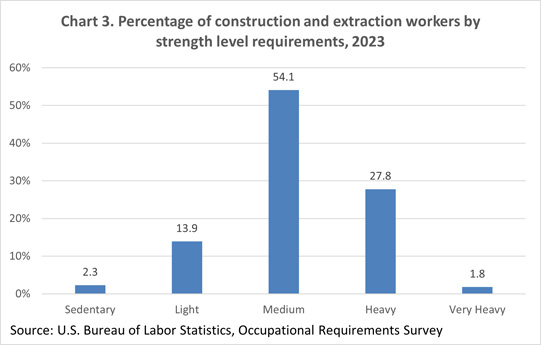
| Requirement | Yes | No |
|---|---|---|
|
Choice of sitting or standing |
11.9 | 88.1 |
|
Driving |
53.3 | 46.7 |
|
Climbing structure-related ramps or stairs |
58.8 | 41.2 |
|
Source: U.S. Bureau of Labor Statistics, Occupational Requirements Survey |
||

Perform tasks involving physical labor at construction sites. May operate hand and power tools of all types: air hammers, earth tampers, cement mixers, small mechanical hoists, surveying and measuring equipment, and a variety of other equipment and instruments. May clean and prepare sites, dig trenches, set braces to support the sides of excavations, erect scaffolding, and clean up rubble, debris and other waste materials. May assist other craft workers.
The qualifications that workers need to use judgment, make decisions, interact with others, and adapt to changes in jobs.
In 2023, more than basic people skills were required for 8.5 percent of construction laborers, and basic people skills were required for 91.5 percent.
| Requirement | Yes | No |
|---|---|---|
|
Pace: Pause control |
44.7 | 55.3 |
|
Interaction with general public |
28.0 | 72.0 |
|
Working around crowds |
<0.5 | >99.5 |
|
Telework |
<0.5 | >99.5 |
|
Work review: Supervising others |
2.2 | 97.8 |
|
Work review: Presence of supervisor |
85.8 | 14.2 |
|
Source: U.S. Bureau of Labor Statistics, Occupational Requirements Survey |
||
The minimum level of formal education required, credentials necessary, on-the-job training, and prior work experience necessary for average performance in jobs.
In 2023, credentials were required for 39.1 percent of construction laborers. Prior work experience was required for 29.4 percent and on-the-job training was required for 82.1 percent.
No minimum education was required for 70.0 percent of construction laborers and a high school diploma was required for 30.0 percent.
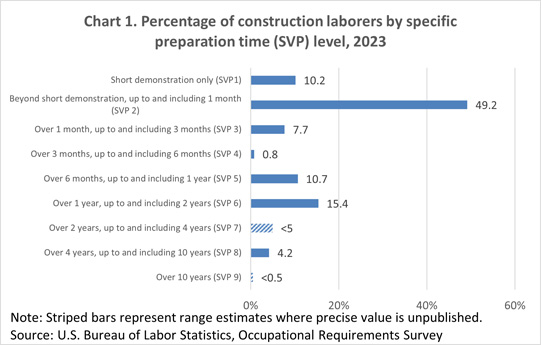
The various tangible or concrete hazards or difficulties that are in the vicinity of where jobs’ critical tasks are performed.
In 2023, greater than 99.5 percent of construction laborers were not exposed to extreme cold, and 94.4 percent were not exposed to extreme heat. Wetness was not present for 52.3 percent, 63.9 percent were not exposed to heavy vibrations, and less than 0.5 percent were not exposed to the outdoors.
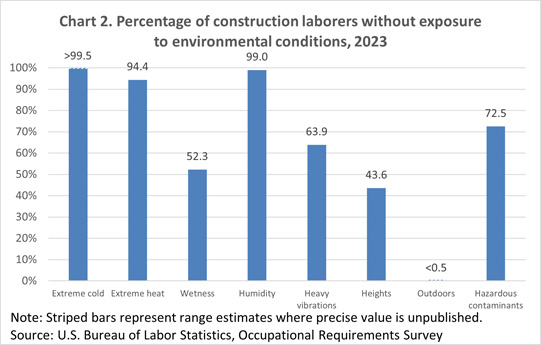
Refer to the physical activities required to perform tasks in jobs. The presence and, in some cases, duration of these activities are published.
In 2023, reaching at or below the shoulder was required for greater than 99.5 percent of construction laborers and was not required for less than 0.5 percent. For 2.5 percent of workers, reaching at or below the shoulder was seldom performed, for 57.9 percent reaching at or below the shoulder occurred occasionally, 38.1 percent frequently, and for less than 5 percent reaching at or below the shoulder occurred constantly.
Performing work in low postures was required for 98.5 percent of construction laborers and was not required for 1.5 percent. For 35.1 percent of workers, crouching was required to perform low work, 35.1 percent were required to crouch, 32.6 percent required kneeling, and stooping was required for 39.9 percent.
On average, construction laborers spent 7.5 percent of the workday sitting and 92.5 percent of the workday standing.
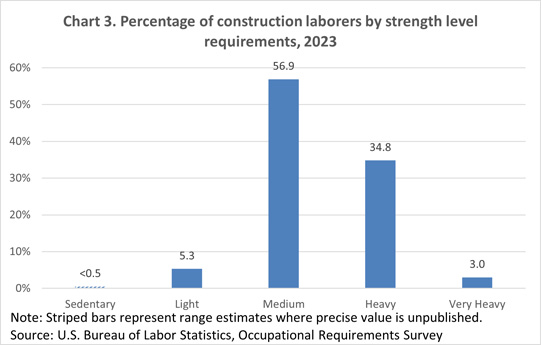
| Requirement | Yes | No |
|---|---|---|
|
Choice of sitting or standing |
<0.5 | >99.5 |
|
Driving |
34.9 | 65.1 |
|
Climbing structure-related ramps or stairs |
45.8 | 54.2 |
|
Source: U.S. Bureau of Labor Statistics, Occupational Requirements Survey |
||

This occupational group includes postsecondary teachers, preschool teachers, primary school teachers, middle school teachers, self-enrichment education teachers, special education school teachers, librarians, curators, archivists, home management advisors, instructional coordinators, and teacher assistants.
The qualifications that workers need to use judgment, make decisions, interact with others, and adapt to changes in jobs.
In 2023, more than basic people skills were required for 97.2 percent of educational instruction and library workers, and basic people skills were required for 2.8 percent.
| Requirement | Yes | No |
|---|---|---|
|
Pace: Pause control |
38.9 | 61.1 |
|
Interaction with general public |
98.7 | 1.3 |
|
Working around crowds |
5.7 | 94.3 |
|
Telework |
4.7 | 95.3 |
|
Work review: Supervising others |
9.7 | 90.3 |
|
Work review: Presence of supervisor |
38.2 | 61.8 |
|
Source: U.S. Bureau of Labor Statistics, Occupational Requirements Survey |
||
The minimum level of formal education required, credentials necessary, on-the-job training, and prior work experience necessary for average performance in jobs.
In 2023, credentials were required for 71.6 percent of educational instruction and library workers. Prior work experience was required for 26.7 percent and on-the-job training was required for 43.5 percent.
A bachelor's degree was required for 59.4 percent of educational instruction and library workers.
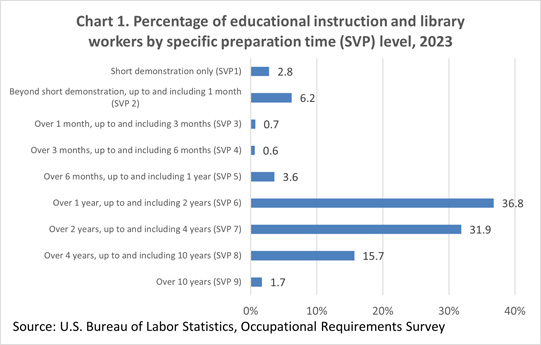
The various tangible or concrete hazards or difficulties that are in the vicinity of where jobs’ critical tasks are performed.
In 2023, greater than 99.5 percent of educational instruction and library workers were not exposed to extreme cold, and greater than 99.5 percent were not exposed to extreme heat. Wetness was not present for 82.4 percent, greater than 99.5 percent were not exposed to heavy vibrations, and 57.1 percent were not exposed to the outdoors.
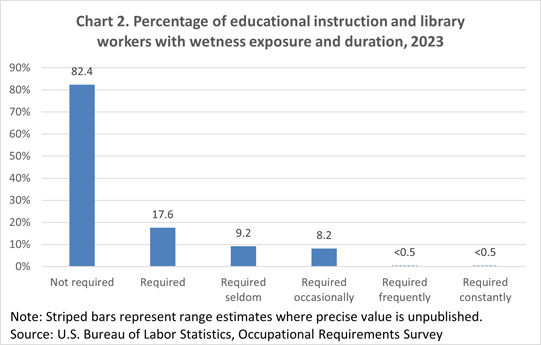
Refer to the physical activities required to perform tasks in jobs. The presence and, in some cases, duration of these activities are published.
In 2023, keyboarding was required for 94.3 percent of educational instruction and library workers and was not required for 5.7 percent. For 9.7 percent of workers, keyboarding was seldom performed, for 72.1 percent keyboarding occurred occasionally, 12.4 percent frequently, and for less than 0.5 percent keyboarding occurred constantly.
Performing work in low postures was required for 54.7 percent of educational instruction and library workers and was not required for 45.3 percent.
The choice to sit or stand when performing critical tasks was available to 66.2 percent of educational instruction and library workers. On average, workers spent 39.8 percent of the workday sitting and 60.2 percent of the workday standing.
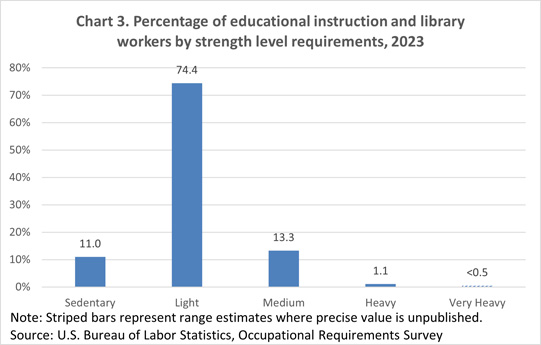
| Requirement | Yes | No |
|---|---|---|
|
Choice of sitting or standing |
66.2 | 33.8 |
|
Driving |
3.6 | 96.4 |
|
Climbing structure-related ramps or stairs |
18.1 | 81.9 |
|
Source: U.S. Bureau of Labor Statistics, Occupational Requirements Survey |
||

Administer and maintain libraries or collections of information, for public or private access through reference or borrowing. Work in a variety of settings, such as educational institutions, museums, and corporations, and with various types of informational materials, such as books, periodicals, recordings, films, and databases. Tasks may include acquiring, cataloging, and circulating library materials, and user services such as locating and organizing information, providing instruction on how to access information, and setting up and operating a library's media equipment.
The qualifications that workers need to use judgment, make decisions, interact with others, and adapt to changes in jobs.
In 2023, more than basic people skills were required for greater than 95 percent of librarians and media collections specialists, and basic people skills were required for less than 5 percent.
| Requirement | Yes | No |
|---|---|---|
|
Pace: Pause control |
76.2 | 23.8 |
|
Interaction with general public |
>99.5 | <0.5 |
|
Working around crowds |
4.1 | 95.9 |
|
Telework |
3.1 | 96.9 |
|
Work review: Supervising others |
41.2 | 58.8 |
|
Work review: Presence of supervisor |
51.4 | 48.6 |
|
Source: U.S. Bureau of Labor Statistics, Occupational Requirements Survey |
||
The minimum level of formal education required, credentials necessary, on-the-job training, and prior work experience necessary for average performance in jobs.
In 2023, credentials were required for 29.2 percent of librarians and media collections specialists. Prior work experience was required for 66.8 percent and on-the-job training was required for 54.9 percent.
A master's degree was required for 67.0 percent of librarians and media collections specialists.
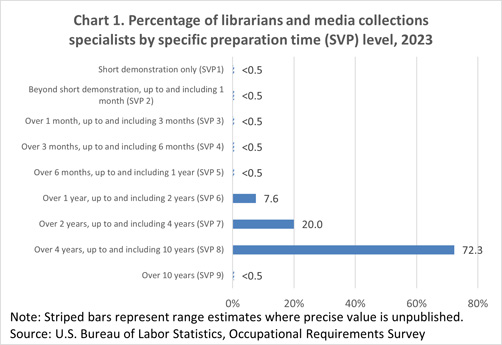
The various tangible or concrete hazards or difficulties that are in the vicinity of where jobs’ critical tasks are performed.
In 2023, greater than 99.5 percent of librarians and media collections specialists were not exposed to extreme cold, and greater than 99.5 percent were not exposed to extreme heat. Wetness was not present for greater than 99.5 percent, greater than 99.5 percent were not exposed to heavy vibrations, and 94.5 percent were not exposed to the outdoors.
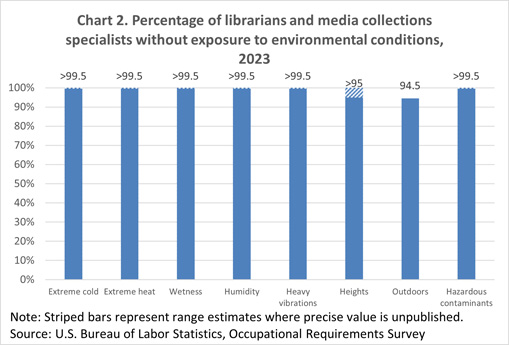
Refer to the physical activities required to perform tasks in jobs. The presence and, in some cases, duration of these activities are published.
In 2023, keyboarding was required for greater than 99.5 percent of librarians and media collections specialists and was not required for less than 0.5 percent. For less than 5 percent of workers, keyboarding was seldom performed, for 51.0 percent keyboarding occurred occasionally, 46.5 percent frequently, and for 1.2 percent keyboarding occurred constantly.
Performing work in low postures was required for 66.8 percent of librarians and media collections specialists and was not required for 33.2 percent.
The choice to sit or stand when performing critical tasks was available to 76.2 percent of librarians and media collections specialists. On average, workers spent 58.7 percent of the workday sitting and 41.3 percent of the workday standing.
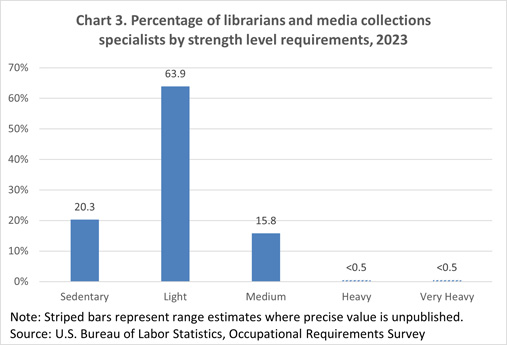
| Requirement | Yes | No |
|---|---|---|
|
Choice of sitting or standing |
76.2 | 23.8 |
|
Driving |
7.2 | 92.8 |
|
Climbing structure-related ramps or stairs |
17.3 | 82.7 |
|
Source: U.S. Bureau of Labor Statistics, Occupational Requirements Survey |
||

Assist librarians by helping readers in the use of library catalogs, databases, and indexes to locate books and other materials; and by answering questions that require only brief consultation of standard reference. Compile records; sort and shelve books or other media; remove or repair damaged books or other media; register patrons; and check materials in and out of the circulation process. Replace materials in shelving area (stacks) or files. Includes bookmobile drivers who assist with providing services in mobile libraries.
The qualifications that workers need to use judgment, make decisions, interact with others, and adapt to changes in jobs.
In 2023, more than basic people skills were required for 85.8 percent of library technicians, and basic people skills were required for 14.2 percent.
| Requirement | Yes | No |
|---|---|---|
|
Pace: Pause control |
74.9 | 25.1 |
|
Interaction with general public |
96.3 | 3.7 |
|
Working around crowds |
2.6 | 97.4 |
|
Telework |
<0.5 | >99.5 |
|
Work review: Supervising others |
12.1 | 87.9 |
|
Work review: Presence of supervisor |
72.9 | 27.1 |
|
Source: U.S. Bureau of Labor Statistics, Occupational Requirements Survey |
||
The minimum level of formal education required, credentials necessary, on-the-job training, and prior work experience necessary for average performance in jobs.
In 2023, credentials were required for 11.2 percent of library technicians. Prior work experience was required for 78.5 percent and on-the-job training was required for 81.9 percent.
A high school diploma was required for 66.7 percent of library technicians.
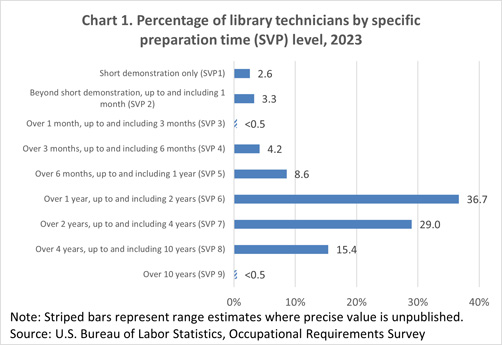
The various tangible or concrete hazards or difficulties that are in the vicinity of where jobs’ critical tasks are performed.
In 2023, greater than 99.5 percent of library technicians were not exposed to extreme cold, and greater than 99.5 percent were not exposed to extreme heat. Wetness was not present for greater than 99.5 percent, greater than 99.5 percent were not exposed to heavy vibrations, and 77.5 percent were not exposed to the outdoors.
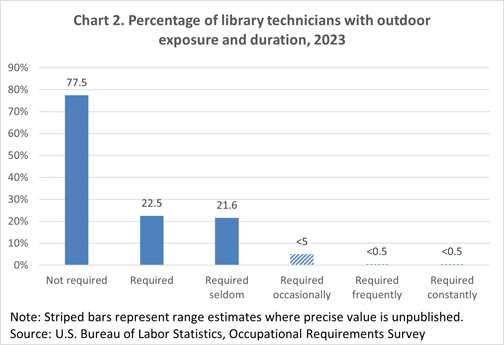
Refer to the physical activities required to perform tasks in jobs. The presence and, in some cases, duration of these activities are published.
In 2023, keyboarding was required for greater than 99.5 percent of library technicians and was not required for less than 0.5 percent. For less than 0.5 percent of workers, keyboarding was seldom performed, for 64.7 percent keyboarding occurred occasionally, 35.3 percent frequently, and for less than 0.5 percent keyboarding occurred constantly.
Performing work in low postures was required for 68.4 percent of library technicians and was not required for 31.6 percent.
The choice to sit or stand when performing critical tasks was available to 63.6 percent of library technicians. On average, workers spent 55.8 percent of the workday sitting and 44.2 percent of the workday standing.
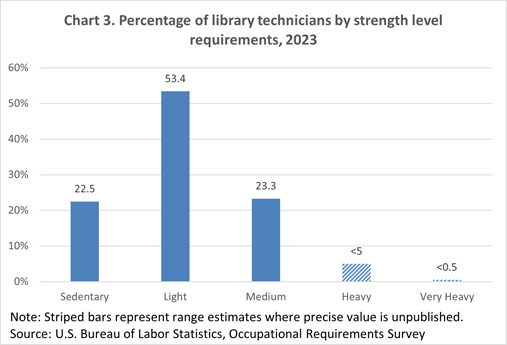
| Requirement | Yes | No |
|---|---|---|
|
Choice of sitting or standing |
63.6 | 36.4 |
|
Driving |
5.6 | 94.4 |
|
Climbing structure-related ramps or stairs |
10.9 | 89.1 |
|
Source: U.S. Bureau of Labor Statistics, Occupational Requirements Survey |
||

Teach students in one or more subjects, such as English, mathematics, or social studies at the secondary level in public or private schools. May be designated according to subject matter specialty.
The qualifications that workers need to use judgment, make decisions, interact with others, and adapt to changes in jobs.
In 2023, verbal interactions were required constantly (every few minutes) for 69.0 percent of secondary school teachers, except special and career or technical education, and were required not constantly, but more than once per hour for 31.0 percent.
| Requirement | Yes | No |
|---|---|---|
|
Pace: Pause control |
44.2 | 55.8 |
|
Interaction with general public |
>99.5 | <0.5 |
|
Working around crowds |
8.9 | 91.1 |
|
Telework |
0.5 | 99.5 |
|
Work review: Supervising others |
6.9 | 93.1 |
|
Work review: Presence of supervisor |
21.5 | 78.5 |
|
Source: U.S. Bureau of Labor Statistics, Occupational Requirements Survey |
||
The minimum level of formal education required, credentials necessary, on-the-job training, and prior work experience necessary for average performance in jobs.
In 2023, credentials were required for 98.9 percent of secondary school teachers, except special and career or technical education. Prior work experience was required for 5.7 percent and on-the-job training was required for 36.1 percent.
A bachelor's degree was required for 98.0 percent of secondary school teachers, except special and career or technical education.
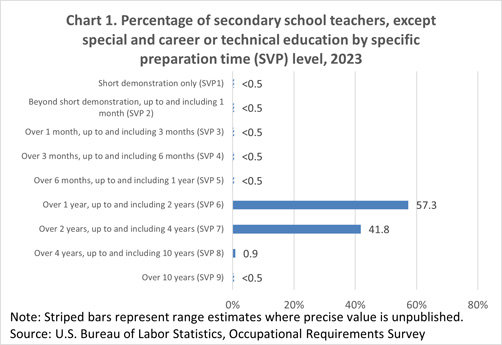
The various tangible or concrete hazards or difficulties that are in the vicinity of where jobs’ critical tasks are performed.
In 2023, greater than 99.5 percent of secondary school teachers, except special and career or technical education were not exposed to extreme cold, and greater than 99.5 percent were not exposed to extreme heat. Wetness was not present for 93.9 percent, greater than 99.5 percent were not exposed to heavy vibrations, and 75.7 percent were not exposed to the outdoors.
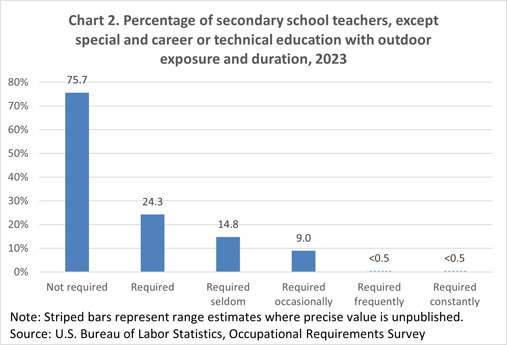
Refer to the physical activities required to perform tasks in jobs. The presence and, in some cases, duration of these activities are published.
In 2023, keyboarding was required for greater than 99.5 percent of secondary school teachers, except special and career or technical education and was not required for less than 0.5 percent. For 4.2 percent of workers, keyboarding was seldom performed, for 83.6 percent keyboarding occurred occasionally, 12.2 percent frequently, and for less than 0.5 percent keyboarding occurred constantly.
Performing work in low postures was required for 29.1 percent of secondary school teachers, except special and career or technical education and was not required for 70.9 percent.
The choice to sit or stand when performing critical tasks was available to 73.4 percent of secondary school teachers, except special and career or technical education. On average, workers spent 34.9 percent of the workday sitting and 65.1 percent of the workday standing.
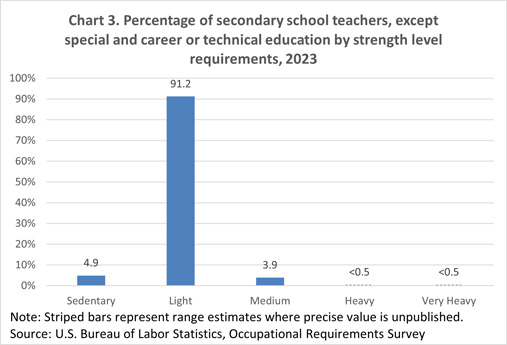
| Requirement | Yes | No |
|---|---|---|
|
Choice of sitting or standing |
73.4 | 26.6 |
|
Driving |
1.4 | 98.6 |
|
Climbing structure-related ramps or stairs |
18.6 | 81.4 |
|
Source: U.S. Bureau of Labor Statistics, Occupational Requirements Survey |
||

This occupational group includes agricultural inspectors, animal breeders, graders and sorters for agricultural products, and other miscellaneous agricultural workers like farmworkers or laborers and agricultural equipment operators. This group also includes fishing and hunting workers as well as forest, conservation, and logging workers.
The qualifications that workers need to use judgment, make decisions, interact with others, and adapt to changes in jobs.
In 2023, more than basic people skills were required for 28.8 percent of farming, fishing, and forestry workers, and basic people skills were required for 71.2 percent.
| Requirement | Yes | No |
|---|---|---|
|
Pace: Pause control |
67.3 | 32.7 |
|
Interaction with general public |
29.1 | 70.9 |
|
Working around crowds |
<0.5 | >99.5 |
|
Telework |
<5 | >95 |
|
Work review: Supervising others |
15.3 | 84.7 |
|
Work review: Presence of supervisor |
67.6 | 32.4 |
|
Source: U.S. Bureau of Labor Statistics, Occupational Requirements Survey |
||
The minimum level of formal education required, credentials necessary, on-the-job training, and prior work experience necessary for average performance in jobs.
In 2023, credentials were required for 51.4 percent of farming, fishing, and forestry workers. Prior work experience was required for 31.5 percent and on-the-job training was required for 82.5 percent.
No minimum education was required for 49.4 percent of farming, fishing, and forestry workers and a high school diploma was required for 42.6 percent.
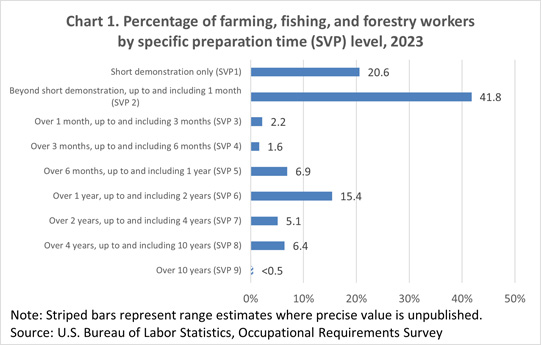
The various tangible or concrete hazards or difficulties that are in the vicinity of where jobs’ critical tasks are performed.
In 2023, 93.5 percent of farming, fishing, and forestry workers were not exposed to extreme cold, and greater than 99.5 percent were not exposed to extreme heat. Wetness was not present for 27.3 percent, 92.9 percent were not exposed to heavy vibrations, and 17.5 percent were not exposed to the outdoors.
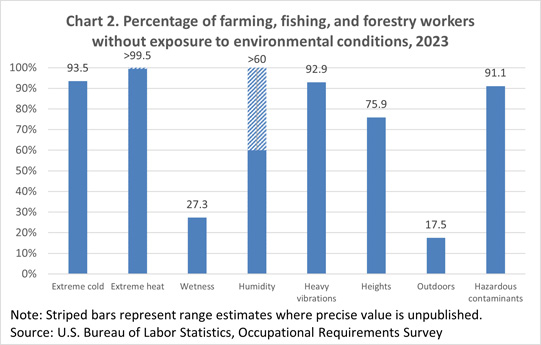
Refer to the physical activities required to perform tasks in jobs. The presence and, in some cases, duration of these activities are published.
In 2023, reaching at or below the shoulder was required for 94.2 percent of farming, fishing, and forestry workers and was not required for 5.8 percent. For 4.0 percent of workers, reaching at or below the shoulder was seldom performed, and for 2.2 percent reaching at or below the shoulder occurred constantly.
Performing work in low postures was required for 80.1 percent of farming, fishing, and forestry workers and was not required for 19.9 percent.
The choice to sit or stand when performing critical tasks was available to 31.8 percent of farming, fishing, and forestry workers. On average, workers spent 22.5 percent of the workday sitting and 77.5 percent of the workday standing.
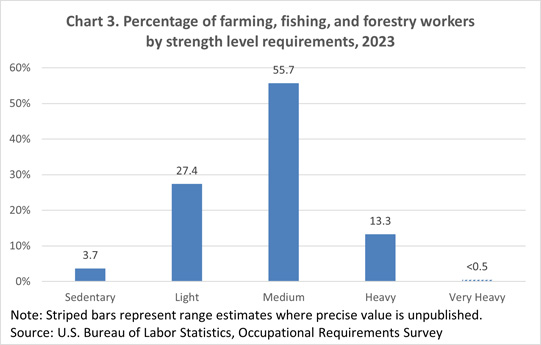
| Requirement | Yes | No |
|---|---|---|
|
Choice of sitting or standing |
31.8 | 68.2 |
|
Driving |
35.0 | 65.0 |
|
Climbing structure-related ramps or stairs |
49.8 | 50.2 |
|
Source: U.S. Bureau of Labor Statistics, Occupational Requirements Survey |
||

Mix and serve drinks to patrons, directly or through waitstaff.
The qualifications that workers need to use judgment, make decisions, interact with others, and adapt to changes in jobs.
In 2023, work was reviewed by a supervisor more than once per day for 54.0 percent of bartenders, and once per day for 37.9 percent.
| Requirement | Yes | No |
|---|---|---|
|
Pace: Pause control |
26.9 | 73.1 |
|
Interaction with general public |
>99.5 | <0.5 |
|
Working around crowds |
5.0 | 95.0 |
|
Telework |
<0.5 | >99.5 |
|
Work review: Supervising others |
<0.5 | >99.5 |
|
Work review: Presence of supervisor |
71.0 | 29.0 |
|
Source: U.S. Bureau of Labor Statistics, Occupational Requirements Survey |
||
The minimum level of formal education required, credentials necessary, on-the-job training, and prior work experience necessary for average performance in jobs.
In 2023, credentials were required for 51.2 percent of bartenders. Prior work experience was required for 44.1 percent and on-the-job training was required for 96.4 percent.
No minimum education was required for 71.7 percent of bartenders.
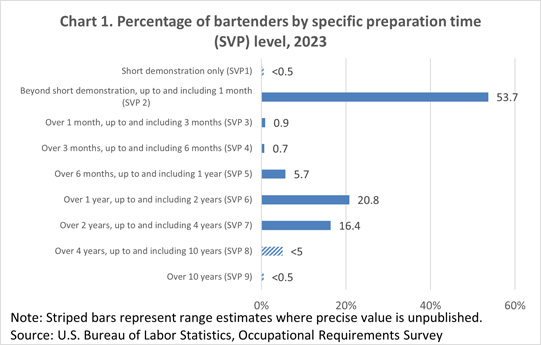
The various tangible or concrete hazards or difficulties that are in the vicinity of where jobs’ critical tasks are performed.
In 2023, 81.9 percent of bartenders were not exposed to extreme cold, and greater than 95 percent were not exposed to extreme heat. Wetness was not present for 5.0 percent, greater than 99.5 percent were not exposed to heavy vibrations, and 69.1 percent were not exposed to the outdoors.
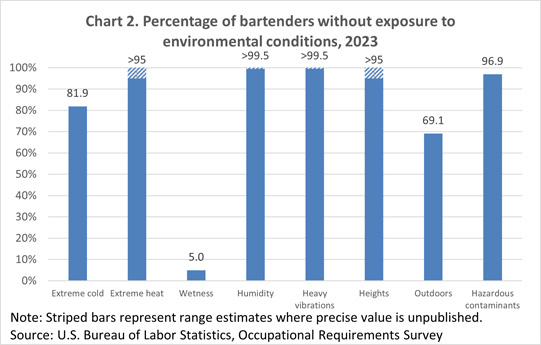
Refer to the physical activities required to perform tasks in jobs. The presence and, in some cases, duration of these activities are published.
In 2023, reaching at or below the shoulder was required for greater than 85 percent of bartenders and was not required for less than 15 percent. For 5.4 percent of workers, reaching at or below the shoulder was seldom performed, for 54.7 percent reaching at or below the shoulder occurred occasionally, 33.9 percent frequently, and for less than 5 percent reaching at or below the shoulder occurred constantly.
Performing work in low postures was required for 85.8 percent of bartenders and was not required for 14.2 percent.
On average, bartenders spent 1.6 percent of the workday sitting and 98.4 percent of the workday standing.
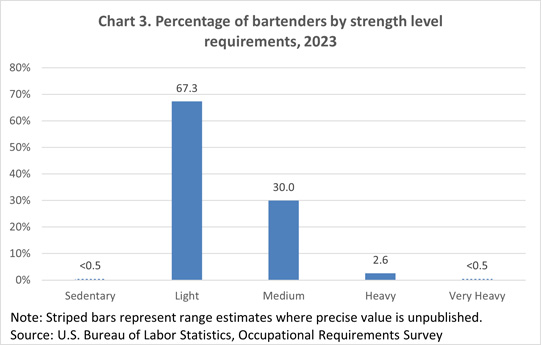
| Requirement | Yes | No |
|---|---|---|
|
Choice of sitting or standing |
<0.5 | >99.5 |
|
Driving |
0.7 | 99.3 |
|
Climbing structure-related ramps or stairs |
18.2 | 81.8 |
|
Source: U.S. Bureau of Labor Statistics, Occupational Requirements Survey |
||

Take orders and serve food and beverages to patrons at tables in dining establishment.
The qualifications that workers need to use judgment, make decisions, interact with others, and adapt to changes in jobs.
In 2023, work was reviewed by a supervisor more than once per day for 73.3 percent of waiters and waitresses, and once per day for 19.3 percent.
| Requirement | Yes | No |
|---|---|---|
|
Pace: Pause control |
24.9 | 75.1 |
|
Interaction with general public |
>99.5 | <0.5 |
|
Working around crowds |
18.1 | 81.9 |
|
Telework |
<0.5 | >99.5 |
|
Work review: Supervising others |
0.6 | 99.4 |
|
Work review: Presence of supervisor |
96.2 | 3.8 |
|
Source: U.S. Bureau of Labor Statistics, Occupational Requirements Survey |
||
The minimum level of formal education required, credentials necessary, on-the-job training, and prior work experience necessary for average performance in jobs.
In 2023, credentials were required for 34.6 percent of waiters and waitresses. Prior work experience was required for 22.5 percent and on-the-job training was required for 97.9 percent.
No minimum education was required for 78.0 percent of waiters and waitresses.
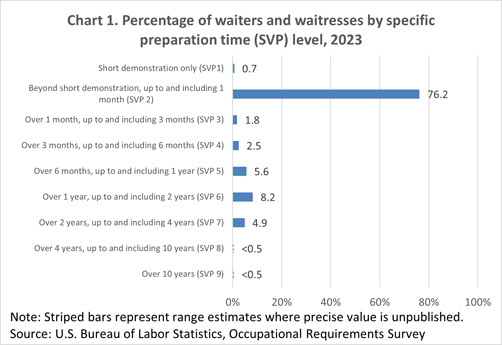
The various tangible or concrete hazards or difficulties that are in the vicinity of where jobs’ critical tasks are performed.
In 2023, 90.6 percent of waiters and waitresses were not exposed to extreme cold, and 98.5 percent were not exposed to extreme heat. Wetness was not present for 7.3 percent, greater than 99.5 percent were not exposed to heavy vibrations, and 72.0 percent were not exposed to the outdoors.
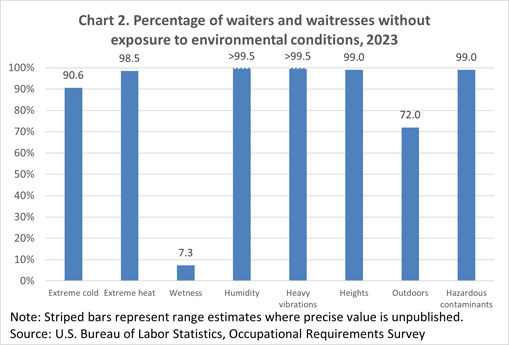
Refer to the physical activities required to perform tasks in jobs. The presence and, in some cases, duration of these activities are published.
In 2023, reaching at or below the shoulder was required for 95.8 percent of waiters and waitresses and was not required for 4.2 percent. For 6.6 percent of workers, reaching at or below the shoulder was seldom performed, for 55.5 percent reaching at or below the shoulder occurred occasionally, 30.7 percent frequently, and for 3.0 percent reaching at or below the shoulder occurred constantly.
Performing work in low postures was required for 62.9 percent of waiters and waitresses and was not required for 37.1 percent.
On average, waiters and waitresses spent 2.6 percent of the workday sitting and 97.4 percent of the workday standing.
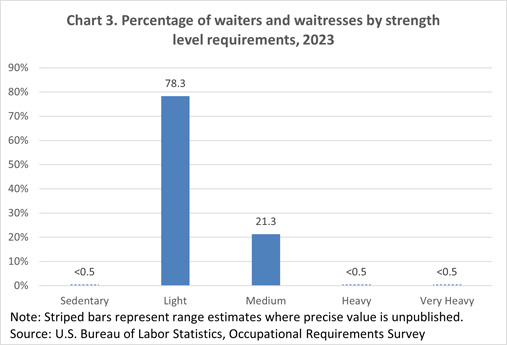
| Requirement | Yes | No |
|---|---|---|
|
Choice of sitting or standing |
<0.5 | >99.5 |
|
Driving |
<0.5 | >99.5 |
|
Climbing structure-related ramps or stairs |
10.3 | 89.7 |
|
Source: U.S. Bureau of Labor Statistics, Occupational Requirements Survey |
||

This occupational group includes chiropractors, dentists, pharmacists, physicians, surgeons, health diagnosing and treating practitioners, therapists, veterinarians, registered nurses, health technologists and technicians, and occupational health and safety specialists.
The qualifications that workers need to use judgment, make decisions, interact with others, and adapt to changes in jobs.
In 2023, more than basic people skills were required for 92.1 percent of healthcare practitioners and technical workers, and basic people skills were required for 7.9 percent.
| Requirement | Yes | No |
|---|---|---|
|
Pace: Pause control |
40.9 | 59.1 |
|
Interaction with general public |
96.7 | 3.3 |
|
Working around crowds |
1.0 | 99.0 |
|
Telework |
1.9 | 98.1 |
|
Work review: Supervising others |
21.5 | 78.5 |
|
Work review: Presence of supervisor |
62.7 | 37.3 |
|
Source: U.S. Bureau of Labor Statistics, Occupational Requirements Survey |
||
The minimum level of formal education required, credentials necessary, on-the-job training, and prior work experience necessary for average performance in jobs.
In 2023, credentials were required for 91.4 percent of healthcare practitioners and technical workers. Prior work experience was required for 39.1 percent and on-the-job training was required for 72.3 percent.
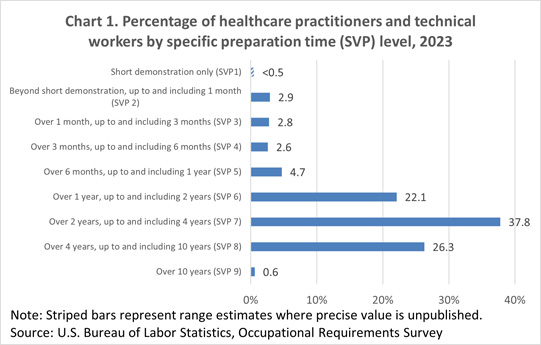
The various tangible or concrete hazards or difficulties that are in the vicinity of where jobs’ critical tasks are performed.
In 2023, greater than 99.5 percent of healthcare practitioners and technical workers were not exposed to extreme cold, and greater than 99.5 percent were not exposed to extreme heat. Wetness was not present for 26.3 percent, greater than 99.5 percent were not exposed to heavy vibrations, and 92.7 percent were not exposed to the outdoors.
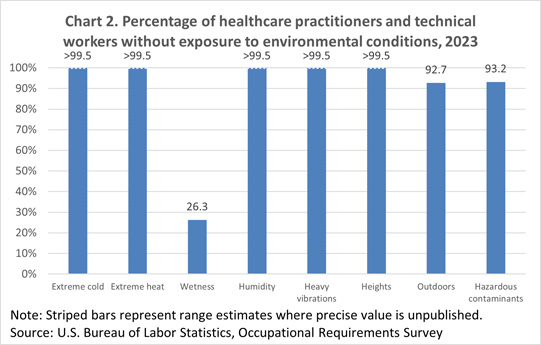
Refer to the physical activities required to perform tasks in jobs. The presence and, in some cases, duration of these activities are published.
In 2023, keyboarding was required for 96.5 percent of healthcare practitioners and technical workers and was not required for 3.5 percent.
Performing work in low postures was required for 73.3 percent of healthcare practitioners and technical workers and was not required for 26.7 percent.
The choice to sit or stand when performing critical tasks was available to 30.8 percent of healthcare practitioners and technical workers. On average, workers spent 36.7 percent of the workday sitting and 63.3 percent of the workday standing.
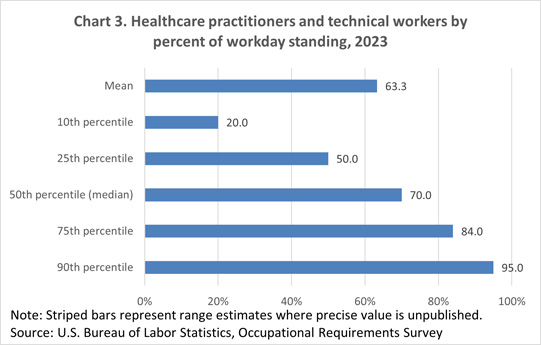
| Requirement | Yes | No |
|---|---|---|
|
Choice of sitting or standing |
30.8 | 69.2 |
|
Driving |
11.1 | 88.9 |
|
Climbing structure-related ramps or stairs |
13.9 | 86.1 |
|
Source: U.S. Bureau of Labor Statistics, Occupational Requirements Survey |
||

Care for ill, injured, or convalescing patients or persons with disabilities in hospitals, nursing homes, clinics, private homes, group homes, and similar institutions. May work under the supervision of a registered nurse. Licensing required.
The qualifications that workers need to use judgment, make decisions, interact with others, and adapt to changes in jobs.
In 2023, more than basic people skills were required for 96.6 percent of licensed practical and licensed vocational nurses, and basic people skills were required for 3.4 percent.
| Requirement | Yes | No |
|---|---|---|
|
Pace: Pause control |
33.7 | 66.3 |
|
Interaction with general public |
>99.5 | <0.5 |
|
Working around crowds |
<0.5 | >99.5 |
|
Telework |
1.5 | 98.5 |
|
Work review: Supervising others |
15.7 | 84.3 |
|
Work review: Presence of supervisor |
62.9 | 37.1 |
|
Source: U.S. Bureau of Labor Statistics, Occupational Requirements Survey |
||
The minimum level of formal education required, credentials necessary, on-the-job training, and prior work experience necessary for average performance in jobs.
In 2023, credentials were required for greater than 99.5 percent of licensed practical and licensed vocational nurses. Prior work experience was required for 31.8 percent and on-the-job training was required for 87.6 percent.
A high school diploma was required for 35.7 percent of licensed practical and licensed vocational nurses and an associate's degree was required for 45.1 percent.
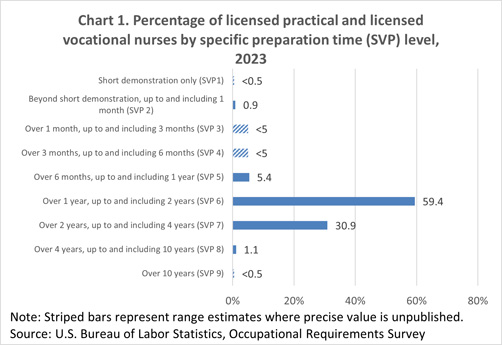
The various tangible or concrete hazards or difficulties that are in the vicinity of where jobs’ critical tasks are performed.
In 2023, greater than 99.5 percent of licensed practical and licensed vocational nurses were not exposed to extreme cold, and greater than 99.5 percent were not exposed to extreme heat. Heavy vibrations were not present for greater than 99.5 percent, and 83.6 percent were not exposed to the outdoors.
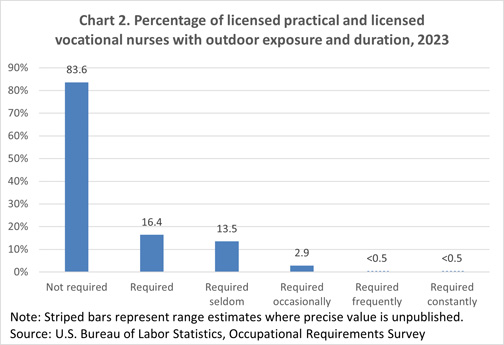
Refer to the physical activities required to perform tasks in jobs. The presence and, in some cases, duration of these activities are published.
In 2023, keyboarding was required for 93.8 percent of licensed practical and licensed vocational nurses and was not required for 6.2 percent. For less than 15 percent of workers, keyboarding was seldom performed, for 61.1 percent keyboarding occurred occasionally, 22.8 percent frequently, and for less than 0.5 percent keyboarding occurred constantly.
Performing work in low postures was required for 87.1 percent of licensed practical and licensed vocational nurses and was not required for 12.9 percent.
The choice to sit or stand when performing critical tasks was available to 12.8 percent of licensed practical and licensed vocational nurses. On average, workers spent 30.1 percent of the workday sitting and 69.9 percent of the workday standing.
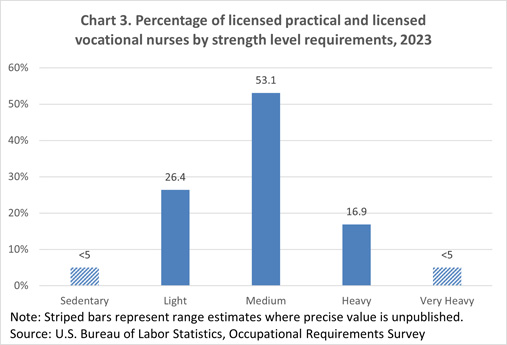
| Requirement | Yes | No |
|---|---|---|
|
Choice of sitting or standing |
12.8 | 87.2 |
|
Driving |
19.0 | 81.0 |
|
Climbing structure-related ramps or stairs |
22.0 | 78.0 |
|
Source: U.S. Bureau of Labor Statistics, Occupational Requirements Survey |
||

Assess patient health problems and needs, develop and implement nursing care plans, and maintain medical records. Administer nursing care to ill, injured, convalescent, or disabled patients. May advise patients on health maintenance and disease prevention or provide case management. Licensing or registration required.
The qualifications that workers need to use judgment, make decisions, interact with others, and adapt to changes in jobs.
In 2023, verbal interactions were required constantly (every few minutes) for 34.7 percent of registered nurses, and were required not constantly, but more than once per hour for 63.0 percent.
| Requirement | Yes | No |
|---|---|---|
|
Pace: Pause control |
29.4 | 70.6 |
|
Interaction with general public |
>99.5 | <0.5 |
|
Working around crowds |
<0.5 | >99.5 |
|
Telework |
2.8 | 97.2 |
|
Work review: Supervising others |
31.0 | 69.0 |
|
Work review: Presence of supervisor |
60.6 | 39.4 |
|
Source: U.S. Bureau of Labor Statistics, Occupational Requirements Survey |
||
The minimum level of formal education required, credentials necessary, on-the-job training, and prior work experience necessary for average performance in jobs.
In 2023, credentials were required for greater than 99.5 percent of registered nurses. Prior work experience was required for 48.3 percent and on-the-job training was required for 72.8 percent.
A bachelor's degree was required for 49.7 percent of registered nurses.
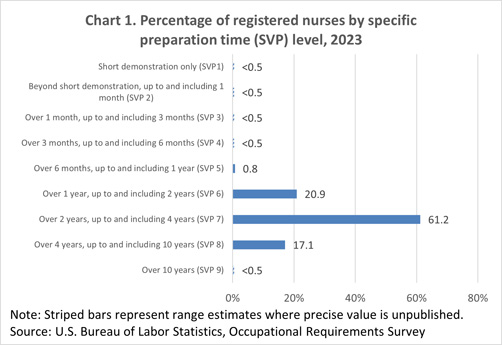
The various tangible or concrete hazards or difficulties that are in the vicinity of where jobs’ critical tasks are performed.
In 2023, greater than 99.5 percent of registered nurses were not exposed to extreme cold, and greater than 99.5 percent were not exposed to extreme heat. Wetness was not present for 11.6 percent, greater than 99.5 percent were not exposed to heavy vibrations, and 97.1 percent were not exposed to the outdoors.
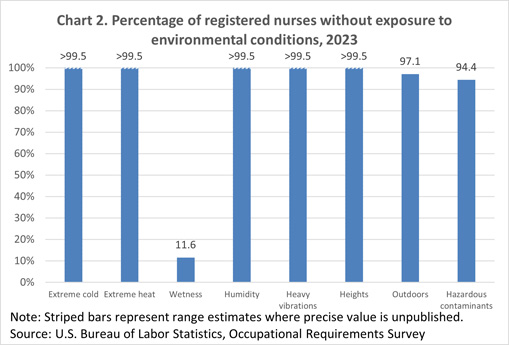
Refer to the physical activities required to perform tasks in jobs. The presence and, in some cases, duration of these activities are published.
In 2023, keyboarding was required for 96.8 percent of registered nurses and was not required for 3.2 percent.
Performing work in low postures was required for 84.4 percent of registered nurses and was not required for 15.6 percent.
The choice to sit or stand when performing critical tasks was available to 19.4 percent of registered nurses. On average, workers spent 30.7 percent of the workday sitting and 69.3 percent of the workday standing.
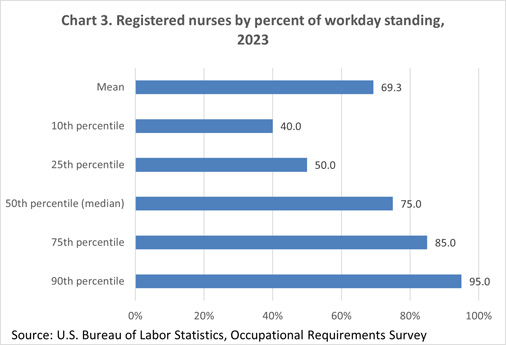
| Requirement | Yes | No |
|---|---|---|
|
Choice of sitting or standing |
19.4 | 80.6 |
|
Driving |
11.9 | 88.1 |
|
Climbing structure-related ramps or stairs |
19.7 | 80.3 |
|
Source: U.S. Bureau of Labor Statistics, Occupational Requirements Survey |
||

This occupational group includes nursing, psychiatric, home health aides, occupational therapy and physical therapist assistants and aides, dental, medical, and veterinary assistants, phlebotomists, and medial transcriptionists.
The qualifications that workers need to use judgment, make decisions, interact with others, and adapt to changes in jobs.
In 2023, verbal interactions were required constantly (every few minutes) for 30.7 percent of healthcare support workers, and were required not constantly, but more than once per hour for 57.9 percent.
| Requirement | Yes | No |
|---|---|---|
|
Pace: Pause control |
37.6 | 62.4 |
|
Interaction with general public |
98.5 | 1.5 |
|
Working around crowds |
2.3 | 97.7 |
|
Telework |
0.7 | 99.3 |
|
Work review: Supervising others |
0.7 | 99.3 |
|
Work review: Presence of supervisor |
52.5 | 47.5 |
|
Source: U.S. Bureau of Labor Statistics, Occupational Requirements Survey |
||
The minimum level of formal education required, credentials necessary, on-the-job training, and prior work experience necessary for average performance in jobs.
In 2023, credentials were required for 75.4 percent of healthcare support workers. Prior work experience was required for 20.4 percent and on-the-job training was required for 87.0 percent.
A high school diploma was required for 63.4 percent of healthcare support workers.
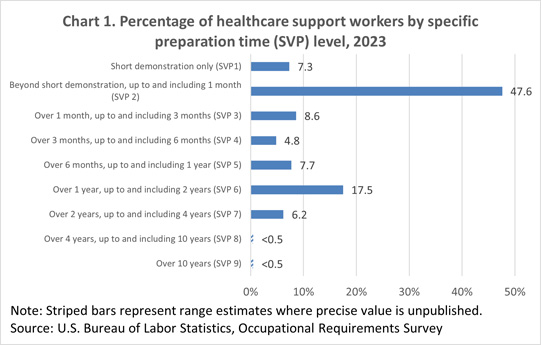
The various tangible or concrete hazards or difficulties that are in the vicinity of where jobs’ critical tasks are performed.
In 2023, greater than 99.5 percent of healthcare support workers were not exposed to extreme cold, and 97.9 percent were not exposed to extreme heat. Wetness was not present for 13.8 percent, greater than 99.5 percent were not exposed to heavy vibrations, and 66.9 percent were not exposed to the outdoors.
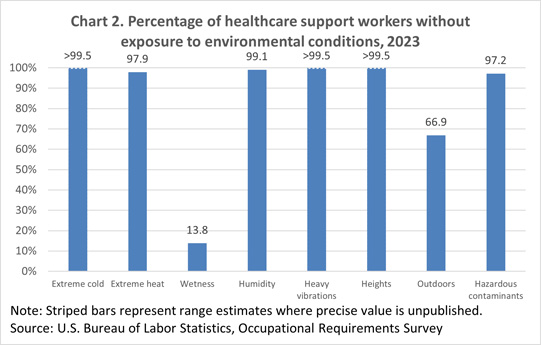
Refer to the physical activities required to perform tasks in jobs. The presence and, in some cases, duration of these activities are published.
In 2023, reaching at or below the shoulder was required for 93.9 percent of healthcare support workers and was not required for 6.1 percent.
Performing work in low postures was required for 82.6 percent of healthcare support workers and was not required for 17.4 percent.
The choice to sit or stand when performing critical tasks was available to 18.4 percent of healthcare support workers. On average, workers spent 30.6 percent of the workday sitting and 69.4 percent of the workday standing.
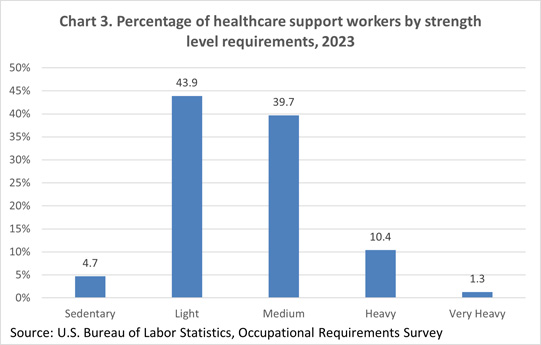
| Requirement | Yes | No |
|---|---|---|
|
Choice of sitting or standing |
18.4 | 81.6 |
|
Driving |
27.8 | 72.2 |
|
Climbing structure-related ramps or stairs |
37.6 | 62.4 |
|
Source: U.S. Bureau of Labor Statistics, Occupational Requirements Survey |
||

Provide or assist with basic care or support under the direction of onsite licensed nursing staff. Perform duties such as monitoring of health status, feeding, bathing, dressing, grooming, toileting, or ambulation of patients in a health or nursing facility. May include medication administration and other health-related tasks. Includes nursing care attendants, nursing aides, and nursing attendants.
The qualifications that workers need to use judgment, make decisions, interact with others, and adapt to changes in jobs.
In 2023, work was reviewed by a supervisor more than once per day for 72.3 percent of nursing assistants, and once per day for 18.6 percent.
| Requirement | Yes | No |
|---|---|---|
|
Pace: Pause control |
27.0 | 73.0 |
|
Interaction with general public |
>99.5 | <0.5 |
|
Working around crowds |
1.1 | 98.9 |
|
Telework |
<0.5 | >99.5 |
|
Work review: Supervising others |
0.7 | 99.3 |
|
Work review: Presence of supervisor |
85.9 | 14.1 |
|
Source: U.S. Bureau of Labor Statistics, Occupational Requirements Survey |
||
The minimum level of formal education required, credentials necessary, on-the-job training, and prior work experience necessary for average performance in jobs.
In 2023, credentials were required for 89.0 percent of nursing assistants. Prior work experience was required for 14.1 percent and on-the-job training was required for 91.8 percent.
A high school diploma was required for 68.1 percent of nursing assistants.
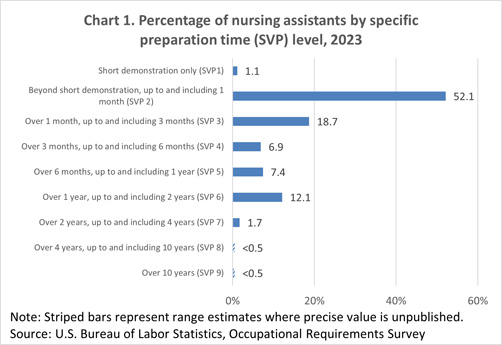
The various tangible or concrete hazards or difficulties that are in the vicinity of where jobs’ critical tasks are performed.
In 2023, greater than 99.5 percent of nursing assistants were not exposed to extreme cold, and greater than 99.5 percent were not exposed to extreme heat. Heavy vibrations were not present for greater than 99.5 percent, and 82.2 percent were not exposed to the outdoors.
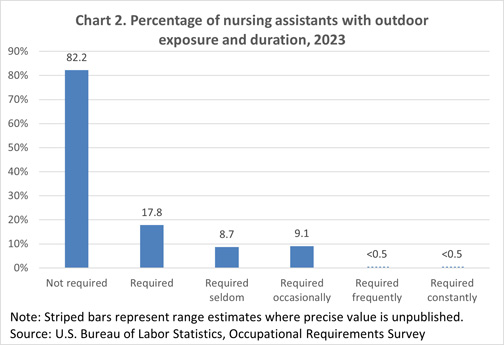
Refer to the physical activities required to perform tasks in jobs. The presence and, in some cases, duration of these activities are published.
In 2023, reaching at or below the shoulder was required for 97.1 percent of nursing assistants and was not required for 2.9 percent.
Performing work in low postures was required for 98.2 percent of nursing assistants and was not required for 1.8 percent.
The choice to sit or stand when performing critical tasks was available to 11.0 percent of nursing assistants. On average, workers spent 15.9 percent of the workday sitting and 84.1 percent of the workday standing.
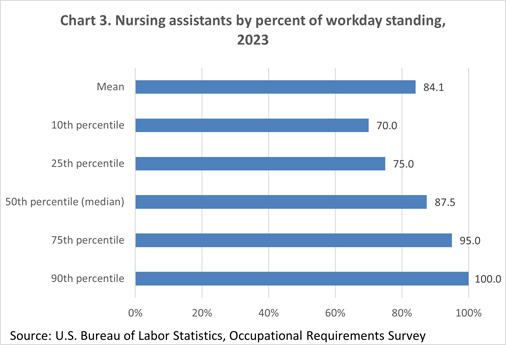
| Requirement | Yes | No |
|---|---|---|
|
Choice of sitting or standing |
11.0 | 89.0 |
|
Driving |
8.5 | 91.5 |
|
Climbing structure-related ramps or stairs |
10.8 | 89.2 |
|
Source: U.S. Bureau of Labor Statistics, Occupational Requirements Survey |
||

This occupational group includes computer, automated teller and office machine repairers, avionics technicians, security and fire alarm systems installers, aircraft mechanics and technicians, bus and truck mechanics, diesel engine specialists, small engine mechanics, bicycle repairers, home appliance repairers, millwrights, watch repairers, wind turbine service technicians, and riggers.
The qualifications that workers need to use judgment, make decisions, interact with others, and adapt to changes in jobs.
| Requirement | Yes | No |
|---|---|---|
|
Pace: Pause control |
71.8 | 28.2 |
|
Interaction with general public |
66.5 | 33.5 |
|
Working around crowds |
<0.5 | >99.5 |
|
Telework |
0.5 | 99.5 |
|
Work review: Supervising others |
14.1 | 85.9 |
|
Work review: Presence of supervisor |
51.4 | 48.6 |
|
Source: U.S. Bureau of Labor Statistics, Occupational Requirements Survey |
||
The minimum level of formal education required, credentials necessary, on-the-job training, and prior work experience necessary for average performance in jobs.
In 2023, credentials were required for 73.3 percent of installation, maintenance, and repair workers. Prior work experience was required for 67.2 percent and on-the-job training was required for 75.6 percent.
A high school diploma was required for 61.2 percent of installation, maintenance, and repair workers.
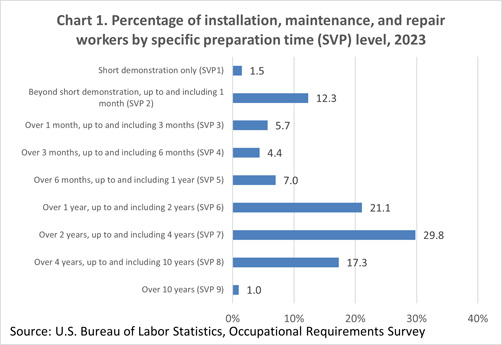
The various tangible or concrete hazards or difficulties that are in the vicinity of where jobs’ critical tasks are performed.
In 2023, a quiet noise exposure was present for 2.6 percent of installation, maintenance, and repair workers. Another 82.8 percent were exposed to moderate noise, 14.0 percent were exposed to loud noise, and 0.7 percent to very loud noise. Personal protective equipment (PPE) was used by 33.1 percent of workers to mitigate noise exposure, and was not used by 66.9 percent.
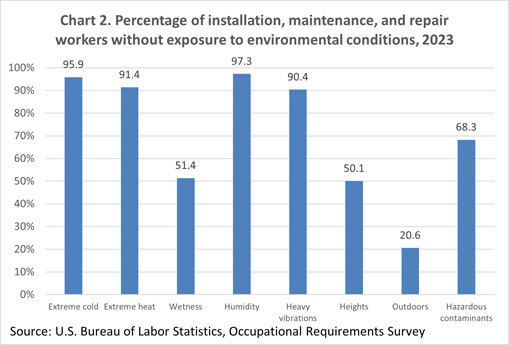
Refer to the physical activities required to perform tasks in jobs. The presence and, in some cases, duration of these activities are published.
In 2023, reaching at or below the shoulder was required for 97.6 percent of installation, maintenance, and repair workers and was not required for 2.4 percent.
Performing work in low postures was required for 95.0 percent of installation, maintenance, and repair workers and was not required for 5.0 percent. For 33.4 percent of workers, stooping was required to perform low work.
The choice to sit or stand when performing critical tasks was available to 18.4 percent of installation, maintenance, and repair workers. On average, workers spent 20.4 percent of the workday sitting and 79.6 percent of the workday standing.
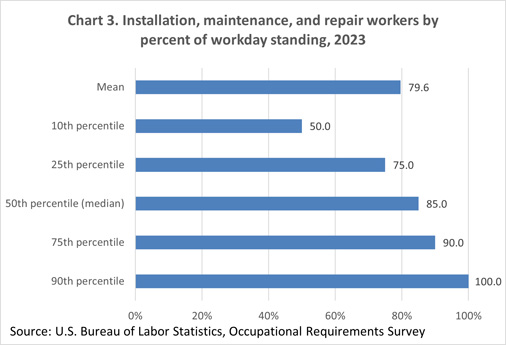
| Requirement | Yes | No |
|---|---|---|
|
Choice of sitting or standing |
18.4 | 81.6 |
|
Driving |
74.0 | 26.0 |
|
Climbing structure-related ramps or stairs |
42.9 | 57.1 |
|
Source: U.S. Bureau of Labor Statistics, Occupational Requirements Survey |
||

Diagnose, adjust, repair, or overhaul aircraft engines and assemblies, such as hydraulic and pneumatic systems. Includes helicopter and aircraft engine specialists.
The qualifications that workers need to use judgment, make decisions, interact with others, and adapt to changes in jobs.
| Requirement | Yes | No |
|---|---|---|
|
Interaction with general public |
18.7 | 81.3 |
|
Working around crowds |
<0.5 | >99.5 |
|
Telework |
<0.5 | >99.5 |
|
Work review: Supervising others |
3.1 | 96.9 |
|
Work review: Presence of supervisor |
82.2 | 17.8 |
|
Source: U.S. Bureau of Labor Statistics, Occupational Requirements Survey |
||
The minimum level of formal education required, credentials necessary, on-the-job training, and prior work experience necessary for average performance in jobs.
In 2023, credentials were required for 95.9 percent of aircraft mechanics and service technicians.
A high school diploma was required for 77.6 percent of aircraft mechanics and service technicians.
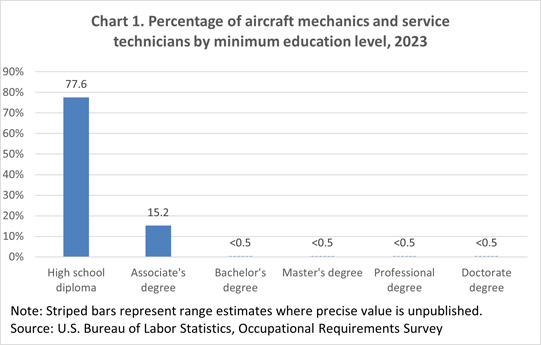
The various tangible or concrete hazards or difficulties that are in the vicinity of where jobs’ critical tasks are performed.
In 2023, greater than 99.5 percent of aircraft mechanics and service technicians were not exposed to extreme cold, and 88.5 percent were not exposed to extreme heat. Wetness was not present for 64.7 percent, 76.7 percent were not exposed to heavy vibrations, and 29.9 percent were not exposed to the outdoors.
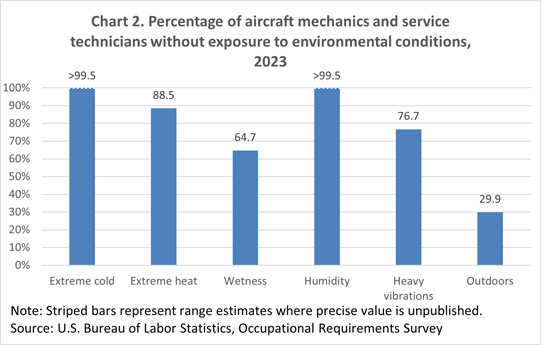
Refer to the physical activities required to perform tasks in jobs. The presence and, in some cases, duration of these activities are published.
In 2023, reaching at or below the shoulder was required for 99.3 percent of aircraft mechanics and service technicians and was not required for 0.7 percent.
Performing work in low postures was required for 96.2 percent of aircraft mechanics and service technicians and was not required for 3.8 percent.
The choice to sit or stand when performing critical tasks was available to 23.0 percent of aircraft mechanics and service technicians
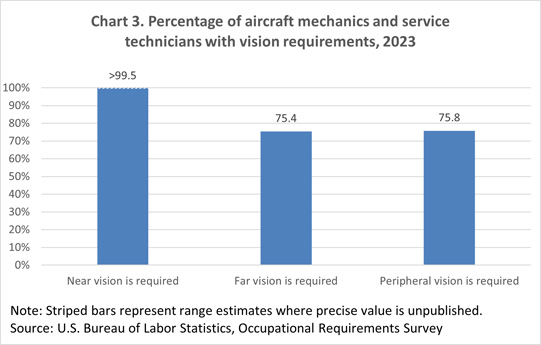
| Requirement | Yes | No |
|---|---|---|
|
Choice of sitting or standing |
23.0 | 77.0 |
|
Driving |
66.0 | 34.0 |
|
Source: U.S. Bureau of Labor Statistics, Occupational Requirements Survey |
||

This occupational group includes lawyers, judicial law clerks, judges, arbitrators, mediators, conciliators, paralegals, legal assistants, court reporters, title examiners, abstractors, and searchers.
The qualifications that workers need to use judgment, make decisions, interact with others, and adapt to changes in jobs. In 2023, verbal interactions were required constantly (every few minutes) for 10.4 percent of legal workers, and were required not constantly, but more than once per hour for 66.5 percent.
| Requirement | Yes | No |
|---|---|---|
|
Pace: Pause control |
95.3 | 4.7 |
|
Interaction with general public |
98.8 | 1.2 |
|
Working around crowds |
<0.5 | >99.5 |
|
Telework |
53.8 | 46.2 |
|
Work review: Supervising others |
27.7 | 72.3 |
|
Work review: Presence of supervisor |
55.1 | 44.9 |
|
Source: U.S. Bureau of Labor Statistics, Occupational Requirements Survey |
||
The minimum level of formal education required, credentials necessary, on-the-job training, and prior work experience necessary for average performance in jobs.
In 2023, credentials were required for 78.2 percent of legal workers. Prior work experience was required for 53.5 percent and on-the-job training was required for 60.3 percent.
A professional degree was required for 60.5 percent of legal workers.
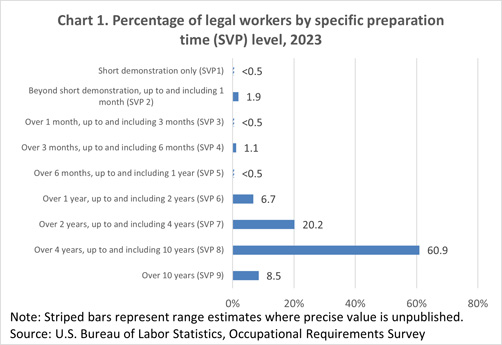
The various tangible or concrete hazards or difficulties that are in the vicinity of where jobs’ critical tasks are performed.
In 2023, greater than 99.5 percent of legal workers were not exposed to extreme cold, and greater than 99.5 percent were not exposed to extreme heat. Wetness was not present for greater than 99.5 percent, greater than 99.5 percent were not exposed to heavy vibrations, and 98.4 percent were not exposed to the outdoors.
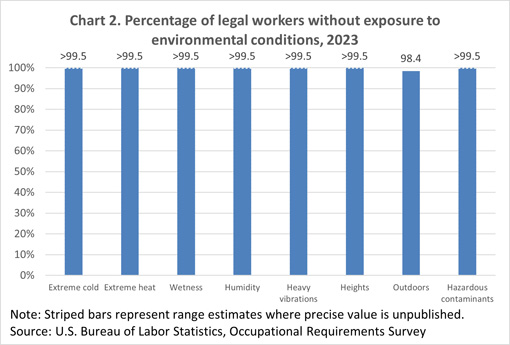
Refer to the physical activities required to perform tasks in jobs. The presence and, in some cases, duration of these activities are published.
In 2023, keyboarding was required for greater than 99.5 percent of legal workers and was not required for less than 0.5 percent. For less than 0.5 percent of workers, keyboarding was seldom performed, for 27.8 percent keyboarding occurred occasionally, 68.2 percent frequently, and for 3.7 percent keyboarding occurred constantly.
Performing work in low postures was required for 6.6 percent of legal workers and was not required for 93.4 percent.
The choice to sit or stand when performing critical tasks was available to 85.3 percent of legal workers. On average, workers spent 84.8 percent of the workday sitting and 15.2 percent of the workday standing.
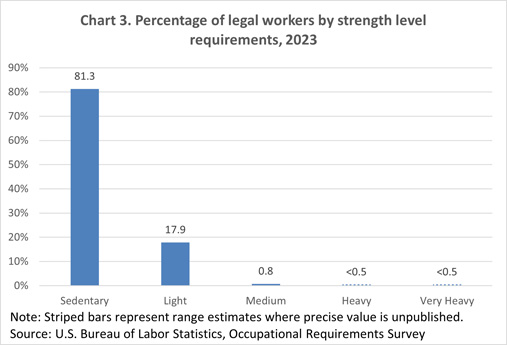
|
Requirement |
Yes | No |
|---|---|---|
|
Choice of sitting or standing |
85.3 | 14.7 |
|
Driving |
39.1 | 60.9 |
|
Climbing structure-related ramps or stairs |
12.4 | 87.6 |
|
Source: U.S. Bureau of Labor Statistics, Occupational Requirements Survey |
||

Represent clients in criminal and civil litigation and other legal proceedings, draw up legal documents, or manage or advise clients on legal transactions. May specialize in a single area or may practice broadly in many areas of law.
The qualifications that workers need to use judgment, make decisions, interact with others, and adapt to changes in jobs.
In 2023, verbal interactions were required constantly (every few minutes) for 12.4 percent of lawyers, and were required not constantly, but more than once per hour for 65.2 percent.
|
Requirement |
Yes | No |
|---|---|---|
|
Pace: Pause control |
94.8 | 5.2 |
|
Interaction with general public |
>99.5 | <0.5 |
|
Working around crowds |
<0.5 | >99.5 |
|
Telework |
67.1 | 32.9 |
|
Work review: Supervising others |
40.9 | 59.1 |
|
Work review: Presence of supervisor |
44.5 | 55.5 |
|
Source: U.S. Bureau of Labor Statistics, Occupational Requirements Survey |
||
The minimum level of formal education required, credentials necessary, on-the-job training, and prior work experience necessary for average performance in jobs.
In 2023, credentials were required for greater than 99.5 percent of lawyers. Prior work experience was required for 44.1 percent and on-the-job training was required for 47.6 percent.
A professional degree was required for greater than 99.5 percent of lawyers.
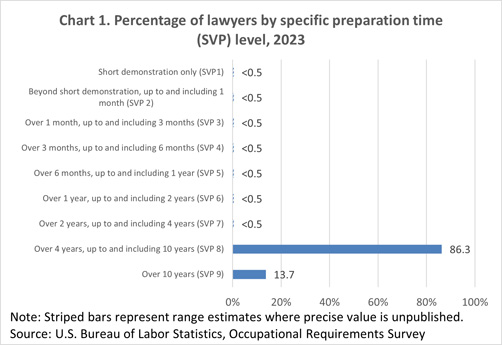
The various tangible or concrete hazards or difficulties that are in the vicinity of where jobs’ critical tasks are performed.
In 2023, greater than 99.5 percent of lawyers were not exposed to extreme cold, and greater than 99.5 percent were not exposed to extreme heat. Wetness was not present for greater than 99.5 percent, greater than 99.5 percent were not exposed to heavy vibrations, and 97.5 percent were not exposed to the outdoors.
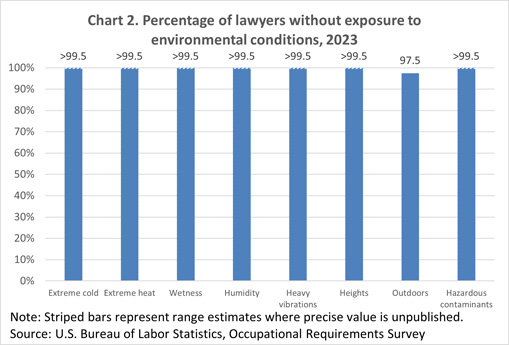
Refer to the physical activities required to perform tasks in jobs. The presence and, in some cases, duration of these activities are published.
In 2023, keyboarding was required for greater than 99.5 percent of lawyers and was not required for less than 0.5 percent. For less than 0.5 percent of workers, keyboarding was seldom performed, for 30.1 percent keyboarding occurred occasionally, 65.9 percent frequently, and for 3.8 percent keyboarding occurred constantly.
Performing work in low postures was required for 4.1 percent of lawyers and was not required for 95.9 percent.
The choice to sit or stand when performing critical tasks was available to 86.1 percent of lawyers. On average, workers spent 82.4 percent of the workday sitting and 17.6 percent of the workday standing.
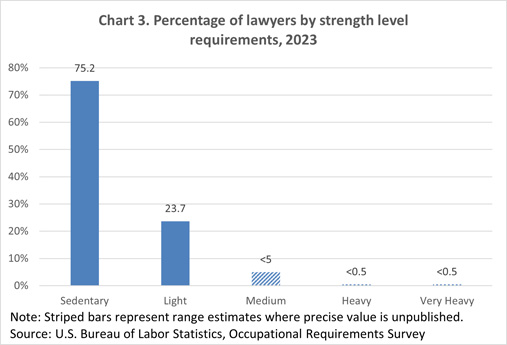
|
Requirement |
Yes | No |
|---|---|---|
|
Choice of sitting or standing |
86.1 | 13.9 |
|
Driving |
54.5 | 45.5 |
|
Climbing structure-related ramps or stairs |
14.1 | 85.9 |
|
Source: U.S. Bureau of Labor Statistics, Occupational Requirements Survey |
||

Diagnose and implement individual or schoolwide interventions or strategies to address educational, behavioral, or developmental issues that adversely impact educational functioning in a school. May address student learning and behavioral problems and counsel students or families. May design and implement performance plans, and evaluate performance. May consult with other school-based personnel.
The qualifications that workers need to use judgment, make decisions, interact with others, and adapt to changes in jobs.
In 2023, verbal interactions were required constantly (every few minutes) for 16.9 percent of school psychologists, and were required not constantly, but more than once per hour for 79.1 percent.
| Requirement | Yes | No |
|---|---|---|
|
Pace: Pause control |
69.1 | 30.9 |
|
Interaction with general public |
>99.5 | <0.5 |
|
Working around crowds |
2.7 | 97.3 |
|
Telework |
<5 | >95 |
|
Work review: Supervising others |
6.4 | 93.6 |
|
Work review: Presence of supervisor |
29.6 | 70.4 |
|
Source: U.S. Bureau of Labor Statistics, Occupational Requirements Survey |
||
The minimum level of formal education required, credentials necessary, on-the-job training, and prior work experience necessary for average performance in jobs.
In 2023, credentials were required for greater than 85 percent of school psychologists. Prior work experience was required for 53.2 percent and on-the-job training was required for 36.3 percent.
A master's degree was required for 70.7 percent of school psychologists.
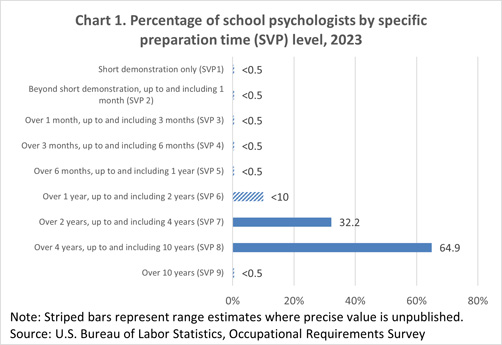
The various tangible or concrete hazards or difficulties that are in the vicinity of where jobs’ critical tasks are performed.
In 2023, greater than 99.5 percent of school psychologists were not exposed to extreme cold, and greater than 99.5 percent were not exposed to extreme heat. Wetness was not present for greater than 85 percent, greater than 99.5 percent were not exposed to heavy vibrations, and 81.6 percent were not exposed to the outdoors.
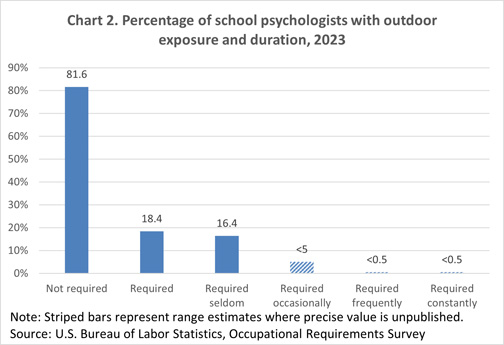
Refer to the physical activities required to perform tasks in jobs. The presence and, in some cases, duration of these activities are published.
In 2023, keyboarding was required for greater than 99.5 percent of school psychologists and was not required for less than 0.5 percent. For less than 0.5 percent of workers, keyboarding was seldom performed, for 59.4 percent keyboarding occurred occasionally, 40.6 percent frequently, and for less than 0.5 percent keyboarding occurred constantly.
Performing work in low postures was required for 27.5 percent of school psychologists and was not required for 72.5 percent.
The choice to sit or stand when performing critical tasks was available to 85.7 percent of school psychologists. On average, workers spent 73.1 percent of the workday sitting and 26.9 percent of the workday standing.
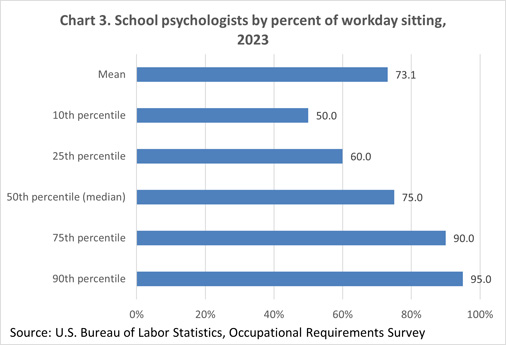
| Requirement | Yes | No |
|---|---|---|
|
Choice of sitting or standing |
85.7 | 14.3 |
|
Driving |
29.2 | 70.8 |
|
Climbing structure-related ramps or stairs |
38.9 | 61.1 |
|
Source: U.S. Bureau of Labor Statistics, Occupational Requirements Survey |
||

This occupational group includes chief executives, general and operations managers, advertising and promotions managers, construction, administrative services managers, financial managers, industrial production managers, transportation managers, storage managers, distribution managers, compensation and benefits managers, human resources managers, training managers, development managers, and education administrators.
The qualifications that workers need to use judgment, make decisions, interact with others, and adapt to changes in jobs.
In 2023, verbal interactions were required constantly (every few minutes) for 19.4 percent of management workers, and were required not constantly, but more than once per hour for 69.0 percent.
| Requirement | Yes | No |
|---|---|---|
|
Pace: Pause control |
97.5 | 2.5 |
|
Interaction with general public |
90.1 | 9.9 |
|
Working around crowds |
2.3 | 97.7 |
|
Telework |
33.0 | 67.0 |
|
Work review: Supervising others |
92.0 | 8.0 |
|
Work review: Presence of supervisor |
31.5 | 68.5 |
|
Source: U.S. Bureau of Labor Statistics, Occupational Requirements Survey |
||
The minimum level of formal education required, credentials necessary, on-the-job training, and prior work experience necessary for average performance in jobs.
In 2023, credentials were required for 47.3 percent of management workers. Prior work experience was required for 95.6 percent and on-the-job training was required for 54.0 percent.
A bachelor's degree was required for 56.6 percent of management workers.
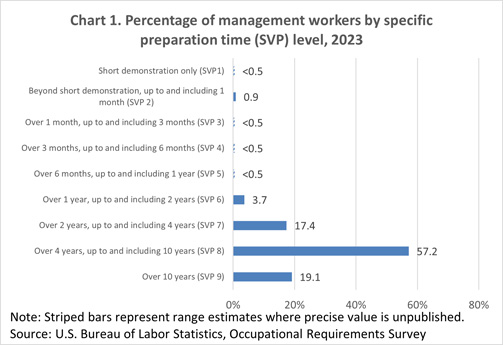
The various tangible or concrete hazards or difficulties that are in the vicinity of where jobs’ critical tasks are performed.
In 2023, 97.8 percent of management workers were not exposed to extreme cold, and 98.4 percent were not exposed to extreme heat. Wetness was not present for 92.8 percent, greater than 99.5 percent were not exposed to heavy vibrations, and 76.2 percent were not exposed to the outdoors.
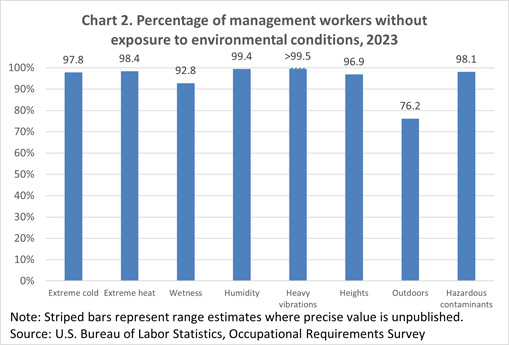
Refer to the physical activities required to perform tasks in jobs. The presence and, in some cases, duration of these activities are published.
In 2023, keyboarding was required for 98.9 percent of management workers and was not required for 1.1 percent. For 1.2 percent of workers, keyboarding was seldom performed, for 41.0 percent keyboarding occurred occasionally, 54.9 percent frequently, and for 1.6 percent keyboarding occurred constantly.
Performing work in low postures was required for 17.3 percent of management workers and was not required for 82.7 percent.
The choice to sit or stand when performing critical tasks was available to 88.5 percent of management workers. On average, workers spent 72.6 percent of the workday sitting and 27.4 percent of the workday standing.
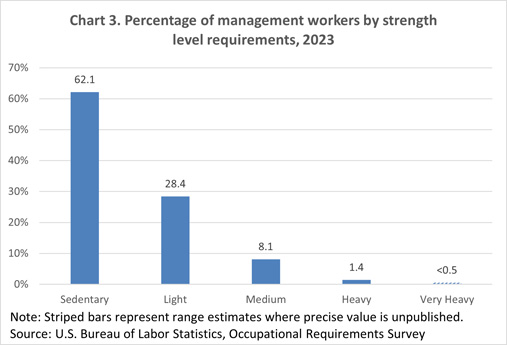
| Requirement | Yes | No |
|---|---|---|
|
Choice of sitting or standing |
88.5 | 11.5 |
|
Driving |
36.0 | 64.0 |
|
Climbing structure-related ramps or stairs |
17.3 | 82.7 |
|
Source: U.S. Bureau of Labor Statistics, Occupational Requirements Survey |
||

Plan, direct, or coordinate activities in such fields as architecture and engineering or research and development in these fields.
The qualifications that workers need to use judgment, make decisions, interact with others, and adapt to changes in jobs.
In 2023, verbal interactions were required constantly (every few minutes) for 13.3 percent of architectural and engineering managers, and were required not constantly, but more than once per hour for 64.8 percent.
| Requirement | Yes | No |
|---|---|---|
|
Pace: Pause control |
>99.5 | <0.5 |
|
Interaction with general public |
71.8 | 28.2 |
|
Working around crowds |
<0.5 | >99.5 |
|
Telework |
42.2 | 57.8 |
|
Work review: Supervising others |
98.0 | 2.0 |
|
Work review: Presence of supervisor |
45.0 | 55.0 |
|
Source: U.S. Bureau of Labor Statistics, Occupational Requirements Survey |
||
The minimum level of formal education required, credentials necessary, on-the-job training, and prior work experience necessary for average performance in jobs.
In 2023, credentials were required for 42.9 percent of architectural and engineering managers. Prior work experience was required for greater than 80 percent and on-the-job training was required for 43.7 percent.
A bachelor's degree was required for 88.7 percent of architectural and engineering managers.
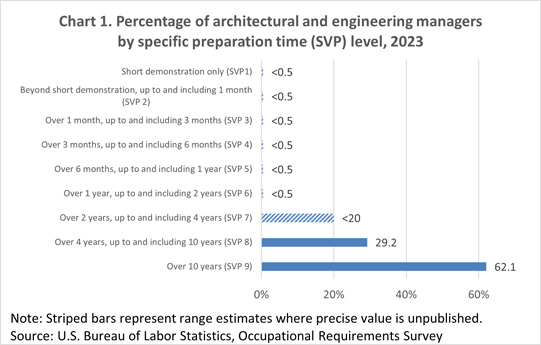
The various tangible or concrete hazards or difficulties that are in the vicinity of where jobs’ critical tasks are performed.
In 2023, greater than 99.5 percent of architectural and engineering managers were not exposed to extreme cold, and 99.4 percent were not exposed to extreme heat. Wetness was not present for 96.7 percent, greater than 90 percent were not exposed to heavy vibrations, and 75.4 percent were not exposed to the outdoors.
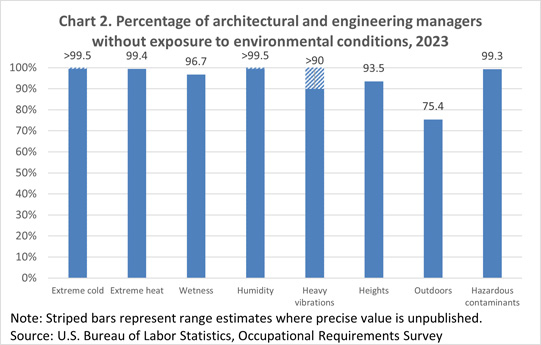
Refer to the physical activities required to perform tasks in jobs. The presence and, in some cases, duration of these activities are published.
In 2023, keyboarding was required for greater than 99.5 percent of architectural and engineering managers and was not required for less than 0.5 percent. For less than 0.5 percent of workers, keyboarding was seldom performed, for 30.4 percent keyboarding occurred occasionally, 66.1 percent frequently, and for less than 10 percent keyboarding occurred constantly.
Performing work in low postures was required for 11.5 percent of architectural and engineering managers and was not required for 88.5 percent.
The choice to sit or stand when performing critical tasks was available to 89.4 percent of architectural and engineering managers. On average, workers spent 84.3 percent of the workday sitting and 15.7 percent of the workday standing.
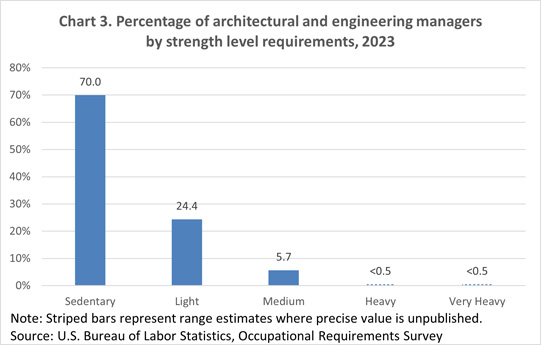
| Requirement | Yes | No |
|---|---|---|
|
Choice of sitting or standing |
89.4 | 10.6 |
|
Driving |
20.9 | 79.1 |
|
Climbing structure-related ramps or stairs |
19.8 | 80.2 |
|
Source: U.S. Bureau of Labor Statistics, Occupational Requirements Survey |
||

This occupational group includes communications equipment and computer operators, bill collectors, gaming cage workers, tellers, information and record clerks, customer service representatives, eligibility interviewers, secretaries and administrative assistants, couriers, dispatchers, data entry and information processing workers, and desktop publishers.
The qualifications that workers need to use judgment, make decisions, interact with others, and adapt to changes in jobs.
In 2023, verbal interactions were required constantly (every few minutes) for 31.4 percent of office and administrative support workers, and were required not constantly, but more than once per hour for 55.2 percent.
| Requirement | Yes | No |
|---|---|---|
|
Pace: Pause control |
70.8 | 29.2 |
|
Interaction with general public |
90.9 | 9.1 |
|
Working around crowds |
0.8 | 99.2 |
|
Telework |
12.5 | 87.5 |
|
Work review: Supervising others |
8.6 | 91.4 |
|
Work review: Presence of supervisor |
79.8 | 20.2 |
|
Source: U.S. Bureau of Labor Statistics, Occupational Requirements Survey |
||
The minimum level of formal education required, credentials necessary, on-the-job training, and prior work experience necessary for average performance in jobs.
In 2023, credentials were required for 10.8 percent of office and administrative support workers. Prior work experience was required for 59.4 percent and on-the-job training was required for 88.5 percent.
A high school diploma was required for 75.6 percent of office and administrative support workers.
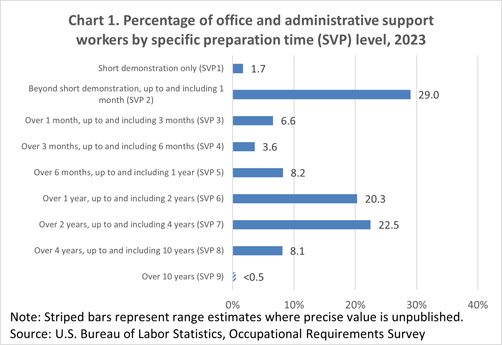
The various tangible or concrete hazards or difficulties that are in the vicinity of where jobs’ critical tasks are performed.
In 2023, greater than 99.5 percent of office and administrative support workers were not exposed to extreme cold, and greater than 99.5 percent were not exposed to extreme heat. Wetness was not present for 97.5 percent, greater than 99.5 percent were not exposed to heavy vibrations, and 95.3 percent were not exposed to the outdoors.
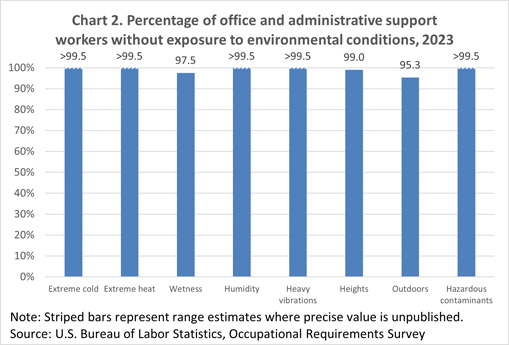
Refer to the physical activities required to perform tasks in jobs. The presence and, in some cases, duration of these activities are published.
In 2023, keyboarding was required for 98.1 percent of office and administrative support workers and was not required for 1.9 percent. For 1.3 percent of workers, keyboarding was seldom performed, for 26.6 percent keyboarding occurred occasionally, 65.1 percent frequently, and for 5.1 percent keyboarding occurred constantly.
Performing work in low postures was required for 21.1 percent of office and administrative support workers and was not required for 78.9 percent.
The choice to sit or stand when performing critical tasks was available to 80.9 percent of office and administrative support workers. On average, workers spent 79.4 percent of the workday sitting and 20.6 percent of the workday standing.
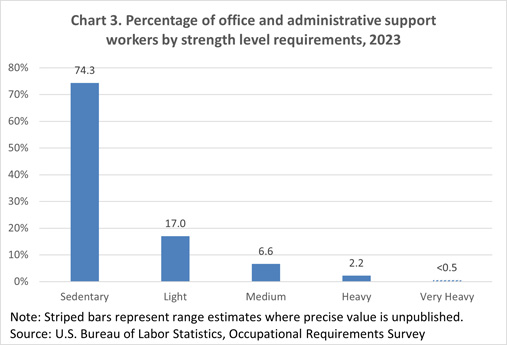
| Requirement | Yes | No |
|---|---|---|
|
Choice of sitting or standing |
80.9 | 19.1 |
|
Driving |
7.6 | 92.4 |
|
Climbing structure-related ramps or stairs |
8.0 | 92.0 |
|
Source: U.S. Bureau of Labor Statistics, Occupational Requirements Survey |
||

Provide high-level administrative support by conducting research, preparing statistical reports, handling information requests, and performing clerical functions such as preparing correspondence, receiving visitors, arranging conference calls, and scheduling meetings. May also train and supervise lower-level clerical staff.
The qualifications that workers need to use judgment, make decisions, interact with others, and adapt to changes in jobs.
In 2023, more than basic people skills were required for 93.0 percent of executive secretaries and executive administrative assistants, and basic people skills were required for 7.0 percent.
| Requirement | Yes | No |
|---|---|---|
|
Pace: Pause control |
88.7 | 11.3 |
|
Interaction with general public |
93.6 | 6.4 |
|
Working around crowds |
<5 | >95 |
|
Telework |
23.1 | 76.9 |
|
Work review: Supervising others |
11.5 | 88.5 |
|
Work review: Presence of supervisor |
82.9 | 17.1 |
|
Source: U.S. Bureau of Labor Statistics, Occupational Requirements Survey |
||
The minimum level of formal education required, credentials necessary, on-the-job training, and prior work experience necessary for average performance in jobs.
In 2023, credentials were required for 9.1 percent of executive secretaries and executive administrative assistants. Prior work experience was required for 93.6 percent and on-the-job training was required for 71.1 percent.
A high school diploma was required for 64.0 percent of executive secretaries and executive administrative assistants.
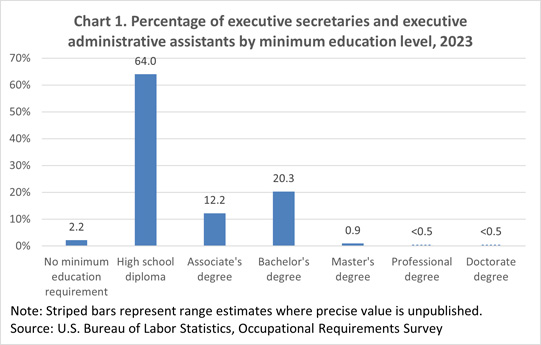
The various tangible or concrete hazards or difficulties that are in the vicinity of where jobs’ critical tasks are performed.
In 2023, greater than 99.5 percent of executive secretaries and executive administrative assistants were not exposed to extreme cold, and greater than 99.5 percent were not exposed to extreme heat. Wetness was not present for greater than 99.5 percent, greater than 99.5 percent were not exposed to heavy vibrations, and 98.3 percent were not exposed to the outdoors.
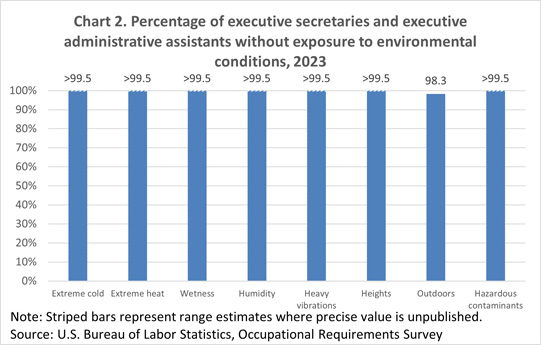
Refer to the physical activities required to perform tasks in jobs. The presence and, in some cases, duration of these activities are published.
In 2023, keyboarding was required for greater than 99.5 percent of executive secretaries and executive administrative assistants and was not required for less than 0.5 percent.
Performing work in low postures was required for 12.0 percent of executive secretaries and executive administrative assistants and was not required for 88.0 percent.
The choice to sit or stand when performing critical tasks was available to 96.5 percent of executive secretaries and executive administrative assistants. On average, workers spent 86.9 percent of the workday sitting and 13.1 percent of the workday standing.
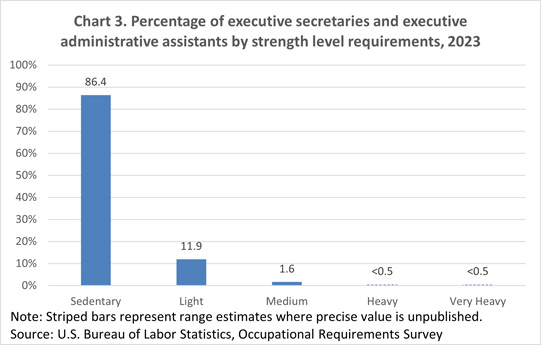
| Requirement | Yes | No |
|---|---|---|
|
Choice of sitting or standing |
96.5 | 3.5 |
|
Driving |
8.4 | 91.6 |
|
Climbing structure-related ramps or stairs |
5.4 | 94.6 |
|
Source: U.S. Bureau of Labor Statistics, Occupational Requirements Survey |
||

Compile records, sort, shelve, issue, and receive library materials such as books, electronic media, pictures, cards, slides and microfilm. Locate library materials for loan and replace material in shelving area, stacks, or files according to identification number and title. Register patrons to permit them to borrow books, periodicals, and other library materials.
The qualifications that workers need to use judgment, make decisions, interact with others, and adapt to changes in jobs.
In 2023, verbal interactions were required constantly (every few minutes) for 40.6 percent of library assistants, clerical, and were required not constantly, but more than once per hour for 47.5 percent.
| Requirement | Yes | No |
|---|---|---|
|
Pace: Pause control |
64.6 | 35.4 |
|
Interaction with general public |
96.0 | 4.0 |
|
Working around crowds |
<5 | >95 |
|
Telework |
<0.5 | >99.5 |
|
Work review: Supervising others |
2.4 | 97.6 |
|
Work review: Presence of supervisor |
80.2 | 19.8 |
|
Source: U.S. Bureau of Labor Statistics, Occupational Requirements Survey |
||
The minimum level of formal education required, credentials necessary, on-the-job training, and prior work experience necessary for average performance in jobs.
In 2023, credentials were required for 12.0 percent of library assistants, clerical. Prior work experience was required for 27.5 percent and on-the-job training was required for 90.9 percent.
A high school diploma was required for 72.9 percent of library assistants, clerical.
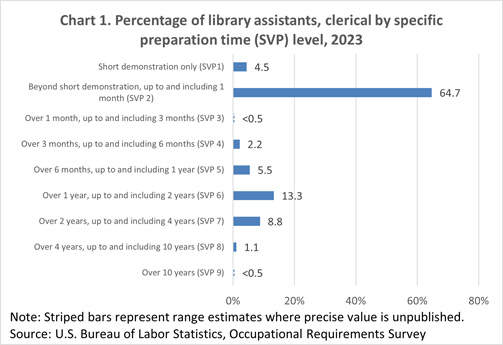
The various tangible or concrete hazards or difficulties that are in the vicinity of where jobs’ critical tasks are performed.
In 2023, greater than 99.5 percent of library assistants, clerical were not exposed to extreme cold, and greater than 99.5 percent were not exposed to extreme heat. Wetness was not present for greater than 99.5 percent, greater than 99.5 percent were not exposed to heavy vibrations, and 92.2 percent were not exposed to the outdoors.
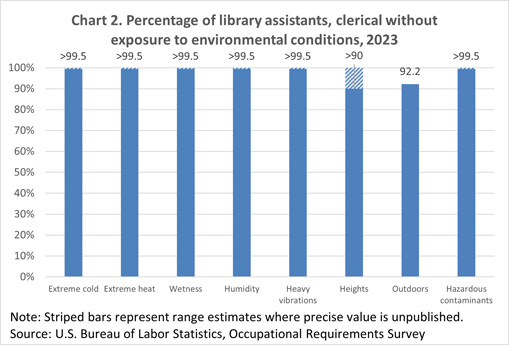
Refer to the physical activities required to perform tasks in jobs. The presence and, in some cases, duration of these activities are published.
In 2023, keyboarding was required for 96.5 percent of library assistants, clerical and was not required for 3.5 percent. For 14.2 percent of workers, keyboarding was seldom performed, for 46.4 percent keyboarding occurred occasionally, 35.9 percent frequently, and for less than 0.5 percent keyboarding occurred constantly.
Performing work in low postures was required for 89.6 percent of library assistants, clerical and was not required for 10.4 percent.
The choice to sit or stand when performing critical tasks was available to 45.8 percent of library assistants, clerical. On average, workers spent 47.9 percent of the workday sitting and 52.1 percent of the workday standing.
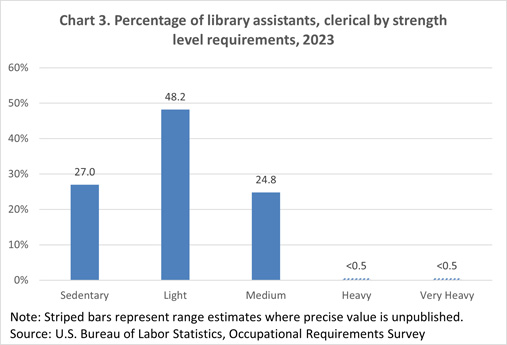
| Requirement | Yes | No |
|---|---|---|
|
Choice of sitting or standing |
45.8 | 54.2 |
|
Driving |
11.3 | 88.7 |
|
Climbing structure-related ramps or stairs |
9.2 | 90.8 |
|
Source: U.S. Bureau of Labor Statistics, Occupational Requirements Survey |
||

Perform secretarial duties using specific knowledge of medical terminology and hospital, clinic, or laboratory procedures. Duties may include scheduling appointments, billing patients, and compiling and recording medical charts, reports, and correspondence.
The qualifications that workers need to use judgment, make decisions, interact with others, and adapt to changes in jobs.
In 2023, verbal interactions were required constantly (every few minutes) for 54.6 percent of medical secretaries and administrative assistants, and were required not constantly, but more than once per hour for 43.8 percent.
| Requirement | Yes | No |
|---|---|---|
|
Pace: Pause control |
52.5 | 47.5 |
|
Interaction with general public |
>99.5 | <0.5 |
|
Working around crowds |
<0.5 | >99.5 |
|
Telework |
2.3 | 97.7 |
|
Work review: Supervising others |
3.8 | 96.2 |
|
Work review: Presence of supervisor |
85.0 | 15.0 |
|
Source: U.S. Bureau of Labor Statistics, Occupational Requirements Survey |
||
The minimum level of formal education required, credentials necessary, on-the-job training, and prior work experience necessary for average performance in jobs.
In 2023, credentials were required for 8.5 percent of medical secretaries and administrative assistants. Prior work experience was required for 53.8 percent and on-the-job training was required for 91.7 percent.
A high school diploma was required for 87.8 percent of medical secretaries and administrative assistants.
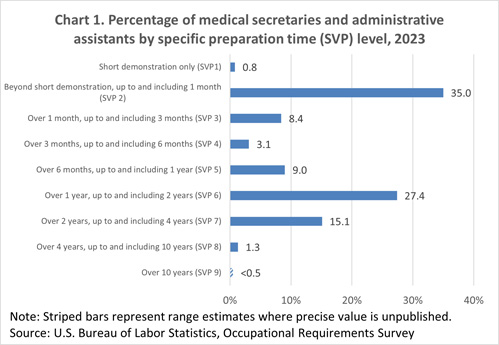
The various tangible or concrete hazards or difficulties that are in the vicinity of where jobs’ critical tasks are performed.
In 2023, greater than 99.5 percent of medical secretaries and administrative assistants were not exposed to extreme cold, and greater than 99.5 percent were not exposed to extreme heat. Wetness was not present for 90.7 percent, greater than 99.5 percent were not exposed to heavy vibrations, and greater than 95 percent were not exposed to the outdoors.
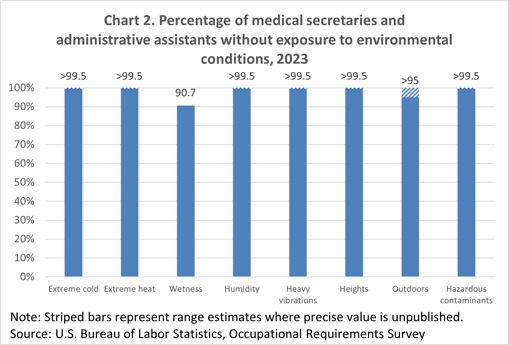
Refer to the physical activities required to perform tasks in jobs. The presence and, in some cases, duration of these activities are published.
In 2023, keyboarding was required for greater than 99.5 percent of medical secretaries and administrative assistants and was not required for less than 0.5 percent. For less than 0.5 percent of workers, keyboarding was seldom performed, for 23.7 percent keyboarding occurred occasionally, 71.9 percent frequently, and for 4.4 percent keyboarding occurred constantly.
Performing work in low postures was required for 16.9 percent of medical secretaries and administrative assistants and was not required for 83.1 percent.
The choice to sit or stand when performing critical tasks was available to 79.8 percent of medical secretaries and administrative assistants. On average, workers spent 86.1 percent of the workday sitting and 13.9 percent of the workday standing.
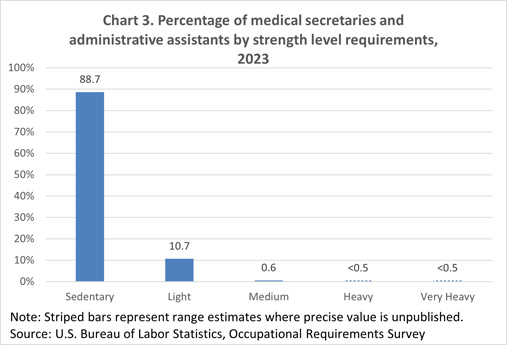
| Requirement | Yes | No |
|---|---|---|
|
Choice of sitting or standing |
79.8 | 20.2 |
|
Driving |
2.5 | 97.5 |
|
Climbing structure-related ramps or stairs |
4.6 | 95.4 |
|
Source: U.S. Bureau of Labor Statistics, Occupational Requirements Survey |
||

Perform routine clerical and administrative functions such as drafting correspondence, scheduling appointments, organizing and maintaining paper and electronic files, or providing information to callers.
The qualifications that workers need to use judgment, make decisions, interact with others, and adapt to changes in jobs.
In 2023, verbal interactions were required constantly (every few minutes) for 24.3 percent of secretaries and administrative assistants, except legal, medical, and executive, and were required not constantly, but more than once per hour for 68.1 percent.
| Requirement | Yes | No |
|---|---|---|
|
Pace: Pause control |
84.5 | 15.5 |
|
Interaction with general public |
96.0 | 4.0 |
|
Working around crowds |
0.6 | 99.4 |
|
Telework |
8.1 | 91.9 |
|
Work review: Supervising others |
3.4 | 96.6 |
|
Work review: Presence of supervisor |
79.3 | 20.7 |
|
Source: U.S. Bureau of Labor Statistics, Occupational Requirements Survey |
||
The minimum level of formal education required, credentials necessary, on-the-job training, and prior work experience necessary for average performance in jobs.
In 2023, credentials were required for 11.6 percent of secretaries and administrative assistants, except legal, medical, and executive. Prior work experience was required for 69.1 percent and on-the-job training was required for 84.3 percent.
A high school diploma was required for 81.9 percent of secretaries and administrative assistants, except legal, medical, and executive.
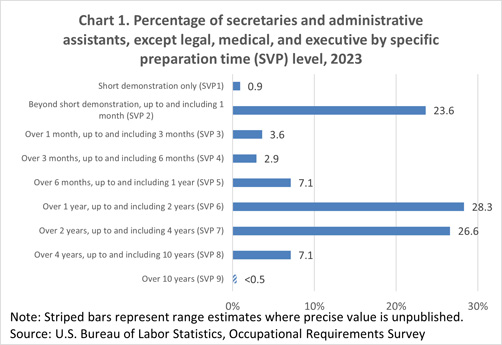
The various tangible or concrete hazards or difficulties that are in the vicinity of where jobs’ critical tasks are performed.
In 2023, greater than 99.5 percent of secretaries and administrative assistants, except legal, medical, and executive were not exposed to extreme cold, and greater than 99.5 percent were not exposed to extreme heat. Wetness was not present for 99.2 percent, greater than 99.5 percent were not exposed to heavy vibrations, and 95.5 percent were not exposed to the outdoors.
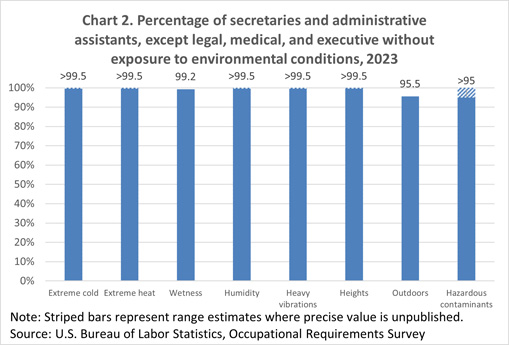
Refer to the physical activities required to perform tasks in jobs. The presence and, in some cases, duration of these activities are published.
In 2023, keyboarding was required for greater than 99.5 percent of secretaries and administrative assistants, except legal, medical, and executive and was not required for less than 0.5 percent. For less than 0.5 percent of workers, keyboarding was seldom performed, for 27.0 percent keyboarding occurred occasionally, 70.0 percent frequently, and for 2.7 percent keyboarding occurred constantly.
Performing work in low postures was required for 19.4 percent of secretaries and administrative assistants, except legal, medical, and executive and was not required for 80.6 percent.
The choice to sit or stand when performing critical tasks was available to 94.1 percent of secretaries and administrative assistants, except legal, medical, and executive. On average, workers spent 86.6 percent of the workday sitting and 13.4 percent of the workday standing.
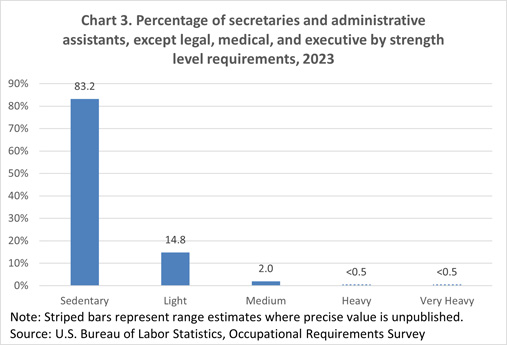
| Requirement | Yes | No |
|---|---|---|
|
Choice of sitting or standing |
94.1 | 5.9 |
|
Driving |
10.2 | 89.8 |
|
Climbing structure-related ramps or stairs |
9.7 | 90.3 |
|
Source: U.S. Bureau of Labor Statistics, Occupational Requirements Survey |
||

This occupational group includes animal care and service workers, entertainment attendants, funeral service workers, personal appearance workers, baggage portages, bellhops, and concierges, tour and travel guides, childcare workers, personal care aides, recreation and fitness workers, and residential advisors.
The qualifications that workers need to use judgment, make decisions, interact with others, and adapt to changes in jobs.
In 2023, verbal interactions were required constantly (every few minutes) for 54.1 percent of personal care and service workers, and were required not constantly, but more than once per hour for 39.8 percent.
| Requirement | Yes | No |
|---|---|---|
|
Pace: Pause control |
35.0 | 65.0 |
|
Interaction with general public |
98.6 | 1.4 |
|
Working around crowds |
9.5 | 90.5 |
|
Telework |
0.6 | 99.4 |
|
Work review: Supervising others |
11.4 | 88.6 |
|
Work review: Presence of supervisor |
65.3 | 34.7 |
|
Source: U.S. Bureau of Labor Statistics, Occupational Requirements Survey |
||
The minimum level of formal education required, credentials necessary, on-the-job training, and prior work experience necessary for average performance in jobs.
In 2023, credentials were required for 50.4 percent of personal care and service workers. Prior work experience was required for 26.4 percent and on-the-job training was required for 87.4 percent.
No minimum education was required for 32.0 percent of personal care and service workers and a high school diploma was required for 60.7 percent.
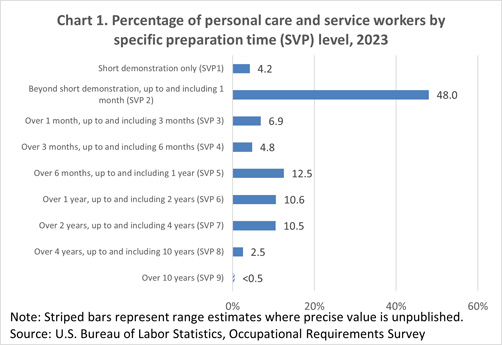
The various tangible or concrete hazards or difficulties that are in the vicinity of where jobs’ critical tasks are performed.
In 2023, greater than 99.5 percent of personal care and service workers were not exposed to extreme cold, and 98.9 percent were not exposed to extreme heat. Wetness was not present for 38.2 percent, greater than 99.5 percent were not exposed to heavy vibrations, and 48.5 percent were not exposed to the outdoors.
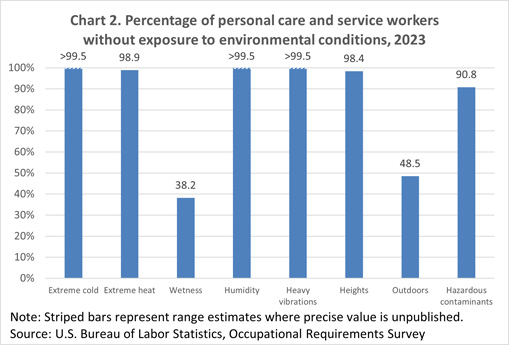
Refer to the physical activities required to perform tasks in jobs. The presence and, in some cases, duration of these activities are published.
In 2023, reaching at or below the shoulder was required for 90.2 percent of personal care and service workers and was not required for 9.8 percent. For 11.1 percent of workers, reaching at or below the shoulder was seldom performed, for 60.9 percent reaching at or below the shoulder occurred occasionally, 16.1 percent frequently, and for 2.1 percent reaching at or below the shoulder occurred constantly.
Performing work in low postures was required for 71.8 percent of personal care and service workers and was not required for 28.2 percent.
The choice to sit or stand when performing critical tasks was available to 21.5 percent of personal care and service workers. On average, workers spent 24.3 percent of the workday sitting and 75.7 percent of the workday standing.
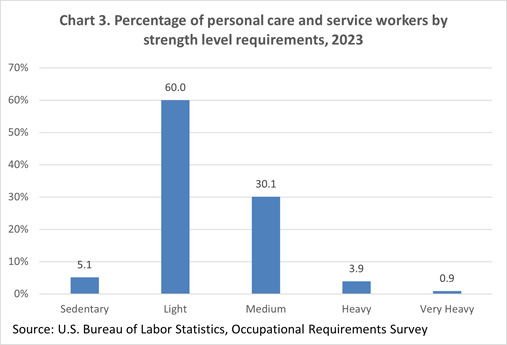
| Requirement | Yes | No |
|---|---|---|
|
Choice of sitting or standing |
21.5 | 78.5 |
|
Driving |
13.4 | 86.6 |
|
Climbing structure-related ramps or stairs |
19.8 | 80.2 |
|
Source: U.S. Bureau of Labor Statistics, Occupational Requirements Survey |
||

Feed, water, groom, bathe, exercise, or otherwise provide care to promote and maintain the well-being of pets and other animals that are not raised for consumption, such as dogs, cats, race horses, ornamental fish or birds, zoo animals, and mice. Work in settings such as kennels, animal shelters, zoos, circuses, and aquariums. May keep records of feedings, treatments, and animals received or discharged. May clean, disinfect, and repair cages, pens, or fish tanks.
The qualifications that workers need to use judgment, make decisions, interact with others, and adapt to changes in jobs.
In 2023, more than basic people skills were required for 20.5 percent of animal caretakers, and basic people skills were required for 79.5 percent.
| Requirement | Yes | No |
|---|---|---|
|
Pace: Pause control |
42.8 | 57.2 |
|
Interaction with general public |
89.3 | 10.7 |
|
Working around crowds |
<0.5 | >99.5 |
|
Telework |
<0.5 | >99.5 |
|
Work review: Supervising others |
0.6 | 99.4 |
|
Work review: Presence of supervisor |
91.4 | 8.6 |
|
Source: U.S. Bureau of Labor Statistics, Occupational Requirements Survey |
||
he minimum level of formal education required, credentials necessary, on-the-job training, and prior work experience necessary for average performance in jobs.
In 2023, credentials were required for 13.9 percent of animal caretakers. Prior work experience was required for 20.9 percent and on-the-job training was required for 96.2 percent.
No minimum education was required for 45.7 percent of animal caretakers and a high school diploma was required for 51.2 percent.
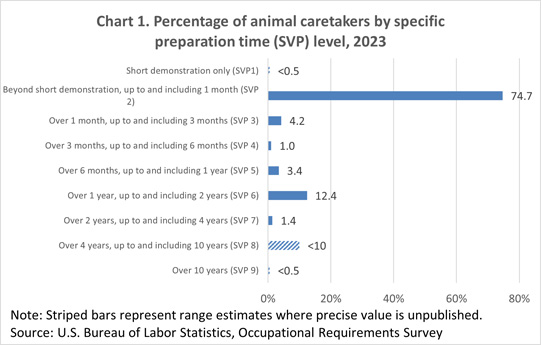
The various tangible or concrete hazards or difficulties that are in the vicinity of where jobs’ critical tasks are performed.
In 2023, greater than 99.5 percent of animal caretakers were not exposed to extreme cold, and greater than 99.5 percent were not exposed to extreme heat. Wetness was not present for less than 0.5 percent, greater than 99.5 percent were not exposed to heavy vibrations, and 61.3 percent were not exposed to the outdoors.
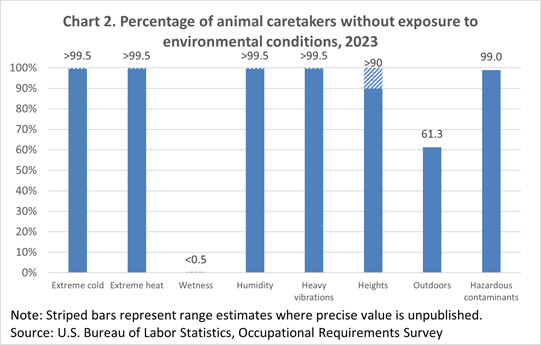
Refer to the physical activities required to perform tasks in jobs. The presence and, in some cases, duration of these activities are published.
In 2023, reaching at or below the shoulder was required for 99.0 percent of animal caretakers and was not required for 1.0 percent.
Performing work in low postures was required for greater than 90 percent of animal caretakers and was not required for less than 10 percent.
The choice to sit or stand when performing critical tasks was available to 9.8 percent of animal caretakers. On average, workers spent 5.4 percent of the workday sitting and 94.6 percent of the workday standing.
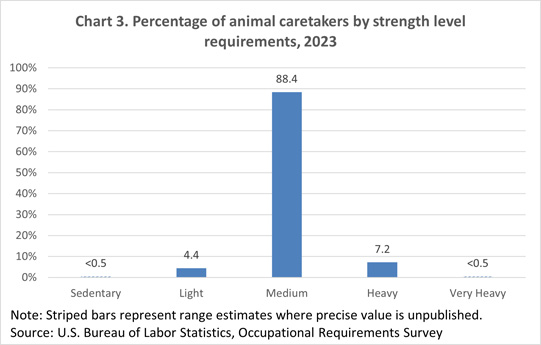
| Requirement | Yes | No |
|---|---|---|
|
Choice of sitting or standing |
9.8 | 90.2 |
|
Driving |
10.4 | 89.6 |
|
Climbing structure-related ramps or stairs |
6.4 | 93.6 |
|
Source: U.S. Bureau of Labor Statistics, Occupational Requirements Survey |
||

This occupational group includes engine assemblers, structural metal fabricators and fitters, bakers, butchers and meat cutters, meat packers, computer-controlled machine tool operators, forging machine setters, machinists, pourers and casters, tool and die makers, printing press operators, upholsters, furniture finishers, model maters, gas plant operators, tire builders, etchers, and engravers.
The qualifications that workers need to use judgment, make decisions, interact with others, and adapt to changes in jobs.
In 2023, more than basic people skills were required for 25.4 percent of production workers, and basic people skills were required for 74.6 percent.
| Requirement | Yes | No |
|---|---|---|
|
Pace: Pause control |
42.5 | 57.5 |
|
Interaction with general public |
16.8 | 83.2 |
|
Working around crowds |
<0.5 | >99.5 |
|
Telework |
<0.5 | >99.5 |
|
Work review: Supervising others |
11.7 | 88.3 |
|
Work review: Presence of supervisor |
84.9 | 15.1 |
|
Source: U.S. Bureau of Labor Statistics, Occupational Requirements Survey |
||
The minimum level of formal education required, credentials necessary, on-the-job training, and prior work experience necessary for average performance in jobs.
In 2023, credentials were required for 18.4 percent of production workers. Prior work experience was required for 46.3 percent and on-the-job training was required for 89.1 percent.
No minimum education was required for 39.2 percent of production workers and a high school diploma was required for 55.5 percent.
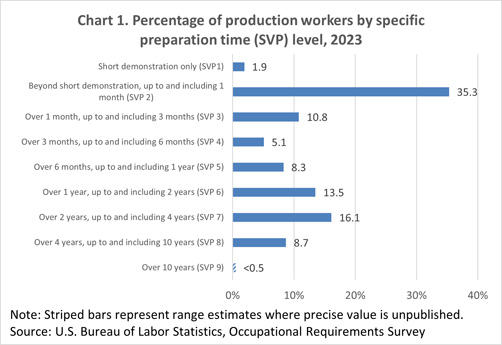
The various tangible or concrete hazards or difficulties that are in the vicinity of where jobs’ critical tasks are performed.
In 2023, 92.4 percent of production workers were not exposed to extreme cold, and 87.1 percent were not exposed to extreme heat. Wetness was not present for 70.3 percent, 97.0 percent were not exposed to heavy vibrations, and 88.6 percent were not exposed to the outdoors.
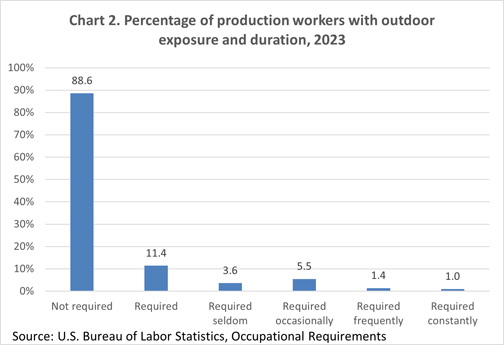
Refer to the physical activities required to perform tasks in jobs. The presence and, in some cases, duration of these activities are published.
In 2023, reaching at or below the shoulder was required for 86.2 percent of production workers and was not required for 13.8 percent.
Performing work in low postures was required for 67.1 percent of production workers and was not required for 32.9 percent.
The choice to sit or stand when performing critical tasks was available to 16.6 percent of production workers. On average, workers spent 18.8 percent of the workday sitting and 81.2 percent of the workday standing.
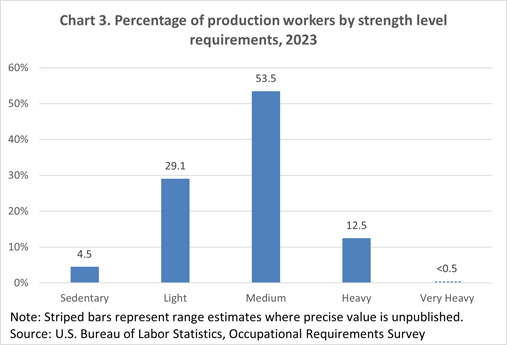
| Requirement | Yes | No |
|---|---|---|
|
Choice of sitting or standing |
16.6 | 83.4 |
|
Driving |
13.5 | 86.5 |
|
Climbing structure-related ramps or stairs |
18.3 | 81.7 |
|
Source: U.S. Bureau of Labor Statistics, Occupational Requirements Survey |
||

Cut, trim, or prepare consumer-sized portions of meat for use or sale in retail establishments.
The qualifications that workers need to use judgment, make decisions, interact with others, and adapt to changes in jobs.
In 2023, more than basic people skills were required for 26.8 percent of butchers and meat cutters, and basic people skills were required for 73.2 percent.
| Requirement | Yes | No |
|---|---|---|
|
Pace: Pause control |
16.8 | 83.2 |
|
Interaction with general public |
96.4 | 3.6 |
|
Working around crowds |
<0.5 | >99.5 |
|
Telework |
<0.5 | >99.5 |
|
Work review: Supervising others |
5.0 | 95.0 |
|
Work review: Presence of supervisor |
84.1 | 15.9 |
|
Source: U.S. Bureau of Labor Statistics, Occupational Requirements Survey |
||
The minimum level of formal education required, credentials necessary, on-the-job training, and prior work experience necessary for average performance in jobs.
In 2023, credentials were required for 35.8 percent of butchers and meat cutters. Prior work experience was required for 61.3 percent.
No minimum education was required for 52.8 percent of butchers and meat cutters and a high school diploma was required for 47.2 percent.
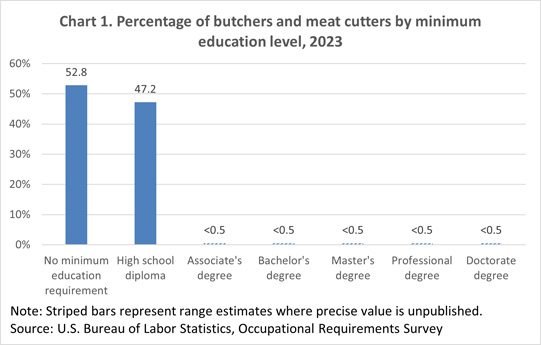
The various tangible or concrete hazards or difficulties that are in the vicinity of where jobs’ critical tasks are performed.
In 2023, 13.3 percent of butchers and meat cutters were not exposed to extreme cold, and 97.1 percent were not exposed to extreme heat. Wetness was not present for 9.3 percent, greater than 95 percent were not exposed to heavy vibrations, and 95.3 percent were not exposed to the outdoors.
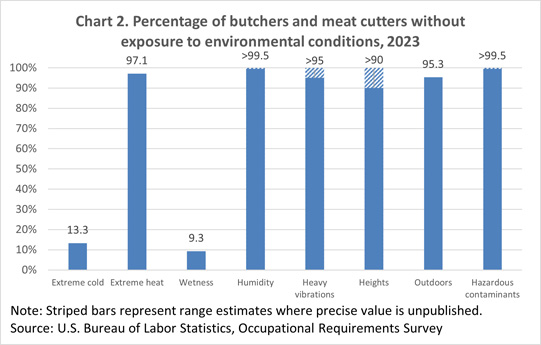
Refer to the physical activities required to perform tasks in jobs. The presence and, in some cases, duration of these activities are published.
In 2023, reaching at or below the shoulder was required for greater than 95 percent of butchers and meat cutters and was not required for less than 5 percent.
Performing work in low postures was required for 91.1 percent of butchers and meat cutters and was not required for 8.9 percent.
On average, butchers and meat cutters spent 99.7 percent of the workday standing.
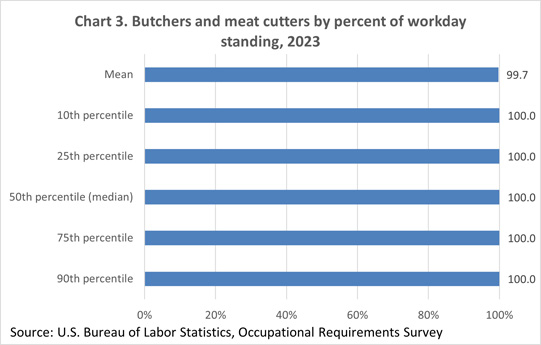
| Requirement | Yes | No |
|---|---|---|
|
Choice of sitting or standing |
<10 | >90 |
|
Driving |
<0.5 | >99.5 |
|
Climbing structure-related ramps or stairs |
<5 | >95 |
|
Source: U.S. Bureau of Labor Statistics, Occupational Requirements Survey |
||
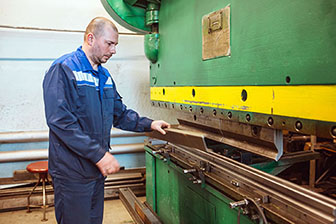
Set up, operate, or tend machines to saw, cut, shear, slit, punch, crimp, notch, bend, or straighten metal or plastic material.
The qualifications that workers need to use judgment, make decisions, interact with others, and adapt to changes in jobs.
In 2023, more than basic people skills were required for 14.6 percent of cutting, punching, and press machine setters, operators, and tenders, metal and plastic, and basic people skills were required for 85.4 percent.
| Requirement | Yes | No |
|---|---|---|
|
Pace: Pause control |
22.8 | 77.2 |
|
Interaction with general public |
<15 | >85 |
|
Working around crowds |
<0.5 | >99.5 |
|
Telework |
<0.5 | >99.5 |
|
Work review: Supervising others |
0.7 | 99.3 |
|
Work review: Presence of supervisor |
96.1 | 3.9 |
|
Source: U.S. Bureau of Labor Statistics, Occupational Requirements Survey |
||
The minimum level of formal education required, credentials necessary, on-the-job training, and prior work experience necessary for average performance in jobs.
In 2023, credentials were required for 14.1 percent of cutting, punching, and press machine setters, operators, and tenders, metal and plastic. Prior work experience was required for 33.7 percent and on-the-job training was required for 97.6 percent.
No minimum education was required for 44.5 percent of cutting, punching, and press machine setters, operators, and tenders, metal and plastic and a high school diploma was required for 55.5 percent.
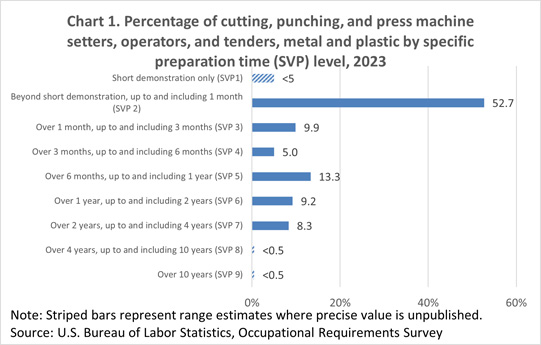
The various tangible or concrete hazards or difficulties that are in the vicinity of where jobs’ critical tasks are performed.
In 2023, greater than 99.5 percent of cutting, punching, and press machine setters, operators, and tenders, metal and plastic were not exposed to extreme cold, and 90.4 percent were not exposed to extreme heat. Wetness was not present for 81.1 percent, 97.4 percent were not exposed to heavy vibrations, and 94.6 percent were not exposed to the outdoors.
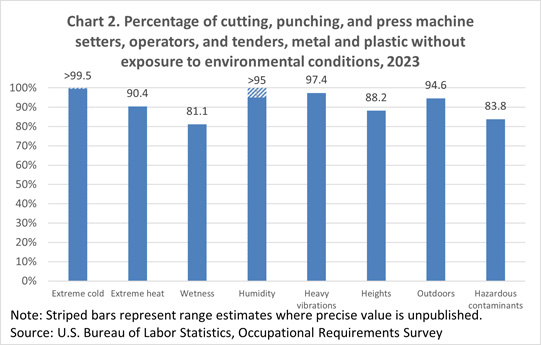
Refer to the physical activities required to perform tasks in jobs. The presence and, in some cases, duration of these activities are published.
In 2023, reaching at or below the shoulder was required for 84.9 percent of cutting, punching, and press machine setters, operators, and tenders, metal and plastic and was not required for 15.1 percent.
Performing work in low postures was required for 68.8 percent of cutting, punching, and press machine setters, operators, and tenders, metal and plastic and was not required for 31.2 percent.
On average, cutting, punching, and press machine setters, operators, and tenders, metal and plastic spent 11.7 percent of the workday sitting and 88.3 percent of the workday standing.
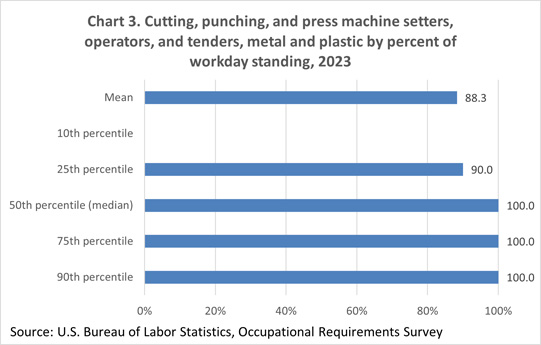
| Requirement | Yes | No |
|---|---|---|
|
Choice of sitting or standing |
<5 | >95 |
|
Driving |
25.9 | 74.1 |
|
Climbing structure-related ramps or stairs |
9.0 | 91.0 |
|
Source: U.S. Bureau of Labor Statistics, Occupational Requirements Survey |
||

This occupational group includes workers engaged in firefighting and fire prevention, law enforcement, and animal control, as well as private detectives and investigators, security guards, lifeguards, transportation security screeners, and crossing guards.
The qualifications that workers need to use judgment, make decisions, interact with others, and adapt to changes in jobs.
In 2023, more than basic people skills were required for 79.0 percent of protective service workers, and basic people skills were required for 21.0 percent.
| Requirement | Yes | No |
|---|---|---|
|
Pace: Pause control |
13.2 | 86.8 |
|
Interaction with general public |
98.8 | 1.2 |
|
Working around crowds |
40.6 | 59.4 |
|
Telework |
<0.5 | >99.5 |
|
Work review: Supervising others |
12.5 | 87.5 |
|
Work review: Presence of supervisor |
34.9 | 65.1 |
|
Source: U.S. Bureau of Labor Statistics, Occupational Requirements Survey |
||
The minimum level of formal education required, credentials necessary, on-the-job training, and prior work experience necessary for average performance in jobs.
In 2023, credentials were required for 89.4 percent of protective service workers. Prior work experience was required for 30.4 percent and on-the-job training was required for 75.9 percent.
A high school diploma was required for 82.3 percent of protective service workers.
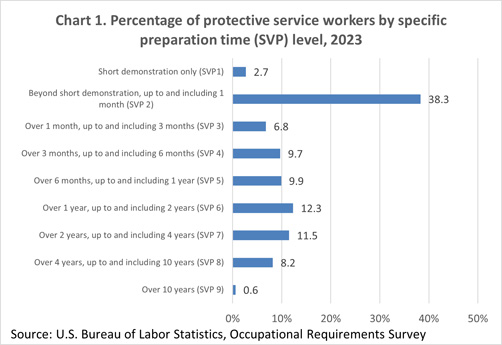
The various tangible or concrete hazards or difficulties that are in the vicinity of where jobs’ critical tasks are performed.
In 2023, a quiet noise exposure was present for 3.6 percent of protective service workers. Another 82.2 percent were exposed to moderate noise, 13.2 percent were exposed to loud noise, and 1.1 percent to very loud noise. Personal protective equipment (PPE) was used by 9.3 percent of workers to mitigate noise exposure, and was not used by 90.7 percent.
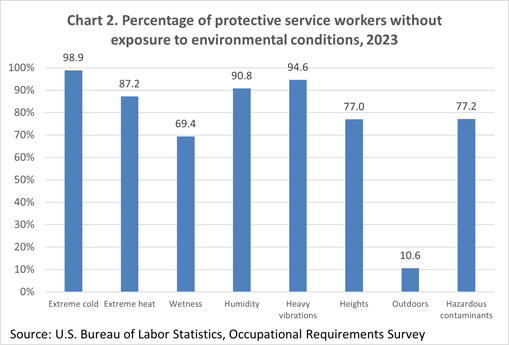
Refer to the physical activities required to perform tasks in jobs. The presence and, in some cases, duration of these activities are published.
In 2023, reaching at or below the shoulder was required for 85.5 percent of protective service workers and was not required for 14.5 percent.
Performing work in low postures was required for 73.4 percent of protective service workers and was not required for 26.6 percent. For 33.7 percent of workers, stooping was required to perform low work.
The choice to sit or stand when performing critical tasks was available to 9.2 percent of protective service workers. On average, workers spent 43.2 percent of the workday sitting and 56.8 percent of the workday standing.
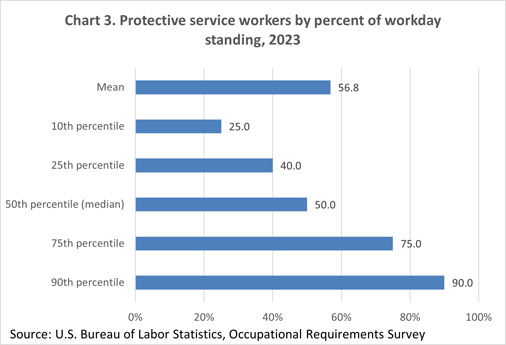
| Requirement | Yes | No |
|---|---|---|
|
Choice of sitting or standing |
9.2 | 90.8 |
|
Driving |
56.8 | 43.2 |
|
Climbing structure-related ramps or stairs |
70.7 | 29.3 |
|
Source: U.S. Bureau of Labor Statistics, Occupational Requirements Survey |
||

Guard, patrol, or monitor premises to prevent theft, violence, or infractions of rules. May operate x-ray and metal detector equipment.
The qualifications that workers need to use judgment, make decisions, interact with others, and adapt to changes in jobs.
In 2023, work was reviewed by a supervisor more than once per day for 53.6 percent of security guards, and once per day for 31.5 percent.
| Requirement | Yes | No |
|---|---|---|
|
Pace: Pause control |
10.2 | 89.8 |
|
Interaction with general public |
>99.5 | <0.5 |
|
Working around crowds |
30.3 | 69.7 |
|
Telework |
<0.5 | >99.5 |
|
Work review: Supervising others |
0.6 | 99.4 |
|
Work review: Presence of supervisor |
28.0 | 72.0 |
|
Source: U.S. Bureau of Labor Statistics, Occupational Requirements Survey |
||
The minimum level of formal education required, credentials necessary, on-the-job training, and prior work experience necessary for average performance in jobs.
In 2023, credentials were required for 85.5 percent of security guards. Prior work experience was required for 22.1 percent and on-the-job training was required for 97.1 percent.
A high school diploma was required for 94.9 percent of security guards.
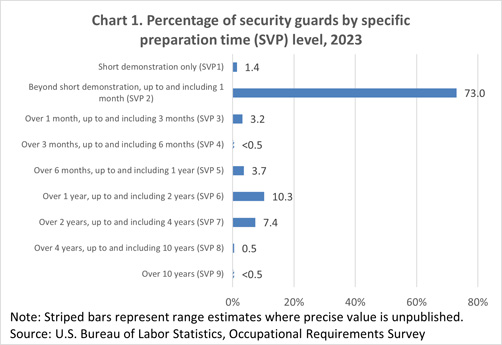
The various tangible or concrete hazards or difficulties that are in the vicinity of where jobs’ critical tasks are performed.
In 2023, greater than 99.5 percent of security guards were not exposed to extreme cold, and greater than 99.5 percent were not exposed to extreme heat. Wetness was not present for 99.4 percent, greater than 95 percent were not exposed to heavy vibrations, and 9.6 percent were not exposed to the outdoors.
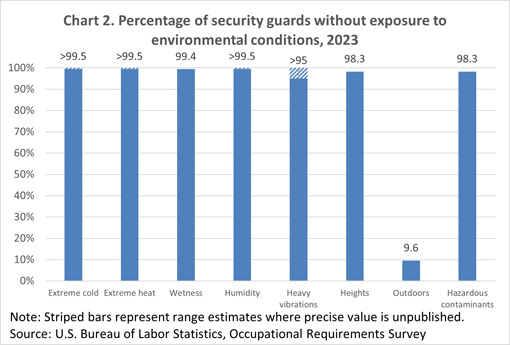
Refer to the physical activities required to perform tasks in jobs. The presence and, in some cases, duration of these activities are published.
In 2023, keyboarding was required for 77.8 percent of security guards and was not required for 22.2 percent. For 36.8 percent of workers, keyboarding was seldom performed, for 38.7 percent keyboarding occurred occasionally, 2.3 percent frequently, and for less than 0.5 percent keyboarding occurred constantly.
Performing work in low postures was required for 49.2 percent of security guards and was not required for 50.8 percent.
The choice to sit or stand when performing critical tasks was available to 7.5 percent of security guards. On average, workers spent 41.7 percent of the workday sitting and 58.3 percent of the workday standing.
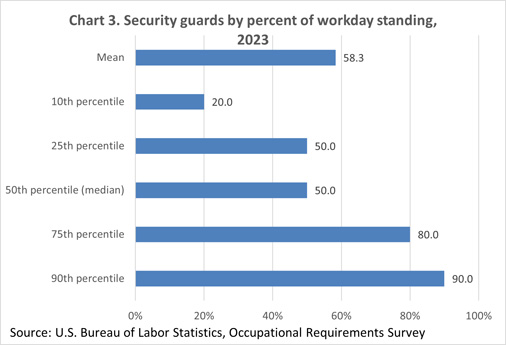
| Requirement | Yes | No |
|---|---|---|
|
Choice of sitting or standing |
7.5 | 92.5 |
|
Driving |
38.0 | 62.0 |
|
Climbing structure-related ramps or stairs |
73.5 | 26.5 |
|
Source: U.S. Bureau of Labor Statistics, Occupational Requirements Survey |
||

Receive and disburse money in establishments other than financial institutions. May use electronic scanners, cash registers, or related equipment. May process credit or debit card transactions and validate checks.
The qualifications that workers need to use judgment, make decisions, interact with others, and adapt to changes in jobs.
In 2023, more than basic people skills were required for 10.6 percent of cashiers, and basic people skills were required for 89.4 percent.
| Requirement | Yes | No |
|---|---|---|
|
Pace: Pause control |
4.4 | 95.6 |
|
Interaction with general public |
>99.5 | <0.5 |
|
Working around crowds |
0.7 | 99.3 |
|
Telework |
<0.5 | >99.5 |
|
Work review: Supervising others |
2.6 | 97.4 |
|
Work review: Presence of supervisor |
90.9 | 9.1 |
|
Source: U.S. Bureau of Labor Statistics, Occupational Requirements Survey |
||
The minimum level of formal education required, credentials necessary, on-the-job training, and prior work experience necessary for average performance in jobs.
In 2023, credentials were required for 5.7 percent of cashiers. Prior work experience was required for 4.3 percent and on-the-job training was required for greater than 99.5 percent.
No minimum education was required for 84.6 percent of cashiers.
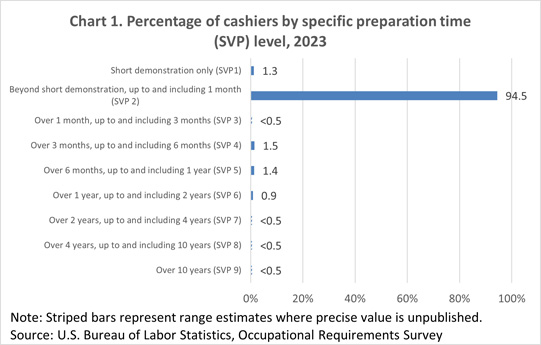
The various tangible or concrete hazards or difficulties that are in the vicinity of where jobs’ critical tasks are performed.
In 2023, 92.3 percent of cashiers were not exposed to extreme cold, and 99.2 percent were not exposed to extreme heat. Wetness was not present for 51.1 percent, greater than 99.5 percent were not exposed to heavy vibrations, and 76.9 percent were not exposed to the outdoors.
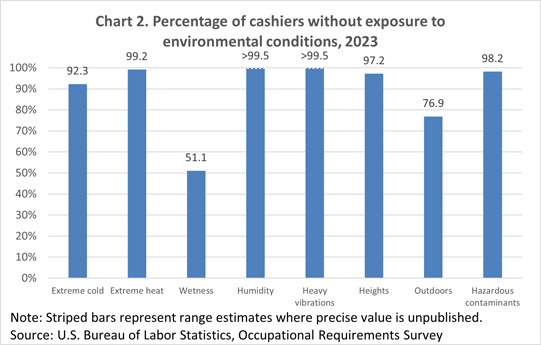
Refer to the physical activities required to perform tasks in jobs. The presence and, in some cases, duration of these activities are published.
In 2023, reaching at or below the shoulder was required for 97.7 percent of cashiers and was not required for 2.3 percent.
Performing work in low postures was required for 73.8 percent of cashiers and was not required for 26.2 percent.
The choice to sit or stand when performing critical tasks was available to 4.4 percent of cashiers. On average, workers spent 5.8 percent of the workday sitting and 94.2 percent of the workday standing.
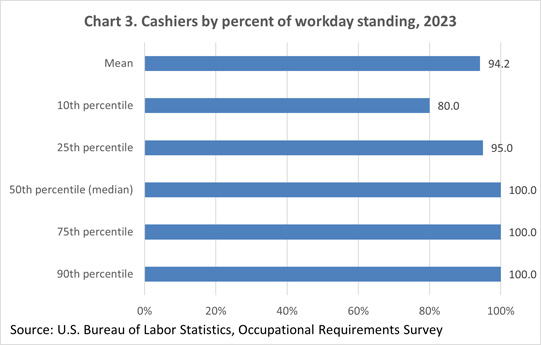
| Requirement | Yes | No |
|---|---|---|
|
Choice of sitting or standing |
4.4 | 95.6 |
|
Driving |
0.7 | 99.3 |
|
Climbing structure-related ramps or stairs |
1.8 | 98.2 |
|
Source: U.S. Bureau of Labor Statistics, Occupational Requirements Survey |
||

Sell merchandise, such as furniture, motor vehicles, appliances, or apparel to consumers.
The qualifications that workers need to use judgment, make decisions, interact with others, and adapt to changes in jobs.
In 2023, work was reviewed by a supervisor more than once per day for 53.8 percent of retail salespersons, and once per day for 26.8 percent.
| Requirement | Yes | No |
|---|---|---|
|
Pace: Pause control |
35.9 | 64.1 |
|
Interaction with general public |
>99.5 | <0.5 |
|
Working around crowds |
3.1 | 96.9 |
|
Telework |
0.5 | 99.5 |
|
Work review: Supervising others |
1.8 | 98.2 |
|
Work review: Presence of supervisor |
84.2 | 15.8 |
|
Source: U.S. Bureau of Labor Statistics, Occupational Requirements Survey |
||
The minimum level of formal education required, credentials necessary, on-the-job training, and prior work experience necessary for average performance in jobs.
In 2023, credentials were required for 15.2 percent of retail salespersons. Prior work experience was required for 16.0 percent and on-the-job training was required for 96.6 percent.
No minimum education was required for 67.9 percent of retail salespersons and a high school diploma was required for 31.9 percent.
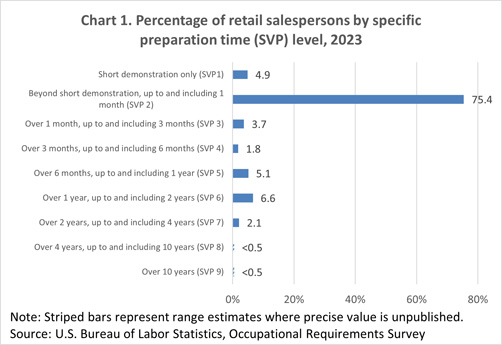
The various tangible or concrete hazards or difficulties that are in the vicinity of where jobs’ critical tasks are performed.
In 2023, 99.3 percent of retail salespersons were not exposed to extreme cold, and greater than 99.5 percent were not exposed to extreme heat. Wetness was not present for 87.2 percent, greater than 99.5 percent were not exposed to heavy vibrations, and 66.3 percent were not exposed to the outdoors.
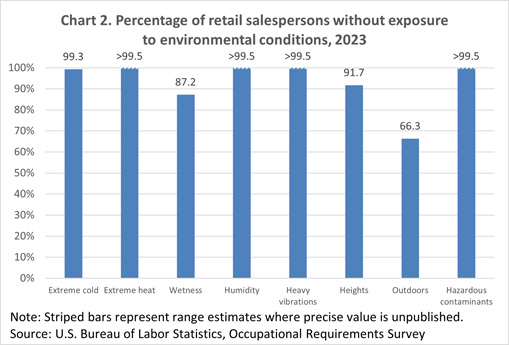
Refer to the physical activities required to perform tasks in jobs. The presence and, in some cases, duration of these activities are published.
In 2023, reaching at or below the shoulder was required for 92.5 percent of retail salespersons and was not required for 7.5 percent.
Performing work in low postures was required for 83.1 percent of retail salespersons and was not required for 16.9 percent.
The choice to sit or stand when performing critical tasks was available to 10.1 percent of retail salespersons. On average, workers spent 12.8 percent of the workday sitting and 87.2 percent of the workday standing.
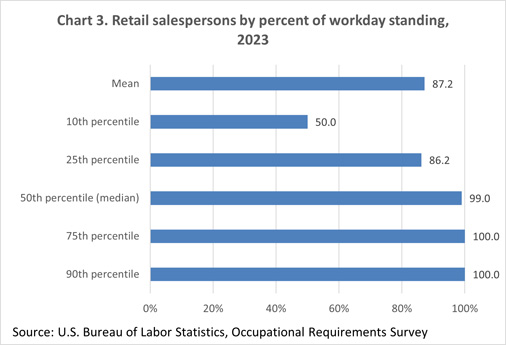
| Requirement | Yes | No |
|---|---|---|
|
Choice of sitting or standing |
10.1 | 89.9 |
|
Driving |
11.7 | 88.3 |
|
Climbing structure-related ramps or stairs |
7.5 | 92.5 |
|
Source: U.S. Bureau of Labor Statistics, Occupational Requirements Survey |
||

This occupational group includes airline pilots, flight attendants, bus drivers, taxi drivers, chauffeurs, locomotive engineers, railroad conducts, ship engineers, parking lot attendants, crane operators, recyclable material collectors, mine shuttle car operators, and ship loaders.
The qualifications that workers need to use judgment, make decisions, interact with others, and adapt to changes in jobs.
In 2023, more than basic people skills were required for 18.4 percent of transportation and material moving workers, and basic people skills were required for 81.6 percent.
| Requirement | Yes | No |
|---|---|---|
|
Pace: Pause control |
31.4 | 68.6 |
|
Interaction with general public |
62.6 | 37.4 |
|
Working around crowds |
2.4 | 97.6 |
|
Telework |
<0.5 | >99.5 |
|
Work review: Supervising others |
5.2 | 94.8 |
|
Work review: Presence of supervisor |
56.9 | 43.1 |
|
Source: U.S. Bureau of Labor Statistics, Occupational Requirements Survey |
||
The minimum level of formal education required, credentials necessary, on-the-job training, and prior work experience necessary for average performance in jobs.
In 2023, credentials were required for 58.6 percent of transportation and material moving workers. Prior work experience was required for 29.8 percent and on-the-job training was required for 89.2 percent.
No minimum education was required for 60.2 percent of transportation and material moving workers and a high school diploma was required for 39.2 percent.
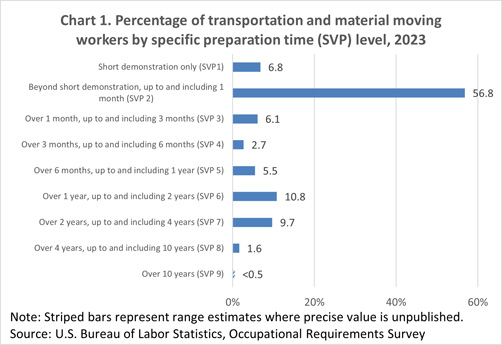
The various tangible or concrete hazards or difficulties that are in the vicinity of where jobs’ critical tasks are performed.
In 2023, 88.8 percent of transportation and material moving workers were not exposed to extreme cold, and 98.4 percent were not exposed to extreme heat. Wetness was not present for 79.5 percent, 99.2 percent were not exposed to heavy vibrations, and 42.4 percent were not exposed to the outdoors.
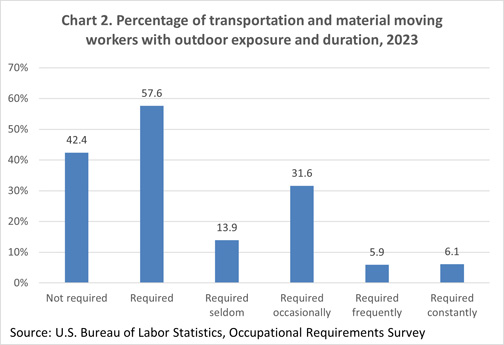
Refer to the physical activities required to perform tasks in jobs. The presence and, in some cases, duration of these activities are published.
In 2023, reaching at or below the shoulder was required for 93.2 percent of transportation and material moving workers and was not required for 6.8 percent.
Performing work in low postures was required for 83.4 percent of transportation and material moving workers and was not required for 16.6 percent.
The choice to sit or stand when performing critical tasks was available to 5.4 percent of transportation and material moving workers. On average, workers spent 34.8 percent of the workday sitting and 65.2 percent of the workday standing.
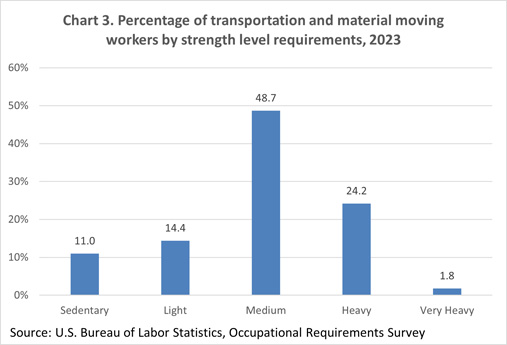
| Requirement | Yes | No |
|---|---|---|
|
Choice of sitting or standing |
5.4 | 94.6 |
|
Driving |
60.3 | 39.7 |
|
Climbing structure-related ramps or stairs |
22.2 | 77.8 |
|
Source: U.S. Bureau of Labor Statistics, Occupational Requirements Survey |
||
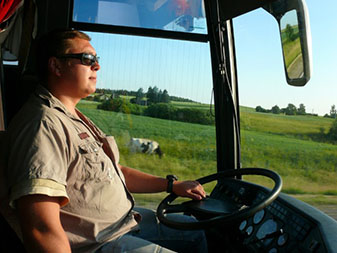
Drive a school bus to transport students. Ensure adherence to safety rules. May assist students in boarding or exiting.
The qualifications that workers need to use judgment, make decisions, interact with others, and adapt to changes in jobs.
In 2023, more than basic people skills were required for 19.1 percent of bus drivers, school, and basic people skills were required for 80.9 percent.
| Requirement | Yes | No |
|---|---|---|
|
Pace: Pause control |
<0.5 | >99.5 |
|
Interaction with general public |
96.6 | 3.4 |
|
Working around crowds |
2.8 | 97.2 |
|
Telework |
<0.5 | >99.5 |
|
Work review: Supervising others |
<0.5 | >99.5 |
|
Work review: Presence of supervisor |
<0.5 | >99.5 |
|
Source: U.S. Bureau of Labor Statistics, Occupational Requirements Survey |
||
The minimum level of formal education required, credentials necessary, on-the-job training, and prior work experience necessary for average performance in jobs.
In 2023, credentials were required for greater than 99.5 percent of bus drivers, school. Prior work experience was required for 6.2 percent and on-the-job training was required for 90.7 percent.
No minimum education was required for 37.7 percent of bus drivers, school and a high school diploma was required for 62.3 percent.
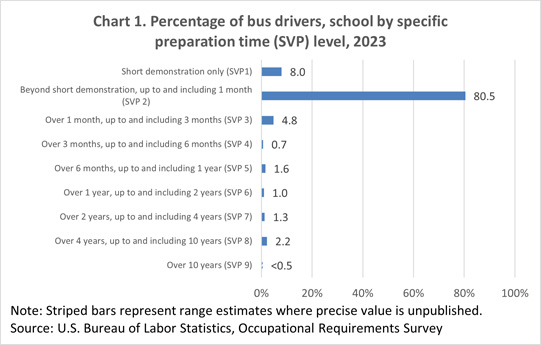
The various tangible or concrete hazards or difficulties that are in the vicinity of where jobs’ critical tasks are performed.
In 2023, greater than 99.5 percent of bus drivers, school were not exposed to extreme cold, and greater than 99.5 percent were not exposed to extreme heat. Wetness was not present for 82.8 percent, greater than 99.5 percent were not exposed to heavy vibrations, and 15.9 percent were not exposed to the outdoors.
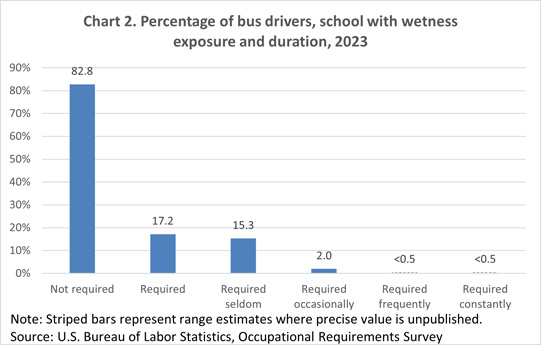
Refer to the physical activities required to perform tasks in jobs. The presence and, in some cases, duration of these activities are published.
In 2023, reaching at or below the shoulder was required for 92.1 percent of bus drivers, school and was not required for 7.9 percent.
Performing work in low postures was required for 75.8 percent of bus drivers, school and was not required for 24.2 percent.
On average, bus drivers, school spent 88.2 percent of the workday sitting and 11.8 percent of the workday standing.
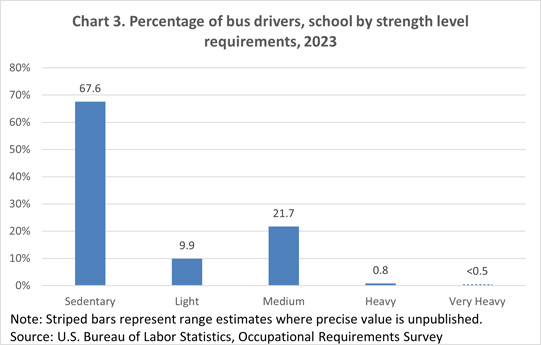
| Requirement | Yes | No |
|---|---|---|
|
Choice of sitting or standing |
<0.5 | >99.5 |
|
Driving |
>99.5 | <0.5 |
|
Climbing structure-related ramps or stairs |
16.9 | 83.1 |
|
Source: U.S. Bureau of Labor Statistics, Occupational Requirements Survey |
||
The Occupational Requirements Survey (ORS) is conducted by the U.S. Department of Labor, Bureau of Labor Statistics (BLS). The ORS is an establishment-based survey and provides job-related information about the physical demands; environmental conditions; education, training, and experience; as well as cognitive and mental requirements of jobs in the U.S. economy. Job requirements do not include modifications or adjustments to a job or change in the work environment that enables a person with a disability to compete equally or carry out the occupational critical tasks in support of the critical job functions.
Additional estimates for detailed occupations and occupational groups are available at www.bls.gov/ors/data.htm.
For information regarding the sample size see the technical note in the current News Release. The ORS Handbook of Methods provides information on the sample design.
To assist users in ascertaining the reliability of ORS estimates, standard errors are available for each estimate. For more information on standard errors see: www.bls.gov/ors/se.htm.
BLS uses the Standard Occupational Classification (SOC) system to code and publish occupations to the 6-digit level of detail. The occupational groups in this publication reflect the 2-digit aggregation of occupations as defined using the 2018 SOC. Military specific occupations (55-0000.00) are out of scope for the ORS.
The complete list of terms is available within the ORS collection manuals and ORS Handbook of Methods. The glossary below contains some major terms used in these occupational group profiles.